The 2019 European election: How anti-Europeans plan to wreck Europe and what can be done to stop it
Summary
- With anti-Europeans on their way to winning more than one-third of seats in the next European Parliament, the stakes in the May 2019 election are unusually high.
- While there are significant divides between them on substance, anti-European parties could align with one another tactically in support of a range of ideas: from abolishing sanctions on Russia to blocking the EU’s foreign trade agenda, to pulling the drawbridge up against migration. This would put at risk Europe’s capacity to defend its citizens from external threats at exactly the time when, given global turmoil, it needs to show more resolve, cooperation, and global leadership.
- This paper marks the start of ECFR’s campaign to strengthen Europe in the face of efforts by anti-European parties to divide it and make it weaker. We analyse, in detail, the political situation in each of the EU’s 27 member states ahead of the 2019 EP election.
- For supporters of an outward-looking Europe, we offer a strategy to fight back: by driving a wedge between anti-European parties, exposing the real-world costs of their key policy ideas, and identifying new issues that could inspire voters: from the rule of law and the environment to prosperity and Europe’s foreign policy goals.
- In the coming months, ECFR will explore these issues at a more granular level through quantitative and qualitative surveys across the EU27.
Introduction
Europeans have a growing litany of worries. With US President Donald Trump dismantling the fundamentals of the multilateral system and his Russian counterpart, Vladimir Putin, conducting a large-scale misinformation campaign designed to undermine European political systems, the European Parliament (EP) election scheduled for May 2019 might seem like a relatively minor concern. The EP is, after all, only one of the European Union’s governing bodies and, in many ways, the least powerful of them. In its legislative role, the institution cooperates with the Council of the EU (comprising national ministers from EU member states) and bases its work on proposals from the European Commission. And, despite having the ability to pass resolutions on a wide range of subjects, the EP has no formal role in foreign policy.
Unfortunately for beleaguered internationalist Europeans, the election really does matter. The vote could see a group of nationalist anti-European political parties that advocate a return to a “Europe of the nations” win a controlling share of seats in the EP. Among them number many figures who are strongly sceptical of free trade, in favour of pulling the drawbridge up against migration, and supportive of Moscow’s arguments about the need to flout international law in the Russian national interest in Ukraine. They are not currently a unified alliance but, in an EP in which their voices entered the mainstream, and in an EU in which transactional decision-making was commonplace, they could let all these ideas shape European policy in the medium term. And, in the longer term, their ability to paralyse decision-making at the centre of the EU would defuse pro-Europeans’ argument that the project is imperfect but capable of reform. At this point, the EU would be living on borrowed time.
Consequently, underestimating the importance of this election could have a very high cost for liberal internationalists across the EU. In the battle for EP seats, turnout will be critical in determining how anti-European forces fare. If nationalist parties marshal the clearest, loudest, arguments, and significant numbers of anti-Europeans turn out to vote, the views of Europe’s silent majority will be drowned out in the new parliament. The experience of the 2016 Brexit referendum shows the mobilising power of a rejection of the status quo in the current political climate. And, regardless of whether anti-European parties increase their share of EP seats, the battle of ideas that they are launching looks set to reshape Europe’s political landscape for years to come. In both contests, pro-European forces have the potential to repel the attack. But, to succeed, they cannot simply defend the status quo or engage in the polarised debate that the other side is currently shaping. In doing so, they risk fatally misunderstanding European popular sentiment and becoming an easy opponent for those who seek to undermine the project.
To understand the implications of the vote, ECFR conducted a study in the 27 member states that will go to the polls in May 2019. Our network of associate researchers in EU capitals interviewed political parties, policymakers, and policy experts, while analysing opinion polls, patterns in voter segmentation, and party manifestos. Even though Europe is still in the early stages of preparing for the election, it is already clear that this will be the most consequential parliamentary vote in the EU’s history.
ECFR has, therefore, set up the Unlock Europe’s Majority project to push back against the rise of anti-Europeanism that weakens Europe and its influence in the world, and to show how different parties and movements can – rather than competing in the nationalist or populist debate – effectively rally, knit together, and give the pro-European, internationally engaged majority in Europe a new voice. Over the coming weeks and months, ECFR will develop in-depth analysis informed by polling and focus group data about the various tribes and shifting coalitions in Europe that favour a more internationally engaged EU, as well as lay out what would be at stake with an EU in decline. ECFR will use this research to engage with pro-European parties, civil society allies, and media outlets on how to frame nationally relevant issues in a way that will reach across constituencies and reach the ears of voters who oppose an inward-looking, nationalist, and illiberal version of Europe.
No ordinary EP election
The first challenge pro-Europeans must understand if they are to succeed in the EP election is a mathematical one. Simply put, winning a certain number of seats will give anti-European forces influence over key processes and decisions. Judging by what many of them have campaigned for, anti-European parties could use this increased share of seats to obstruct the EP’s work on foreign policy, eurozone reform, and freedom of movement, and could limit the EU’s capacity to preserve European values relating to liberty of expression, the rule of law, and civil rights.
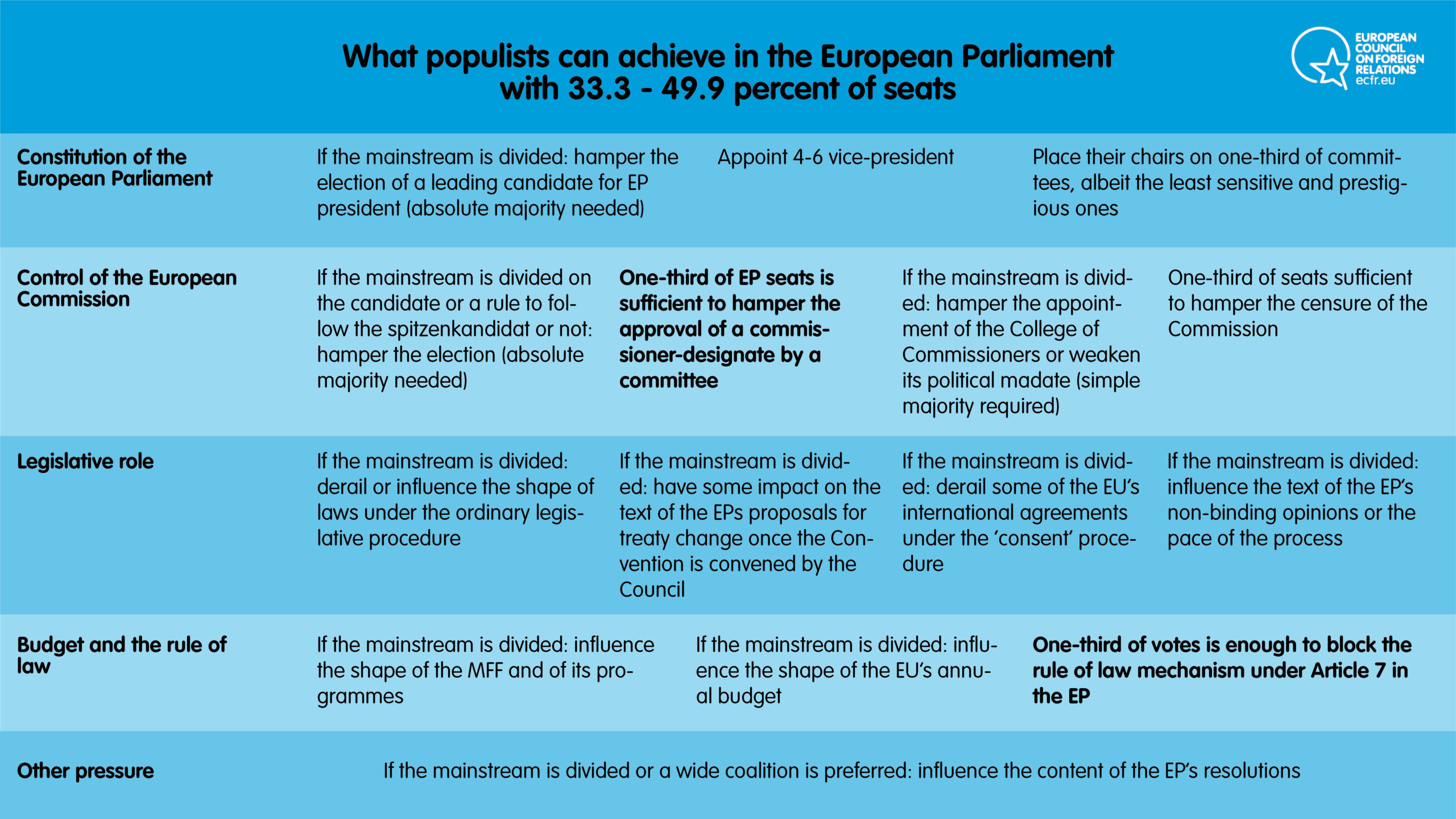
Winning more than 33 percent of seats would enable them to form a minority that could block some of the EU’s procedures and make the adoption of new legislation much more cumbersome – with a potentially damaging impact on the content of the EU’s foreign policy, as well as on the EU’s overall institutional readiness and its political credibility to take initiatives in the area. The table above outlines the possible procedural consequences of crossing this threshold.[1] Below, we explore in more detail the challenges for the EU’s foreign policy writ large.
Foreign trade
When the leader of Italy’s Five Star Movement, Luigi di Maio, criticises the EU’s external trade agenda – saying, “if so much as one Italian official continues to defend treaties like CETA, they will be removed” – he expresses a view shared by several of Europe’s anti-European parties on both the far left (La France Insoumise) and the far right (Rassemblement National). In the next parliament, trade could become a consensus issue on which they display an image of unity, challenge the mainstream’s capacity to seek wider compromises, and influence the EU’s policies.
The role of the EP in international trade agreements has continuously grown in recent years. The Lisbon Treaty gives the EP veto power over almost all trade and other international agreements, due to the consent procedure – which requires an absolute majority. (The procedure is also used for the accession of new EU member states and arrangements for withdrawal from the EU, as seen in the EP’s role in the Brexit process.) Thus, the EP can provide or deny consent for the conclusion of an agreement prior to authorisation by the Council of the EU.
The EP was quick to use its new powers, rejecting in February 2010 the initial version of the SWIFT agreement. It has also exercised a strong influence elsewhere – notably, in negotiations on free trade agreements with South Korea, Canada, and the United States (it is expected to play a vital role in a future trade agreement between the EU and the United Kingdom). The EU’s agreement with Singapore led to temporary uncertainty on the scope of the union’s exclusive competence on trade. Following the European Court of Justice’s Opinion 2/15, which distinguished between EU-only and mixed agreements, there is a widespread expectation that most of the EU’s upcoming trade agreements will now include only those elements that are within the EU’s exclusive competence, to avoid a lengthy ratification process in member states.
The threat of a parliamentary veto is enough to shape the EU’s trade policies. Therefore, controlling the majority of EP seats is crucial, as it can otherwise be difficult to gain the EP’s consent. According to VoteWatch, the balance of power on trade-related decisions is unlikely to change much in the next EP, mostly because several anti-European parties either do not oppose free trade outright (Alternative for Germany) or are among its most stable supporters (Law and Justice, or PiS). But, given the risk that they could seek tactical alliances, and the fact that the current mainstream in the EP – composed of the European People’s Party (EPP) and the Progressive Alliance of Socialists and Democrats (S&D) – will no longer have the absolute majority they need to adopt new international trade agreements, nationalists could significantly slow down the EU’s external trade agenda. This would curb the union’s ability to use trade as one of its major instruments for boosting prosperity in Europe and pursuing its foreign policy goals.[2]
The rule of law
One of the key procedural powers that flows from controlling at least 33 percent of EP seats is that to block the EU’s Article 7 mechanism, which is designed to defend the rule of law in member states. Currently, Article 7.1 procedures are open against the governments of Poland and Hungary. In September 2018, the EP voted by an overwhelming margin – 448 to 197, with 48 abstentions – that there was a “clear risk of a serious breach” of the EU’s values in Hungary. The matter then went to the Council, which, before making a determination about whether there is such a risk, must hear from the Hungarian government, make recommendations to it, and assess its response. In the case of Poland, the procedure was initiated by the Commission. But, in March 2018, the EP voted by a large majority – 422 to 147 – in favour of a non-binding resolution that supported the Commission’s decision to trigger Article 7 against Poland for undermining the independence of the judiciary, calling upon the Council to swiftly determine whether there is a “clear risk of a serious breach” of the EU’s values.
This shows the extent to which progress with the EU’s rule of law procedures depends on the support of both the EP and the Council – which is one of the reasons why the Article 7 mechanism is mostly an instrument of political pressure rather than anything that could realistically lead to the suspension of a member state’s voting rights. But that is exactly the point: with the EP unable to initiate rule of law investigations against member states, and with a rising number of member states in the Council represented by governments that are reluctant to support it either, the EU would have severe limits on its capacity to defend democracy within its borders. And such procedures could even be completely blocked if some anti-European parties successfully translate their gains at the EP election into a position in government at home (as seems possible in Denmark, Estonia, and Slovakia). Aside from its internal consequences, such a development would further erode Europe’s global credibility as a champion of democracy and the rule of law.
Migration
The EP has mostly non-legislative competences in migration policy – one of the issues on which anti-European parties focus. The EP has a consultation (rather than co-decision) role in this area. In those subject to the consultation procedure, the Council has to ask the EP for its opinion. It is not legally obliged to take the opinion into account. However, in line with the case law of the European Court of Justice, it must not take a decision without having received the EP’s opinion, which is decided by a majority vote. That said, the EP can make things difficult for the Council. Firstly, it can refuse to give an opinion – which prevents the Council and the Commission from proceeding. The EP can also delay proposals it does not support by referring them back to committees. Secondly, insofar as the Commission can amend the proposal until the moment of final agreement by the Council, the EP will often aim to exert pressure on the Commission to secure its agreement on amendments the EP supports.
Still, apart from providing opinions, the EP has been increasingly active in adopting non-binding resolutions on issues where it lacks a co-decision role – including most aspects of migration. For example, on 12 April 2016, the EP adopted a resolution on “the situation in the Mediterranean and the need for a holistic EU approach to migration”. Therefore, the major threat to the EU’s migration policies stemming from the 2019 EP election is that, with many more anti-immigrant MEPs present in the next parliament, their voices would become much stronger than they are today, which could limit the capacity of member states and the Council to seek a humanitarian and solidarity-based approach towards migration challenges – instead of securitising the issue. As on the rule of law and free trade, this would limit the EU’s credibility to contribute to the resolution of challenges in other regions of the world and at the global level.
Foreign policy
Despite its limited competences, the EP is increasingly active on foreign policy issues. The EP’s committee on foreign affairs has more members than other committees and is one of its most active. Between July 2014 and December 2017, it adopted 58 reports on its own initiative – almost twice as many as the economic and monetary affairs committee, the second most active one (although the latter adopted many more legislative reports and delegated acts).
Usually, the EP’s activity on foreign affairs takes the form of resolutions that are subject to majority voting. The importance of these resolutions varies depending on the issue or region in question. For example, they are closely followed by accession countries such as Montenegro. This is related to the EP’s “power of the purse”: it has a crucial voice on the allocation of accession funds to candidate countries. But EP’s resolutions on other issues – including China, the US, and Russia – are also important, as they are increasingly perceived as an expression of the EU’s foreign policy. This is why the EP must demonstrate as wide support as possible for any resolution it adopts.
Although they are non-binding, such resolutions are also one of the tools with which the EP can influence the EU’s foreign policy – through both the European External Action Service (EEAS) and the Council. Its other tools for this include budgetary pressure (given that the EP has to approve EEAS budgetary and staff changes) and regular hearings with the high representative for foreign affairs and security policy. Thus, even without holding many seats in the EP, nationalist parties can obstruct processes in this area. For example, given the usual insistence on looking for the widest possible support on the EP’s foreign policy resolutions, they could table a long list of amendments to either delay the process (after which they could still vote against the motion) or water down the final text – a tactic that members of the far-left European United Left/Nordic Green Left (GUE/NGL) group have sometimes used.
EU budget
The EP has a crucial role in shaping the EU’s Multiannual Financial Framework (MFF), in three respects. Firstly, while adopting a proposal from the Council formally requires only the EP’s consent, Article 312(5) of the Treaty on the Functioning of the European Union enables the EP to also participate in the negotiating process around the MFF. This requires the EP, the Council, and the Commission to take any measure necessary to facilitate the adoption of the MFF. The support of a majority of the EP’s component members is needed for the adoption of the MFF. Secondly, following the ordinary legislative procedure, the EP has a strong role in deciding what the MFF will allocate to various programmes and funds. And, finally, the EP needs to issue an opinion on the EU’s resources within the MFF. While this gives it a relatively limited role, the EP has so far presented these three elements as a single package, strengthening its role in MFF negotiations.
The EP also plays a key part in the allocation of expenses in the EU’s annual budget. The Lisbon Treaty eliminated the distinction between compulsory and non-compulsory expenditure, putting the EP on an equal footing with the Council in this. The EU’s annual budget is now subject to a form of the ordinary legislative procedure. The EP is involved in the budgetary process from the preparation stage, notably in laying down guidelines and determining types of spending.
Finally, the EP also makes extensive use of its budgetary powers elsewhere. For example, the EP has a de facto veto over the design of the EEAS, as it must approve the organisation’s budgetary and staff changes. In this way, the EP may have an impact on the priorities of the EU’s foreign policy. All in all, whoever controls the EP’s majority has significant budgetary tools at their disposal to shape the EU’s priorities, as well as its policies (by, for example, limiting the funds available to various areas of foreign and development policy).
Brexit, the EP election, and the end of the current MFF will come in quick succession in 2019 and 2020. This creates intense pressure to adopt the next MFF, together with the accompanying spending plans for various sectors, as soon as possible. But the EU seems unlikely to reach even a rough agreement on the next MFF before the election, meaning that MEPs from anti-European parties in the next parliament will be able to exert pressure on the size and shape of the EU’s next multiannual budget. Of course, these talks are always difficult, as they set net contributors and net beneficiaries against each other – as they do supporters of various elements of the budget, ranging from cohesion policy, agricultural funds, and research to migration, the eurozone, and defence and foreign policy. Nonetheless, an EP in which nationalists have a strengthened voice may only add an additional hurdle to an already complicated process – even if they pursue contradictory goals such as shrinking the budget, increasing cohesion funds, and defunding foreign policy and development projects. In this scenario, there is a heightened risk that the EU’s foreign policy will fall victim to cuts or compromises.
Appointment of the next Commission
The result of the May 2019 election will be instrumental to the composition of the next European Commission (the EU’s main executive body), including the president and the high representative for foreign affairs and security policy. Once the Council nominates a candidate for the president of the Commission (with a qualified majority), he or she will need to be approved by a majority of the EP’s component members – that is, at least 353 of 705 MEPs in the post-Brexit EP. If the candidate does not obtain the required majority, the president of the EP will invite the European Council to propose a new candidate, who would have to follow the same procedure. In 2014, a Spitzenkandidat was appointed for the first time, with the Council’s nomination of Jean-Claude Juncker (the leader of the winning EPP group) as candidate for the presidency of the Commission. This practice is meant to not just provide democratic legitimacy to the EU’s executive, but also to facilitate the EP’s approval of the nominee.
The next step is the election of the entire College of Commissioners. Here, the EP has a significant opportunity for disruption. The EP elects or rejects the College of Commissioners as a whole, in one vote, with a majority of votes cast. However, prior to this, the commissioners-designate appear for hearings before parliamentary committees in their prospective fields of responsibility. Each committee meets to produce an evaluation of the candidate’s expertise and performance, which is then sent to the president of the EP. The threshold for suspending the process of nominating a candidate is relatively low: more than one-third is enough to hamper the committee’s approval of a candidate. The candidate may still be elected as part of the entire College of Commissioners in a plenary vote. However, a negative evaluation has prompted previous candidates to withdraw from the process.
Although it is up to member states to propose commissioners-designate, the presence of anti-Europeans in several national governments poses a serious risk that the next European Commission will become less internationalist and principled on the main global issues Europe faces, such as free trade, human rights, the rule of law, and multilateralism. But the result of the 2019 EP election will also be decisive for whether and how the selection of the president of the European Commission will follow the Spitzenkandidat procedure. (For example, the appointment of the EPP’s Manfred Weber as the next president of the EP could mean various things depending on which political groups support him.) And it would have an impact on the chances for candidates with a relatively internationalist world view – such as the next high representative – to obtain a positive evaluation in committee. In short, the European Commission’s foreign policy outlook also depends on this election.
The spoils of cooperation
Anti-European parties’ capacity to obstruct the work of the EP in the ways described above will largely depend on whether they can coordinate their activities with one another – something that has never been one of their strengths. According to current polls, a variety of anti-European parties ranging from the far left to the far right, including right-wing Eurosceptics, are for the first time almost certain to acquire more than one-third of EP seats. More worryingly, the collective seat share of representatives from the far right and right-wing Eurosceptics will, if current polling is accurate, rise from 23 percent to 28 percent. They could even gain more than 30 percent of seats if their popularity continues to grow or if some of the fringe members of the mainstream join them. If they cross the one-third threshold, this would signify a qualitative change in the EU. ECFR’s calculations in this paper assume that the UK will not participate in the May 2019 election. However, as an extension to Article 50 negotiations seems a distinct possibility with the lack of clarity on the UK’s position, the participation of British MEPs in May 2019 could throw another spanner in the works.
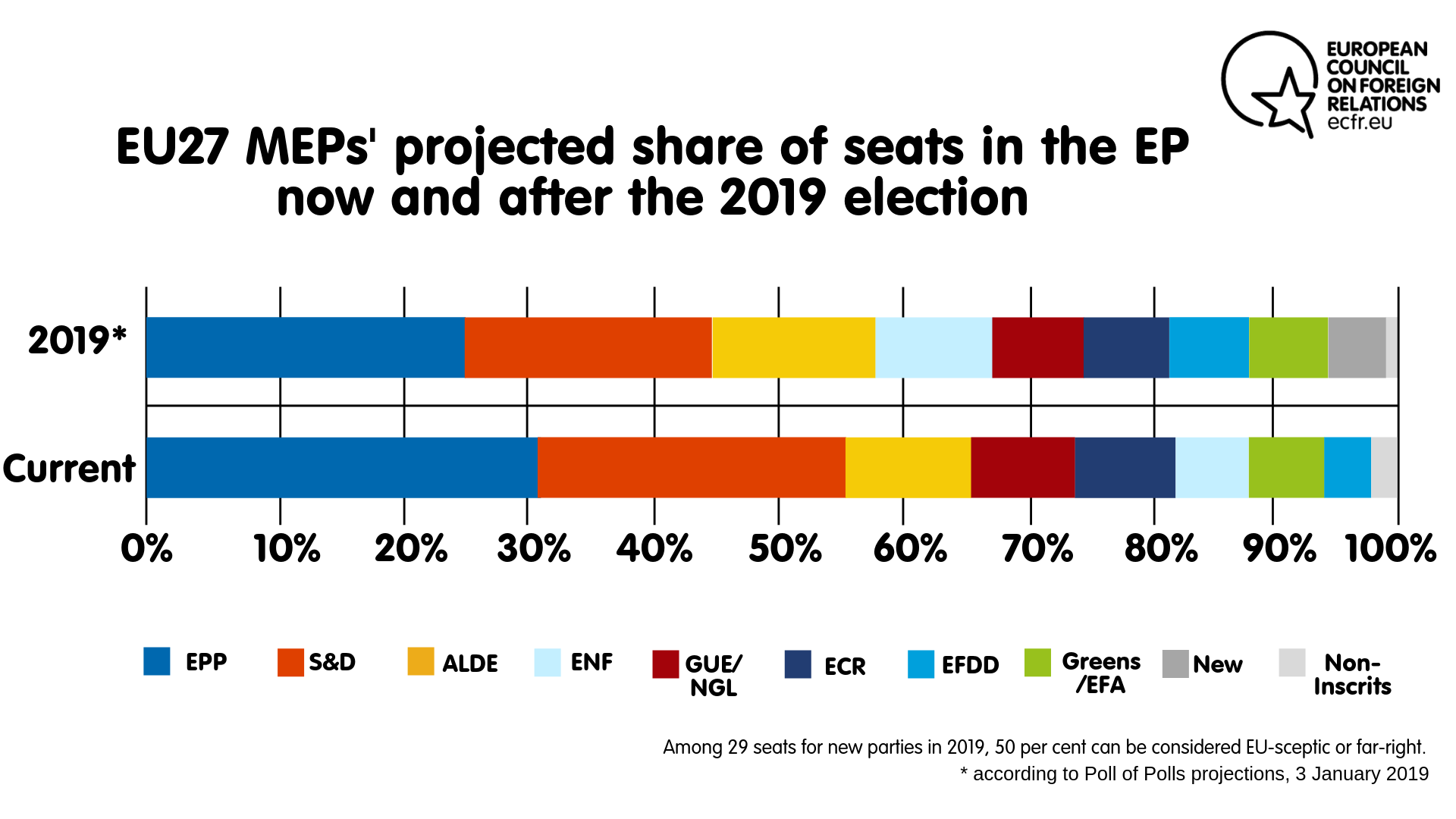
What types of cooperation between parties are possible? To start with, a die-hard anti-EU coalition of only the far right – including Rassemblement National leader Marine Le Pen and the UK’s Nigel Farage, as well as Greek and Hungarian nationalists – currently holds slightly more than 10 percent of EP seats. This share may rise to 19 percent next year, largely due to the expected success of Rassemblement National, Alternative for Germany, and Italy’s League (as well as that of the Five Star Movement, which may not align with the EP’s far right). Most far-right MEPs are affiliated with one of two political groups in the EP – Europe of Freedom and Direct Democracy (EFDD) and Europe of Nations and Freedom – or are non-aligned. So far, the far right has been divided, due to ideological and personal issues. These two political groups have demonstrated very weak internal cohesion relative to most others in parliament. And this lack of unity has often prevented the far right from affecting European processes (as has their reluctance to actively participate in the EP’s daily work). But this could change if they double their share of seats.
This core far-right group could also ally with MEPs from Eurosceptic parties on the right, particularly those in Scandinavia and central Europe. These parties include Poland’s PiS, the Sweden Democrats, and the Danish People’s Party – all of which are currently affiliated with the European Conservatives and Reformists (ECR) group in the EP – as well as Viktor Orbán’s Fidesz, which remains a member of the EPP.
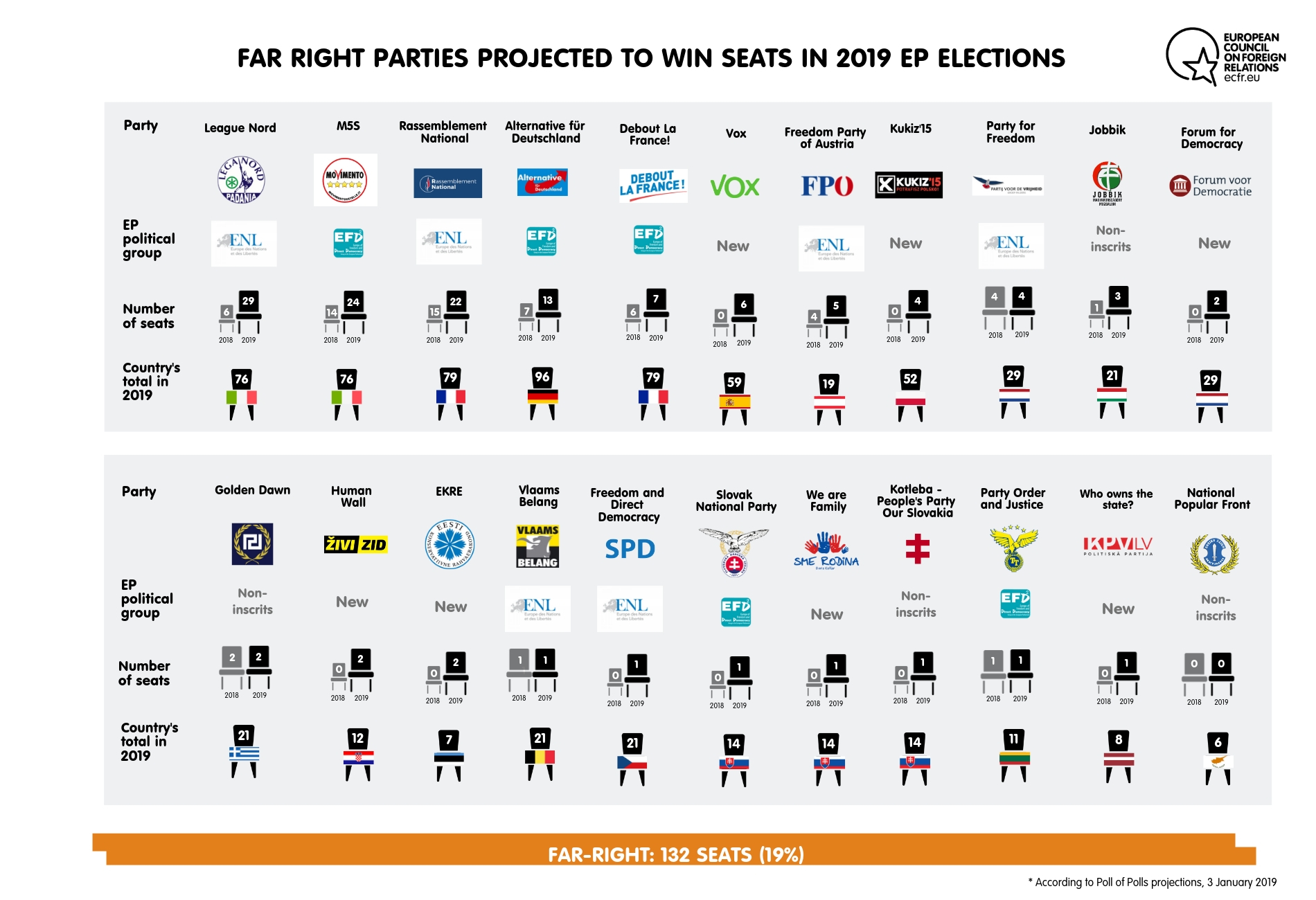
Members of a possible coalition of the far right and conservative Eurosceptics would find it relatively easy to cooperate with one another on the issues they care about most, particularly migration and the rule of law. They may disagree on some foreign policy issues: the pro-Russian stance of Le Pen and the League’s Matteo Salvini has discouraged PiS leader Jaroslaw Kaczynski from joining a unified sovereigntist block in the run-up to the EP election. But they may still put their differences aside to reach two shared tactical goals: curbing the EU’s liberal orientation and returning power to member states.
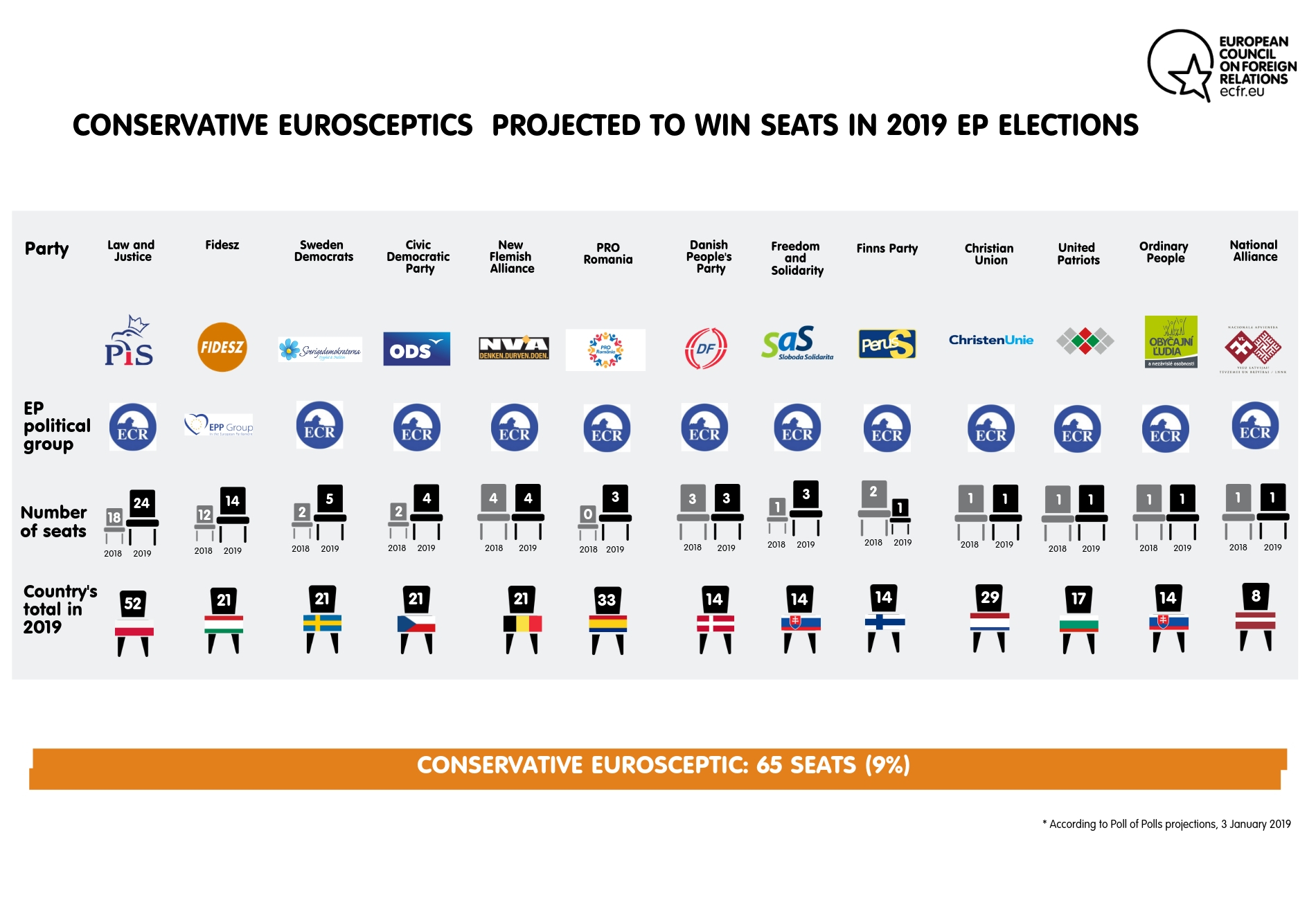
Europe’s right and far right could even formally establish a new political group, which would be the second-largest political family in the EP. In any case, the right and the far right will likely be forced to realign in 2019 due to the loss of British MEPs and to requirements for forming a parliamentary political group that the ECR and the EFDD may struggle to meet. Furthermore, it is unclear whether Fidesz will leave the EPP. As it stands, neither Orbán nor the EPP have an interest in announcing a divorce before May 2019. But, after the election, there is a high likelihood that the nationalist camp will become more unified.
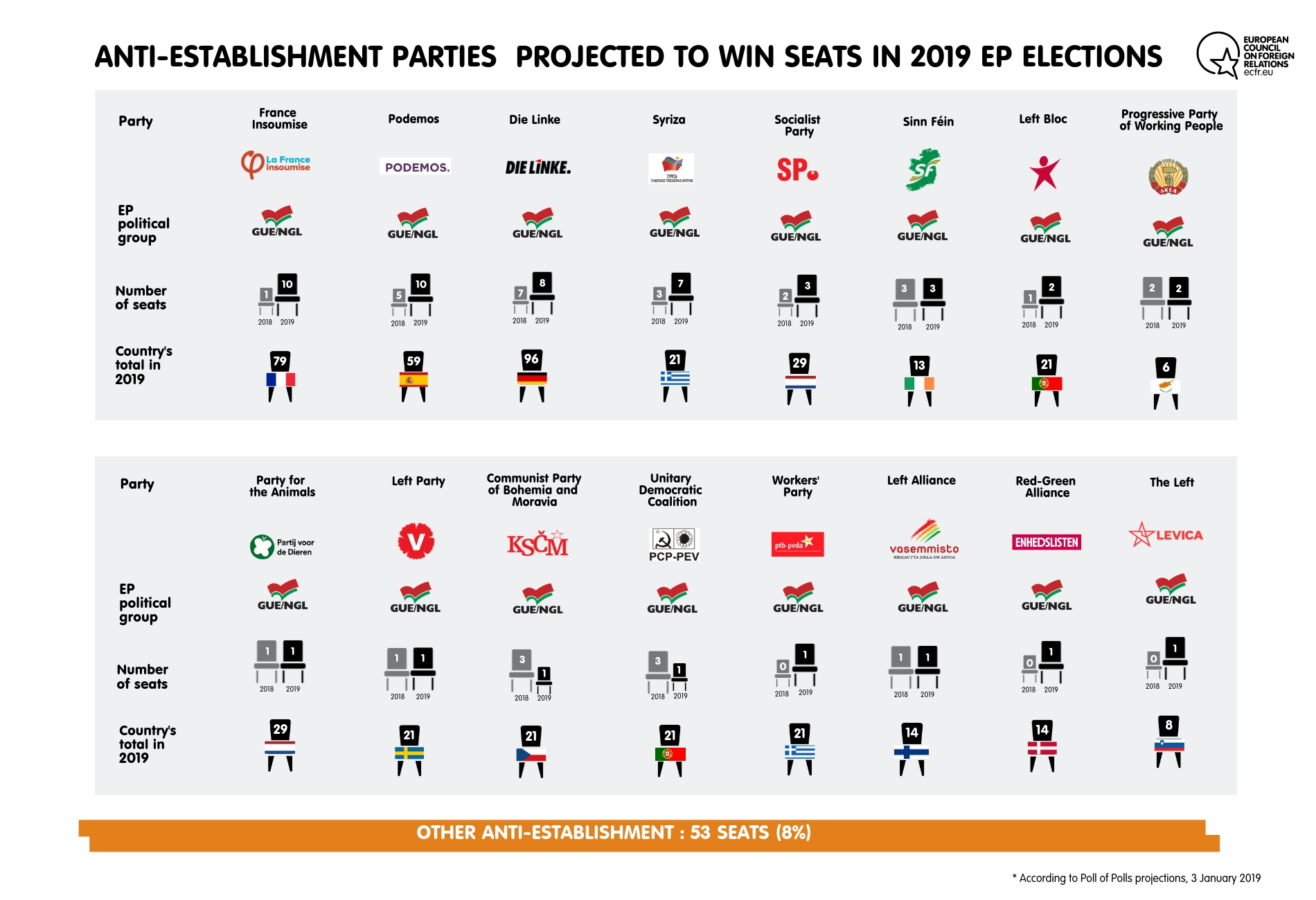
Finally, there is also a possibility of an “all against the establishment” alliance of the far right, Eurosceptics, and the far left. If parties such as Germany’s Die Linke and La France Insoumise joined the cause, this coalition could make life very difficult for pro-European forces given that, for the first time, they are almost certain to collectively win more than one-third of MEP seats.
The far right and the far left have worked together in the EP before, largely in areas where either the ECR voted with the mainstream (such as on Russia, the US, and trade) or the mainstream demonstrated significant internal discipline (such as on migration). Love of Russia, hatred of sanctions, and strong protectionist inclinations can unite the far left and the far right. Nonetheless, it is still more common for them to take different approaches. For example, in September 2018, most MEPs affiliated with the far-left GUE/NGL voted with the mainstream in favour of the Sargentini Report, which criticised Orbán’s government for undermining the rule of law in Hungary.
Therefore, opportunities for cooperation between the far right and the far left are limited and will vary from party to party. For example, Portugal’s Left Bloc may be critical of the EU in many ways, but it also aims to counter xenophobia and nationalism in Europe. Podemos and Syriza have been much more willing to cooperate with mainstream parties on European issues since they became part of their countries’ political establishments. In turn, La France Insoumise could play a different role: its leader, Jean-Luc Mélenchon, refused to tell his supporters not to vote for Le Pen in the second round of France’s 2017 presidential election.
In this context, a significant threat to the European project comes not so much from an “all against the establishment” alliance (especially given that the far left have few things in common with the Eurosceptic right), or from a stable alliance between the far left and the far right, but rather from unplanned alignment on key aspects of the EU’s agenda, or a readiness to cooperate on the two tactical goals discussed above. Whenever the far right, the far left, and the EU-sceptic right vote together, the mainstream will have a relatively slim margin of error, forcing it to be disciplined and to build coalitions around individual issues. In recent years, pro-Europeans across the political spectrum have rarely exercised such discipline.
The ideal opponent: where defenders of the European project are going wrong
But what would cooperation between anti-European parties in the EP mean in the real world? Politics across the EU – from the gilets jaunes (yellow vests) stand-off in France to the election of EU-sceptic governments in Hungary, Italy, and Poland – demonstrates that an increasing number of voters see no link between negotiations in the corridors of power and the issues they care about: jobs, security, and living standards. Can the threat that the election poses be brought to life?
Allowing anti-Europeans to frame the debate
Arguably, in a world where tweets can dictate policy and easy promises of change increasingly draw votes, the ideas that mobilise the anti-European camp can have a much simpler appeal than arguments for a united, internationally engaged Europe. Le Pen claimed in October 2018 that “we are not fighting against Europe, but against the EU, which has become a totalitarian system.” Together with Salvini and Orbán, she will harness the power of this kind of confrontational imagery to lead Europe’s nationalists. Regardless of whether they eventually receive logistical support from the Movement (a pan-European organisation created by former US presidential adviser Steven Bannon in anticipation of the 2019 EP election), they are already uniting behind three main beliefs: EU institutions have too much power, European citizens want governments to place a greater emphasis on security, and Europe requires tighter border controls.
However, it is the third belief – and the topic of migration more broadly – that is becoming the main focus of their campaign. According to Orbán, “the conventional division of parties into those of the right and of the left will be replaced with a division between those which are pro-immigration and those which are anti-immigration”. This framing enables anti-European parties, mostly those on the right, to strengthen their sense of internal unity and to reach out beyond the core anti-EU electorate. Therefore, it would be a mistake to assume that anti-Europeans will have no influence on the EU’s approach to migration just because they are disunited on the specifics of migration management policy. Indeed, the political fear that they have generated on migration in almost every EU member state in recent years – which has caused mainstream parties on the right and the left to advocate increasingly draconian approaches to migration management – testify to the power of this issue for them.
To date, the Movement has only rallied a handful of Europe’s 40 or so anti-EU parties to its cause. But its relentless focus on the core message and its targeted, well-funded media campaign appear to have lent it considerable momentum. The performance of the far-right Vox party in a regional election in Andalusia last year – in which it obtained 11 percent of votes and 12 out of 109 seats in the regional parliament, allowing it to join a regional coalition – provided the Movement with a significant success story. The organisation also benefits from the alignment of its objectives with those of the American alt-right and the Putin government, as well as a worldwide revolutionary zeitgeist evidenced by the latest presidential elections in the US and Brazil. Given the Russian interference in recent national elections in Europe, and the tension in EU-Russian relations arising from hostilities in the Sea of Azov in November 2018, it is highly likely that Moscow will attempt to manipulate the EP vote.
If the nationalists’ focus on migration is well chosen, this is because the issue not only resonates with voters but also demonstrates the divides within the much larger pro-European camp. It seems that most European voters would prefer to reduce immigration, but they differ on how, and to what extent, they should do so. This has prompted pro-European parties to deal with these voters as distinct camps. Not so the anti-Europeans. ECFR’s research confirms that in all EU member states except Portugal, Ireland, and Lithuania, migration will feature prominently in the debate on the May 2019 election. And there are signs that mainstream parties – mostly members of the centre-right EPP – are already conceding ground on migration. With Eurosceptic forces having taken them to task on the issue, moderate parties increasingly appear to view a relatively hard line on migration as the price they must pay to retain power.
This has been clear since the adoption – by a margin of 459 votes to 206, with 52 abstentions – of the resolution on “the situation in the Mediterranean and the need for a holistic EU approach to migration” in April 2016. Providing an overview of the EP’s main positions on asylum, the resolution passed thanks to the support of the EPP, the S&D, the Alliance of Liberals and Democrats for Europe (ALDE), and the Greens. However, the EPP’s internal cohesion was relatively low: 33 members of the grouping – including representatives of Hungary’s Fidesz and Romania’s National Liberal Party; several Czech, Slovak, and Latvian MEPs; and even one member of France’s Les Républicains – voted against the resolution. Within the S&D, four Czech social democrats rebelled. Even though the resolution was adopted, the episode demonstrated anti-immigration parties’ capacity to play on divisions within the pro-European camp.
Nationalists also find it relatively easy to divide the pro-Europeans on other issues, such as the rule of law and the EU’s economic governance. The Sargentini Report passed by a margin of 448 votes to 197, with 48 abstentions. But more than one-quarter of EPP members – including some from not just Fidesz but also Germany’s Christian Democratic Union/Christian Social Union (CDU/CSU), Forza Italia, Les Républicains, Bulgaria’s GERB, and Spain’s Partido Popular – voted against it.
In what may be another sign that they are bowing to Eurosceptics’ wish for less European economic governance, members of the EPP often vote against one another on issues involving the eurozone. For instance, in a parliamentary vote on the eurozone budget held in 2017, there was a clear divide between representatives of eastern and western countries within the EPP. In comparison, representatives of the centre-left S&D, the ALDE, and the Greens were much more cohesive, largely supporting the introduction of a eurozone budget. Nonetheless, left-wing parties’ persistent divisions on trade liberalisation could lead some of them to partner with Eurosceptics, perhaps paving the way for a more protectionist Europe after Brexit.
Therefore, unless they recognise the existential challenge they face, members of Europe’s political mainstream will struggle to work together against an attack from anti-European parties that seeks to polarise voters on any of these issues. The table below sets out the broad manifesto of anti-European parties – no one party holds all these positions, but each issue could become a focal point for cooperation between them if they see an advantage in it after the election.
Despite their different ideological traditions, pro-European parties will need to become more open to compromise with one another to collectively defend the European project. They will also have to try harder to preserve the internal cohesion of their EP political groups to avoid losing their distinct identities. One of the challenges for them in the election campaign and the next EP will be to define and defend core European values – what voters view as the EU’s greatest strengths – while sustaining a pluralist political debate. These are issues that ECFR will explore at a granular level through quantitative and qualitative public surveys across the EU in the coming months, laying the groundwork for more effective pro-European strategies in the election and afterwards.
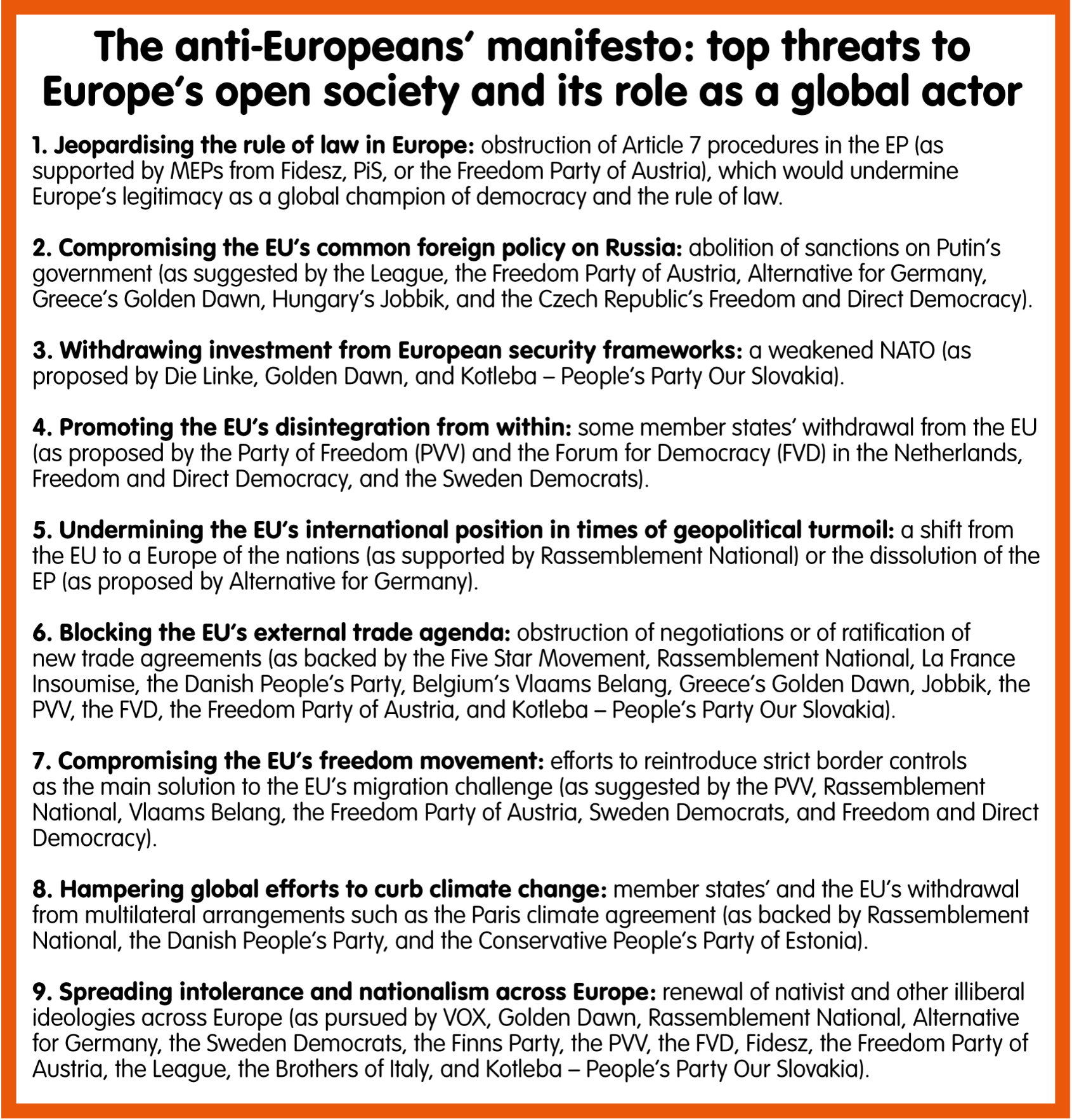
Underestimating the importance of the upcoming election
For anti-European parties, winning more seats in the May 2019 election should be understood as a means to an end. The bigger prize for them is a position from which they can challenge pro-Europeans in a wider battle of ideas. They mean to use this as a springboard for fighting national elections across Europe in the coming years.
For instance, if it is successful in the EP election, PiS will improve its position in the run-up to Polish parliamentary vote scheduled for autumn 2019. Equally, a poor result for the party would increase the likelihood that Kaczynski, Poland’s de facto leader, will soon lose power. In Bulgaria, the outcome of the EP election may determine whether the government will hold a snap national election. Such a vote could occur if the ruling, centre-right GERB performs poorly in the EP election, precipitating a political crisis. While GERB has signalled rapprochement with Orbán in the past year, a new election could pave the way for a government led by the Socialist Party, which is a far more strident advocate of anti-immigration and nationalist policies (and more pro-Russian) than its rival.
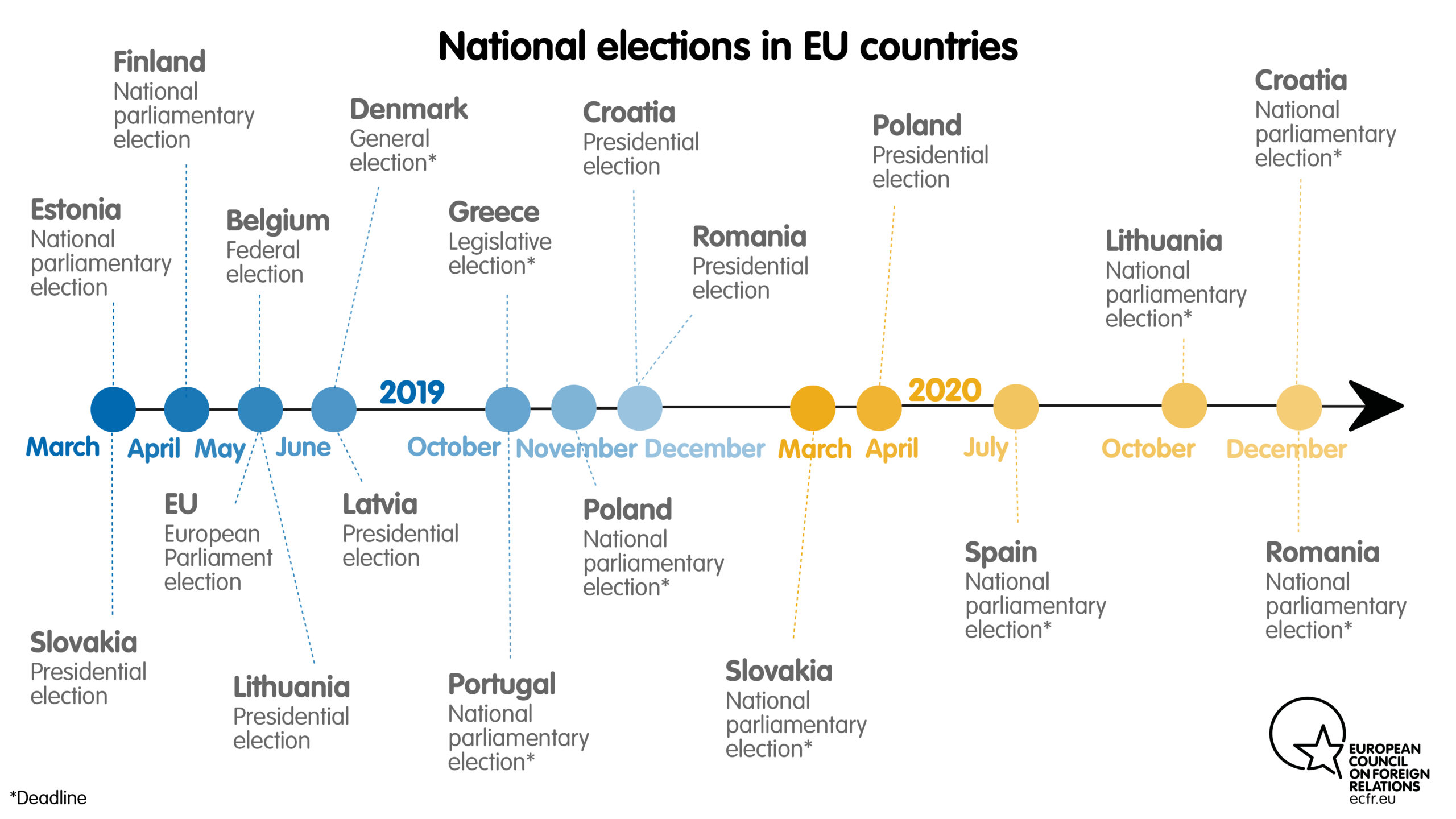
The EP election could also have a significant effect on Denmark’s political dynamics. With the country planning to hold a national election by June 2019, its mainstream Social Democrats have increasingly adopted an anti-immigration and Eurosceptic posture. And the populist Danish People’s Party stands a chance of entering the next government (having provided parliamentary support to the current one). A similar pattern may emerge in Belgium, with the conservative New Flemish Alliance (the country’s leading party) growing increasingly anti-immigrant ahead of a federal election scheduled for the same day as the EP election. In December 2018, the party’s ministers quit the government in protest against Belgium’s participation in the United Nations’ Marrakesh migration pact.
In Finland and Estonia, the EP election will likely coincide with fresh negotiations on forming a coalition government, raising the prospect of the far right forming part of the next Estonian government. And, by 2020, there will have been a new parliamentary election in Greece (with an early election in May 2019 increasingly likely), Croatia, Lithuania, Romania, Slovakia, Portugal, and Spain. There is also a growing possibility of a snap election in Italy, which would almost certainly benefit the League.
All in all, if Eurosceptics retain their power in Poland and Italy and acquire at least some influence over ruling coalitions in countries such as Denmark, Estonia, and Slovakia, this could help the illiberal camp obstruct the EU’s work through the European Council. In this scenario, governments in Budapest, Warsaw, and Rome would feel empowered by association, perhaps helping them break EU rules with impunity. And the risk is all the more serious given that the European Council (which is already a dominant player in the EU’s inter-institutional power game) could gain even greater power after the May 2019 election – at the expense of an EP that will likely be grappling with nationalist parties.
This suggests that neither pro-European parties nor their supporters can afford to indulge in the usual complacency about the importance of the EP election (which, in the past, may have been somewhat justified). In an ideal scenario, their goals of winning both European and national elections should be mutually reinforcing. But there is a risk that some generally pro-European parties – such as those in Denmark, Belgium, Spain, Austria, and the Netherlands, to name just a few – will enter into a vicious spiral: flirting with populist ideas ahead of the May 2019 election to strengthen their position at home. This would only provide more legitimacy to these ideas in a broader European debate and could later backfire at home, if voters decided that they preferred the original to a copy – switching their support from Partido Popular to VOX; from the New Flemish Alliance to Vlaams Belang; from the Austrian People’s Party to Freedom Party of Austria; from Les Républicains to Rassemblement National; from the CDU/CSU to Alternative for Germany; and from Dutch Prime Minister Mark Rutte to Geert Wilders or Thierry Baudet, leaders of the Party for Freedom and the Forum for Democracy respectively.
Fighting back
Despite the scale of the challenge they face, internationalist Europeans should not give up on this fight before they have even properly begun. Below, we lay out a strategy to prevent the EP election from setting off a broader shift in the European political landscape. The strategy centres on the following ideas:
- Driving a wedge between anti-European parties.
- Demonstrating the costs of their proposals in the real world.
- Framing the election within a pro-European agenda.
Driving a wedge between anti-European parties
As discussed above, the anti-European camp is much more divided than meets the eye. During the EP election campaign, pro-European forces should expose these divisions to undermine nationalists’ capacity to cooperate. They could even play one anti-European party against another – using tactics similar to those that have divided the mainstream.
For example, while the parties of Orbán, Kaczynski, and Salvini may all agree that migration is the EU’s major problem, they seek radically different solutions: the Hungarian and Polish governments refuse to accept the relocation of immigrants to their countries, while the Italian government seeks greater cooperation and solidarity between European states in relocating immigrants. Salvini and Kaczynski also hold irreconcilable views of the EU’s policy on Russia. The former does not conceal his admiration for Putin, while the latter views Russia as posing the greatest threat to his country. Unsurprisingly, they also disagree on NATO. The Austrian, German, and Dutch far right would like to slash the EU’s structural funds, which continue to be a crucial source of revenue for the Eurosceptic governments of Italy, Hungary, and Poland.
Some anti-Europeans are reluctant to address climate change, while others are not. And while anti-immigrant parties in central and southern Europe (including those in the Czech Republic, Estonia, Italy, and Spain) are deeply conservative about social issues – such as LBGT rights – this is not always the case for comparable parties in western and northern Europe. Last but not least, nationalist parties represent all shades of Euroscepticism: from seeking to abolish the EU outright to disliking the common currency or EU institutions’ focus on rule of law issues, to aiming to reshape the EU from within while maintaining an inflow of structural funds. The mainstream should emphasise these differences, with the goal of destroying the image of a monolithic anti-European alliance that Bannon, Salvini, Le Pen, and others are trying to create to promote confidence in the viability of the alternative they believe they offer.
Anti-European parties have accurately observed that, so far, European countries have been disunited on migration. This is why, during the campaign, pro-European parties should put forward practical policies that enable the EU to cope with the political challenge of migration without putting European values at risk. They should uncover the ambiguities and contradictions in the alternative narrative about migration – on which Orbán and Salvini speak with one voice but have opposing interests. At the same time, pro-Europeans should not let themselves become entangled in an all-encompassing debate on migration. Instead, they should try to extend the discussion to areas such as foreign policy, climate change, security and defence, growth, and jobs, issues on which nationalists are either much more divided or much less appealing, or simply have little to say.
Demonstrating the costs of anti-Europeans’ proposals in the real world
Pro-Europeans should also commit to showing how the EP election will affect voters’ lives. They should make clear that a vote for nationalist parties – as novel and exciting as this may seem – has significant effects in the real world.
Most anti-Europeans heavily criticise the EU for allegedly being an elitist project, undermining national sovereignty, and imposing heavy costs on individual countries. They use the word “liberal” as a grievous insult, even if they mean several different things by it. For the left, liberals are to blame for promoting free trade, globalisation, and austerity policy. For the right, liberals damage traditional values and ignore the dangers posed by migrants, secularism, and changes in gender roles. Like Trump or his Brazilian counterpart, Jair Bolsonaro, European nationalists are usually critical of “political correctness” – to the extent that they present their opposition to women’s rights, LGBT rights, other cultures, or measures to mitigate climate change as a crucial part of a pluralist political debate. They are particularly suspicious of multilateralism, as expressed in the Paris climate agreement and the Marrakesh migration pact. And – despite the cautionary tale of Brexit – many of them continue to lure citizens with a promise that their countries can exit the EU without incurring major costs. Pro-Europeans should spell out the consequences of the policies implicit in nationalists’ manifestos.
Support for anti-European and anti-establishment messages has been growing beyond the core electorate of the far right and the far left, for at least three reasons. Firstly, there is widespread frustration – un ras-de-bol général, as the French call it – among many citizens who are tempted to punish the political establishment at the polling stations. Before the 2016 Brexit referendum, many political commentators believed that voters would gravitate towards the status quo in a pivotal election out of fear of the unknown. But the political landscape has changed: recent national elections in France, Germany, Sweden, and Italy have shown that Europeans are increasingly willing to gamble with a vote against the establishment.
Anti-European forces have been successful in constructing an image of EU institutions as distant, ineffective apologists for a ruthless process of globalisation, and as responsible for much of the hardship that voters have endured in the past decade due to austerity, increased migration, and growing insecurity. Moreover, national elections may underrepresent the level of risk that voters could be willing to take in May 2019, given that Europeans generally see EP elections as being of secondary importance. Even EU membership could prompt voters’ recklessness: a paradox that Ivan Krastev observed in central Europe, asking “why should Poles fear someone like Kaczynski if they know that Brussels will tame him if he goes too far?”.
Secondly, some members of the political establishment hope to stay afloat by adopting elements of the anti-Europeans’ agenda, particularly in veering towards anti-immigrant or EU-sceptic positions. The effect of this is twofold, increasing the potential for cooperation between the centre-right and the far right, and making the leap from mainstream parties to their populist rivals appear smaller.
Thirdly, national and EU leaderships adopt anti-Europeans’ methods when they try to address the EU’s so-called democratic deficit through direct democracy tools – such as plebiscites or consultations – and attach excessive importance to them when they are not fully representative or do not go far beyond the level of isolated opinions. This approach could be seen in the citizen consultations on European issues that various member states organised in 2018, in the hope that this could lead to some kind of grand consensus on citizens’ expectations and the ways in which the EU could satisfy them. But this is a perfect example of a technocratic solution to a political problem.
National and EU institutions will need to play a role in halting the progress of nationalists across Europe. But they should not bypass politics, presenting the EU’s policies as apolitical, pragmatic, and without alternatives – as this would only weaken the mediating role of political parties and civil society. Political parties on the national and European levels must do most of the work. Arguably, one of the main reasons behind the rise of the far left and the far right in almost all parts of Europe is that mainstream parties have often become too indistinguishable from one another.
Attempts to unite the left and the right in a kind of pragmatic alliance have been, at best, disappointing and, at worst, dangerously disruptive for established channels of political activism (as is currently seen in countries such as the Czech Republic, Italy, and France). Mainstream political parties’ task is to insert multiple policy options back into the public debate, on issues ranging from migration to trade, the eurozone, and pan-European solidarity. Political parties will also need to argue that elected representatives are indispensable to making sense of very complex issues, against anti-Europeans’ claim that people can rule directly (as promised by Italy’s Five Star Movement, the gilets jaunes, or the Forum for Democracy).
Framing the election with a pro-European agenda
The success of pro-European parties will also depend on whether they can mobilise the silent pro-European majority through the issues that they care about enough to vote on them. To do this, they need a far deeper understanding of what Europeans are currently feeling as well as thinking, and what this means for how pro-European parties should communicate with them. There are many lessons they should learn from the populists themselves. Deeper research is also necessary to provide an emotional map of Europe, to help pro-Europeans navigate the political landscape and understand the feelings and experiences that drive the opinions expressed in citizens’ consultations. This is one of the goals of ECFR’s work in the coming months.
Rather than simply fight defensively on the issues that anti-Europeans favour, pro-European forces should be creative in constructing an image of a reinvigorated, hopeful European project. And they should frame the election debate in each national setting according to the issues that voters want the EU to deal with there. Our research across the EU27 suggests that there are at least five different approaches that could mobilise pro-Europeans:
- A values election: pro-Europeans should explicitly defend the fundamental values that the silent majority believe in and associate with the EU project, including the rule of law; freedom of expression; and equality in economic, social, and cultural rights. They should make clear the extent to which these are under threat from many nationalist parties.
- A prosperity election: pro-Europeans should stress that nationalists’ promise to bring prosperity to the EU is a false one, and defend the record of EU investment in underdeveloped regions. If paralysis in the EU prevents agreement on the next MFF (and the structural funding it provides), this will have a real impact on voters’ quality of life in many parts of the EU. In some countries, such as those in central, eastern, and southern Europe, Europeans should explicitly make this link.
- A tax justice election: in many member states, pro-Europeans could win votes by emphasising that EU institutions are critical in the fight to ensure that large tech companies pay their fair share of tax. This could be effective given that the growing gap between rich and poor is an issue that has prompted many European protests.
- A green election: issues such as climate change and air quality are high on the agenda in France, Poland, Sweden, and other member states. To mobilise voters who are concerned about these issues, it will be important for pro-Europeans to position themselves as the guardians of the green agenda, and emphasise the risk that the EU will no longer be able to provide multilateral leadership in setting environmental regulations.
- An enemy from within election: the argument that anti-Europeans are doing the job of the Kremlin for them, destabilising Europe from within, could prove powerful among voters who are concerned about evidence of political interference and information manipulation from Russia in recent European elections. Pro-Europeans should draw attention to the foreign policy agenda of many nationalist parties.
In some settings – particularly large cosmopolitan cities; regions in which the tangible benefits of EU membership are still highly evident; and member states unsettled by the turbulent international environment and the unreliability of the US security guarantee under Trump, such as Germany – mainstream parties could also fight an “existential threat to Europe” election. In these settings, the desire for l’Europe qui protège is strong, and the logical case should be made that the EU cannot protect its citizens if the internal destruction agenda of the anti-Europeans goes ahead. All in all, political parties should not shy away from looking for novel approaches that reflect their political orientation while enabling them to move the debate onto a wide spectrum of issues. In this way, they could inspire their countries’ pro-European silent majority.
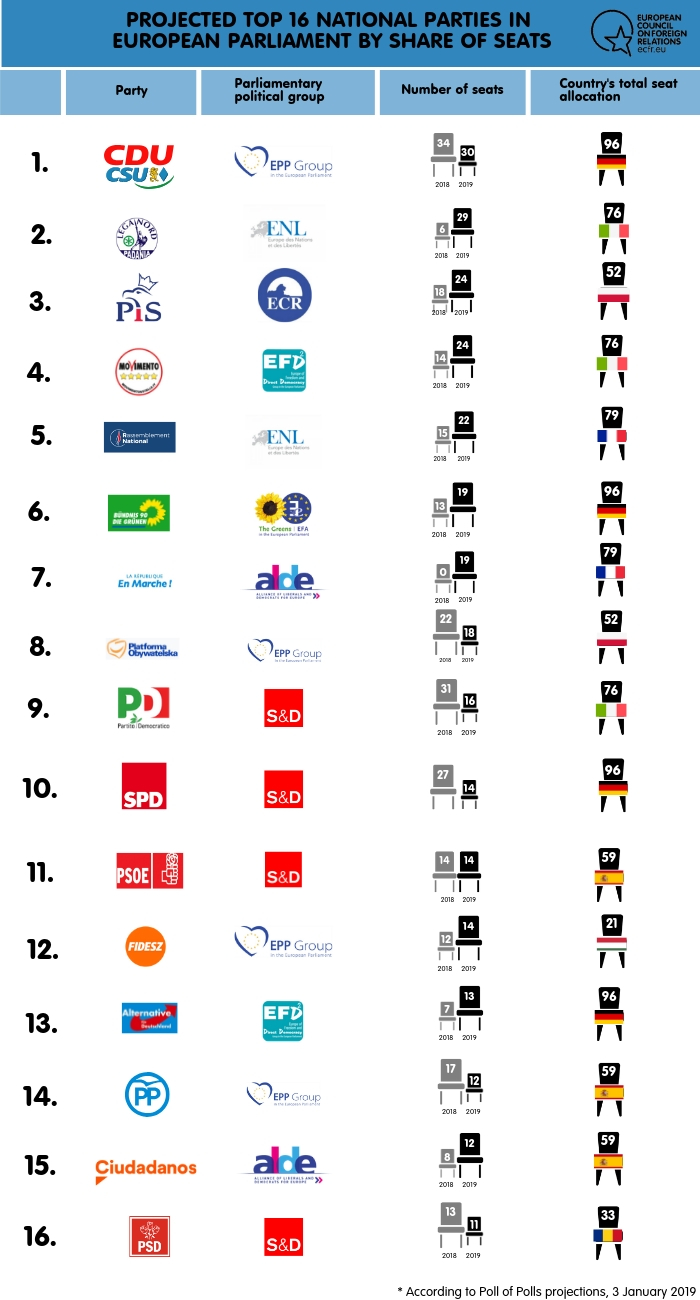
In the three countries in which anti-Europeans lead the government rather than just pose a distant political threat – Poland, Hungary, and Italy – there are strong reasons for the pro-European forces to emphasise their unity. For example, the Polish government may currently be trying to present a pro-European face, but with Poland’s rule of law controversies far from being resolved, and the European Court of Justice ruling on Poland expected in March 2019, there is a genuine threat that Poland will leave the EU, if only by accident. The Polish opposition must emphasise this if it is to stand a chance of defeating PiS in the EP election, and to establish a lead ahead of a national parliamentary election in autumn this year. However, with many voters worried about the direction in which the EU is moving, Poland’s pro-Europeans cannot focus their campaign on only the spectre of an exit from the EU. Instead, they may also have to redefine Poland’s national interests – on energy, defence, and migration, among other areas – and realign them more closely with the rest of the EU, given the changing regional and global context.
In Hungary, the opposition is much weaker than its Polish counterpart. Nonetheless, a recent wave of protests provides the opposition with some momentum to expose the problems with Orbán’s Europe policy, including his government’s reluctance to join the European Public Prosecutor’s Office.
The situation in Italy is much less clear-cut than that in either Poland or Hungary: there are sharp divisions within the government separate to those between it and the pro-European parties of the centre-left and the centre-right opposition. But the Democratic Party and Emma Bonino’s new Più Europa should question whether the government’s aggressive Europe policy – on economics and migration, as well as their anti-elitist stance – actually benefits the country and its citizens.
Conclusion
The battle of ideas in which Europeans are engaged will doubtlessly continue after the EP election. But the result of the May 2019 contest will largely set the boundaries of this battle for years to come. The key battles in May 2019 will take place in Germany, France, Italy, Poland, and Spain, which collectively account for more than 50 percent of EP seats. Nonetheless, preserving a pro-European majority in the EU in the medium and long term will require hampering the rise of nationalists elsewhere, from Sweden and the Netherlands to Estonia and Croatia.
In this sense, pro-Europeans from all EU member states have no time to lose. EU heads of state and government plan to adopt a new document on the future of Europe at an informal summit in Sibiu, Romania, in May 2019. And there are European leaders who occasionally signal a possible opening, as with Juncker’s recent expression of support for European unemployment insurance. But these efforts are insufficient given the task at hand. Pro-European parties and groupings should realise that the fight is now under way. If they allow Eurosceptics to seize the initiative and frame the discussion, and gain further political momentum at home, this will be a strategic error they cannot recover from.
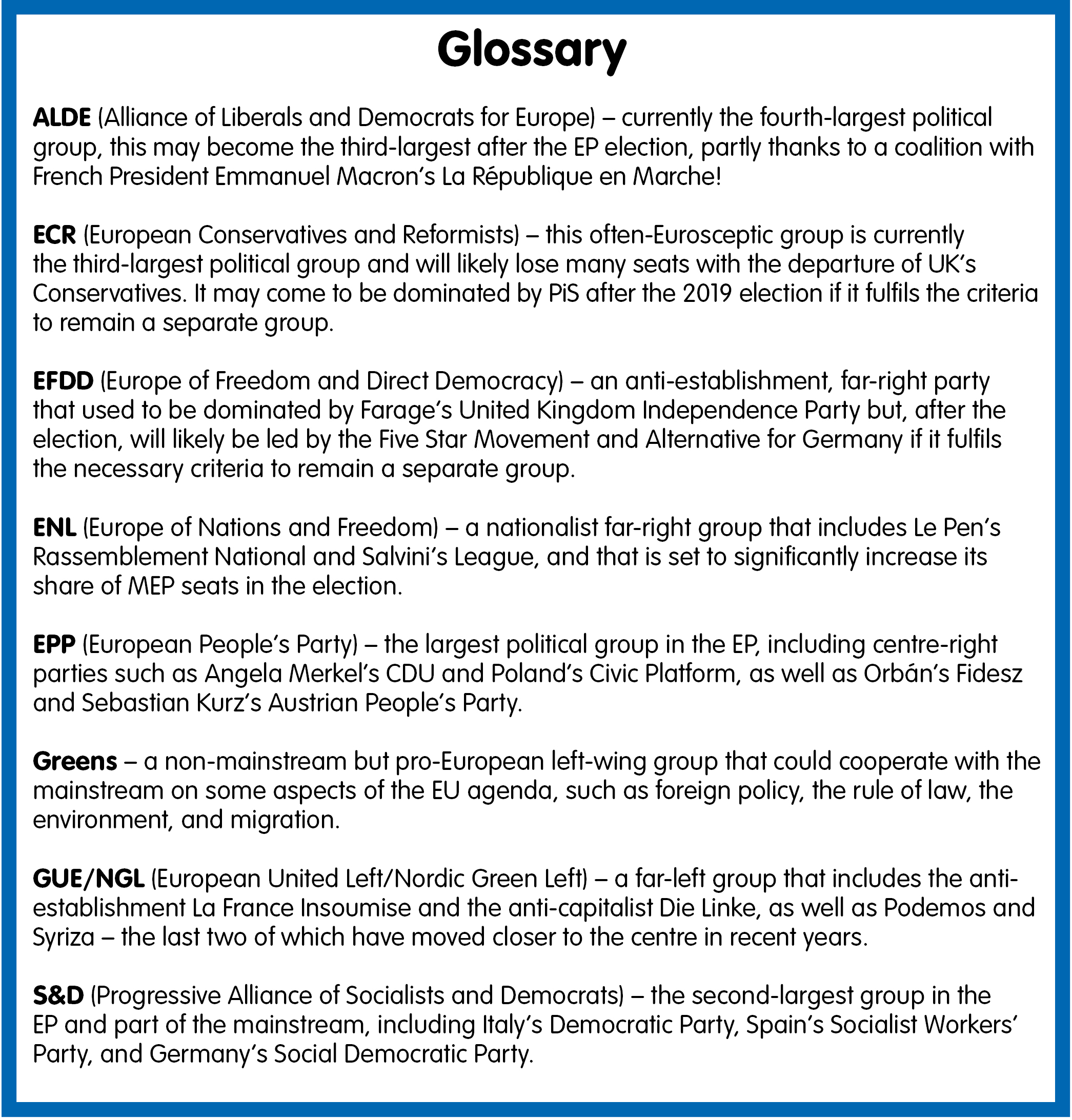
Annex
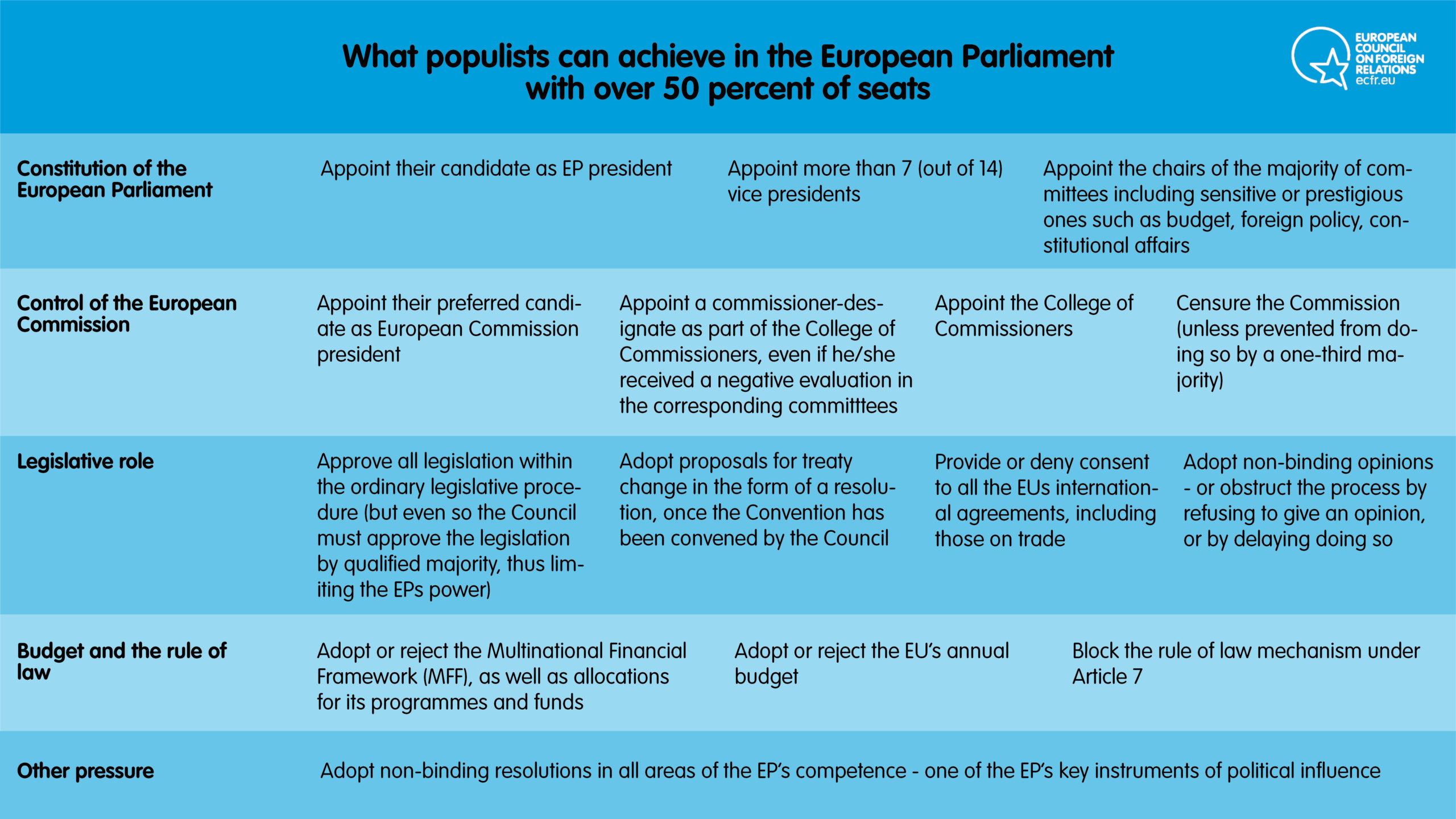
About the authors
Susi Dennison is a senior policy fellow at ECFR and director of the European Power programme, which focuses on the strategy, politics, and governance of European foreign policy at this challenging moment for the international liberal order. She previously led ECFR’s European Foreign Policy Scorecard project for five years, and worked with ECFR’s MENA programme on north Africa. Before joining ECFR in 2010, Susi worked for Amnesty International in its European Union office. Susi began her career in HM Treasury in the United Kingdom.
Pawel Zerka is a programme coordinator at ECFR based in the Paris office. He coordinates ECFR’s European Power programme. Pawel holds a PhD in economics and an MA in international relations. His main areas of expertise include EU affairs, Latin American politics, international trade, and Poland’s European and foreign policy. Before joining ECFR in 2017, Pawel worked as an expert in foreign affairs in two private think-tanks in Poland: WiseEuropa, and demosEUROPA-Centre for European Strategy.
Acknowledgements
The authors would like to thank the Open Society Foundation, without whose financial support this research would not have been possible. They would also like to express their gratitude to ECFR’s colleagues, especially José Ignacio Torreblanca, Mark Leonard, and Carla Hobbs for their helpful comments. Special thanks go to Chris Raggett, Adam Harrison, and Katharina Botel-Azzinnaro for editing, and to Marta Pellón Brussosa for research support. This report relies more than anything on the tireless work of our 27 researchers across the EU, to whom the authors are deeply indebted.
[1] For a demonstration of procedural effects of two other scenarios – above 50 percent or below 33 percent – see Annex.
[2] For the explanation of abbreviations and of the political divisions in EP, see Glossary Box at the end of this paper.
Austria

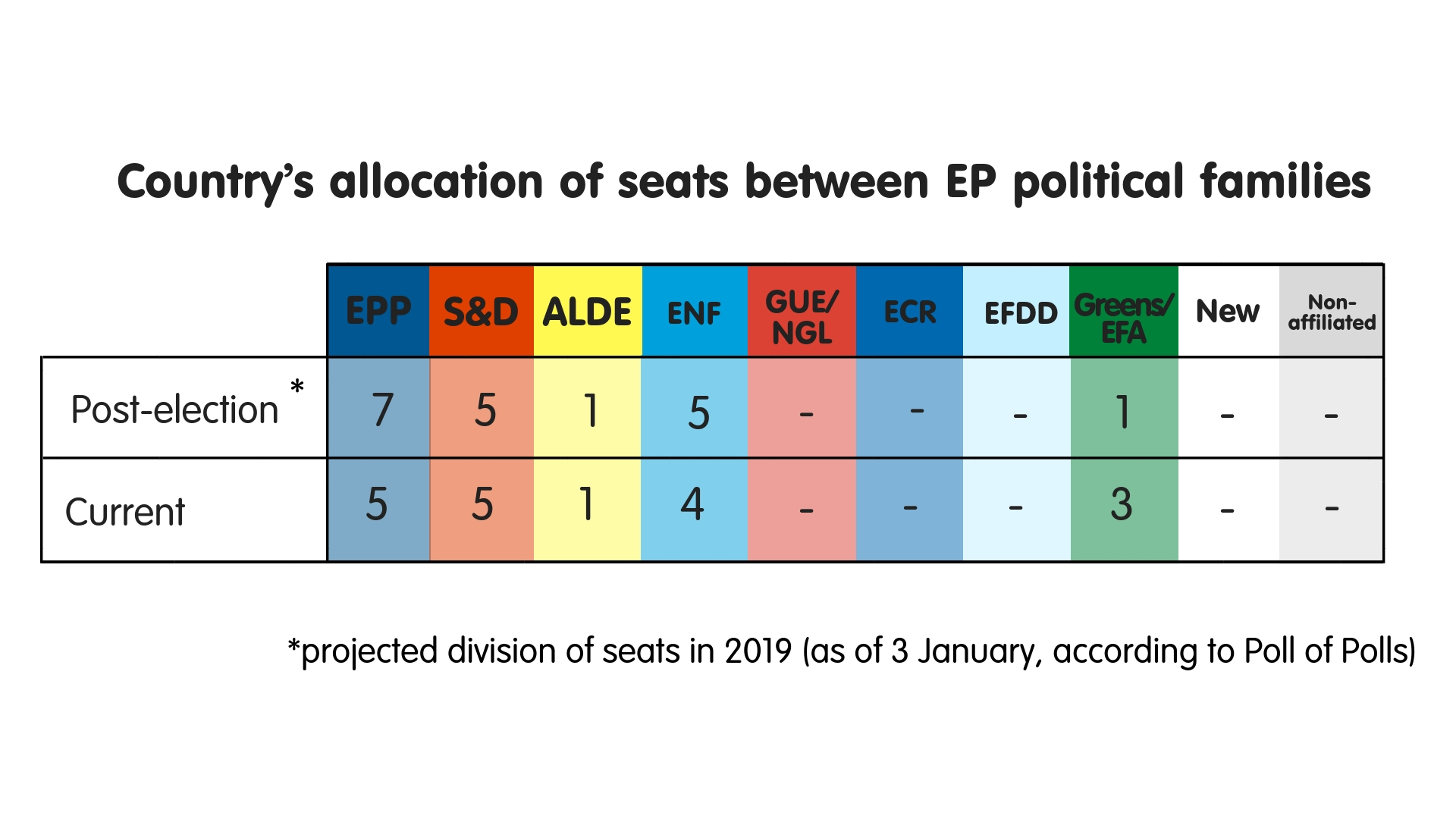
Projected voter turnout
Turnout at the last two EP elections in Austria stood at 45-46 percent. It is unlikely to go beyond that level in 2019 – despite the higher than usual stakes of the vote. There are usually no surprises in Austrian EP elections given that they normally see experienced politicians running for the main parties. At the same time, the ruling coalition may refrain from putting too much emphasis on the poll as Austrian voters have often used EP elections as an occasion to protest against government policy – to the benefit of opposition parties.
Main battles in 2019
Austria is a small political market and, therefore, it will hold a centralised political debate ahead of the 2019 EP election. Migration and security concerns will be the main topics. Chancellor Sebastian Kurz’s Austrian People’s Party (ÖVP) – the ruling coalition’s main party – will present itself as one of the key actors in reforming the EU and a guarantor that the country’s borders will be protected against illegal migration. Heinz-Christian Strache’s Freedom Party of Austria (FPÖ) – the coalition’s junior partner – will campaign more aggressively against immigration and the purported Islamisation of the country. In turn, the main opposition parties – liberals and social democrats – may intend to refocus the debate on socio-economic challenges and are likely to appeal for stronger European cooperation.
The mainstream
The ÖVP is the main political force in Austria, leading the government coalition and polling first with 35 percent of the vote, nine percentage points more than the Social Democrats (SPÖ). The ÖVP is a member of the European People’s Party group within the EP and maintains close links to German conservatives: Angela Merkel’s Christian Democrats and Horst Seehofer’s Christian Social Union. The ÖVP favours trade liberalisation and the EU’s focus on the rule of law – but is reluctant to support further EU integration and is internally divided on the issue of migration. It is likely to win seven MEP seats in 2019. The SPÖ is traditionally the other mainstream party in Austria. A member of the Socialists and Democrats group in the EP, it cooperates with the Italian and Spanish centre-left; it may win five or six MEP seats. Mostly in favour of migration, the rule of law, and closer European integration, it tends to be divided on the issue of trade liberalisation.
The Eurosceptics
The FPÖ is the main party of Austria’s far right. The junior partner in the ruling coalition, the FPÖ is strongly anti-immigration and Eurosceptic, opposing not just “ever closer union”, but also the EU’s focus on the rule of law and its trade liberalisation initiatives. Members of the Europe of Nations and Freedom group in the EP, they maintain close links to Alternative für Deutschland, Marine Le Pen’s Rassemblement National in France, and Law and Justice in Poland. Between 2015 and 2017, the FPÖ led in Austria’s opinion polls but ended up coming third in the 2017 Austrian parliamentary election, with 26 percent of the vote – which is, more or less, its current level of support. The FPÖ is projected to win five MEP seats.
Belgium
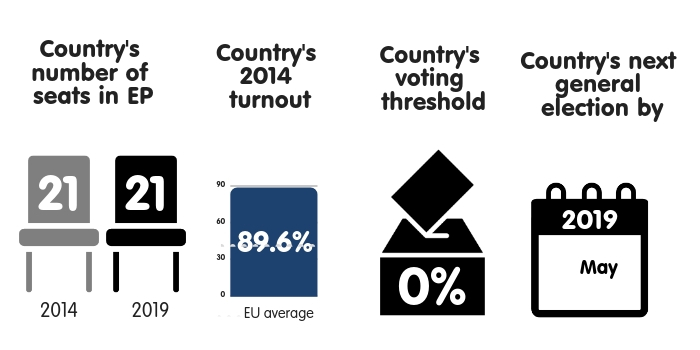
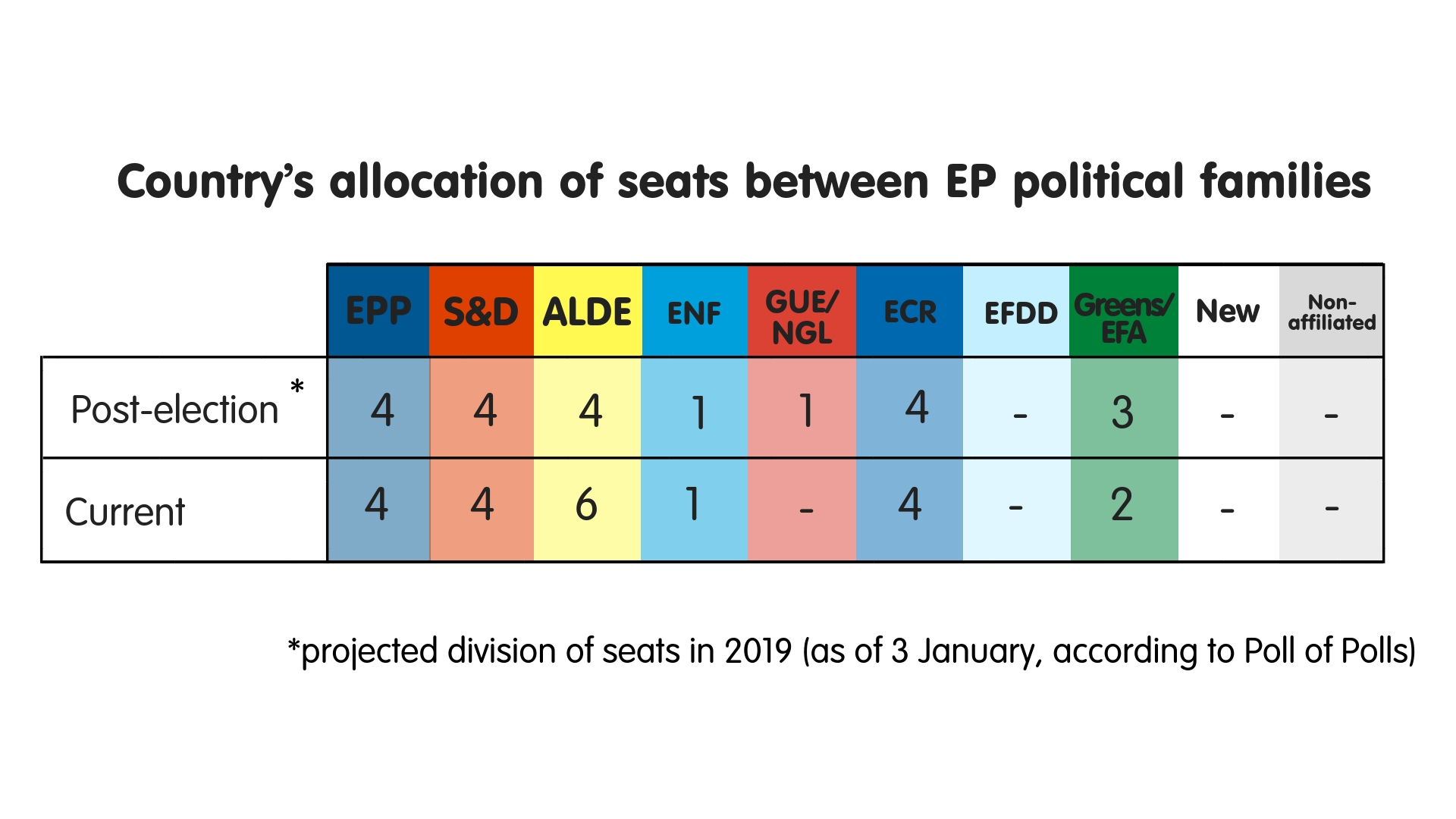
Projected voter turnout
Belgium and Luxembourg usually have higher turnouts in EP elections than any other country (regularly more than 90 percent). However, given that voting is obligatory in both states, this is not a useful indicator of voters’ interest in EU affairs. Judging by the low profile of European issues in the Belgian political debate, EP elections are of little interest to voters. That may especially be the case in 2019 due to recent fallout over the Marrakesh Pact, and given that the EP election will coincide with federal and regional elections, which most citizens consider to be much more important. This is quite paradoxical, since some of the most topical issues in the coming national ballot (such as security and the refugee crisis) are, to a large extent, dealt with at the EU level.
Main battles in 2019
Belgium (along with Italy, Poland, and Ireland) is one of a handful EU members that will be divided into several constituencies at the 2019 EP election. Its three constituencies will comprise the Dutch- (12 MEPs), French- (eight MEPs), and German-speaking (one MEP) electoral colleges. At the same time, the debate will be strongly polarised between the country’s three main regions: Flanders, Wallonia, and Brussels. As Flanders is a right-leaning region, migration and security should feature prominently there, especially since these will be the first federal, regional, and EP elections in Belgium since the March 2016 Brussels bombings. Wallonia is a left-leaning region where socio-economic issues will be at the heart of the debate, although migration will feature as well.
The mainstream
Given the lack of electoral threshold, and the fact that the country is divided into three electoral colleges, Belgium’s political representation in the EP is likely to be something of a patchwork. Altogether, 12 different parties are projected to win one or more seats, half of them just one MEP. Therefore, it makes sense to discuss the projected changes in the balance between representatives in the EP’s political groups. From this perspective, the number of Belgian liberal MEPs may fall from six to four following the decline in the polls of both Le Mouvement Réformateur and the Flemish Liberals (Open VLD). The Greens – who are gaining popularity in Flanders and Wallonia – may add another MEP seat to their current two. Belgian members of the European People’s Party, the Socialists and Democrats, and the European Conservatives and Reformists (ECR) – which have four MEPs each – should maintain their overall positions.
The Eurosceptics
One dynamic that is playing out on the right of the political spectrum is crucial in Flanders. There, the right-wing New Flemish Alliance (NVA), a member of the ECR, is trying not to lose ground to the far-right Vlaams Belang (VB), a member of the Europe of Nations and Freedom group. As it does so, the NVA is becoming increasingly hardline on migration – and it left the ruling coalition in December 2018 in protest against the country’s support for the UN Global Compact on migration. Current polls suggest that the NVA and the VB will win four MEP seats and one MEP seat respectively, but this may change. Meanwhile, on the left of the spectrum is the far-left PTB/PVDA, which is a member of European United Left–Nordic Green Left group, and which has been critical of the EU. Seeking its first MEP, it has already pulled the region’s Socialist Party further to the left. At a federal level, this growing polarisation will likely complicate the formation of the next Belgian government: the main Flemish party, the NVA, refuses to govern with the main Walloon one, the Socialists.
Bulgaria
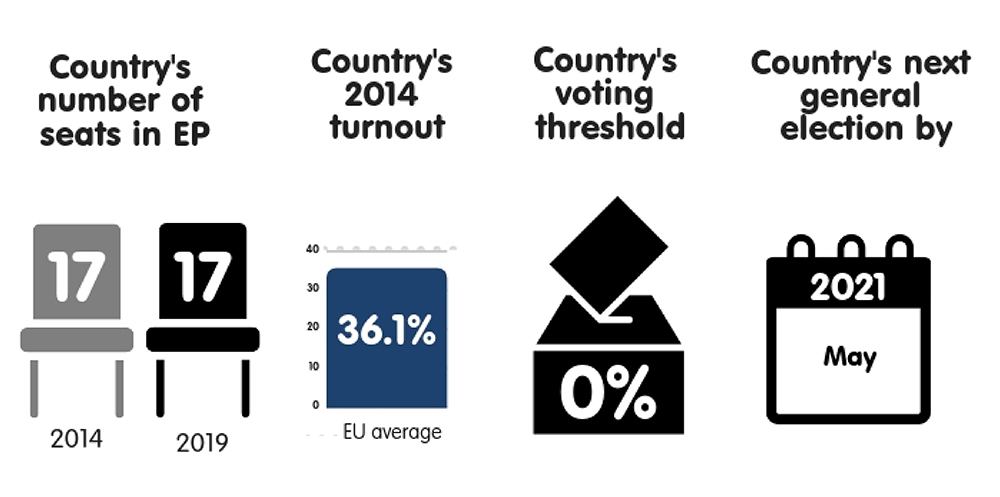
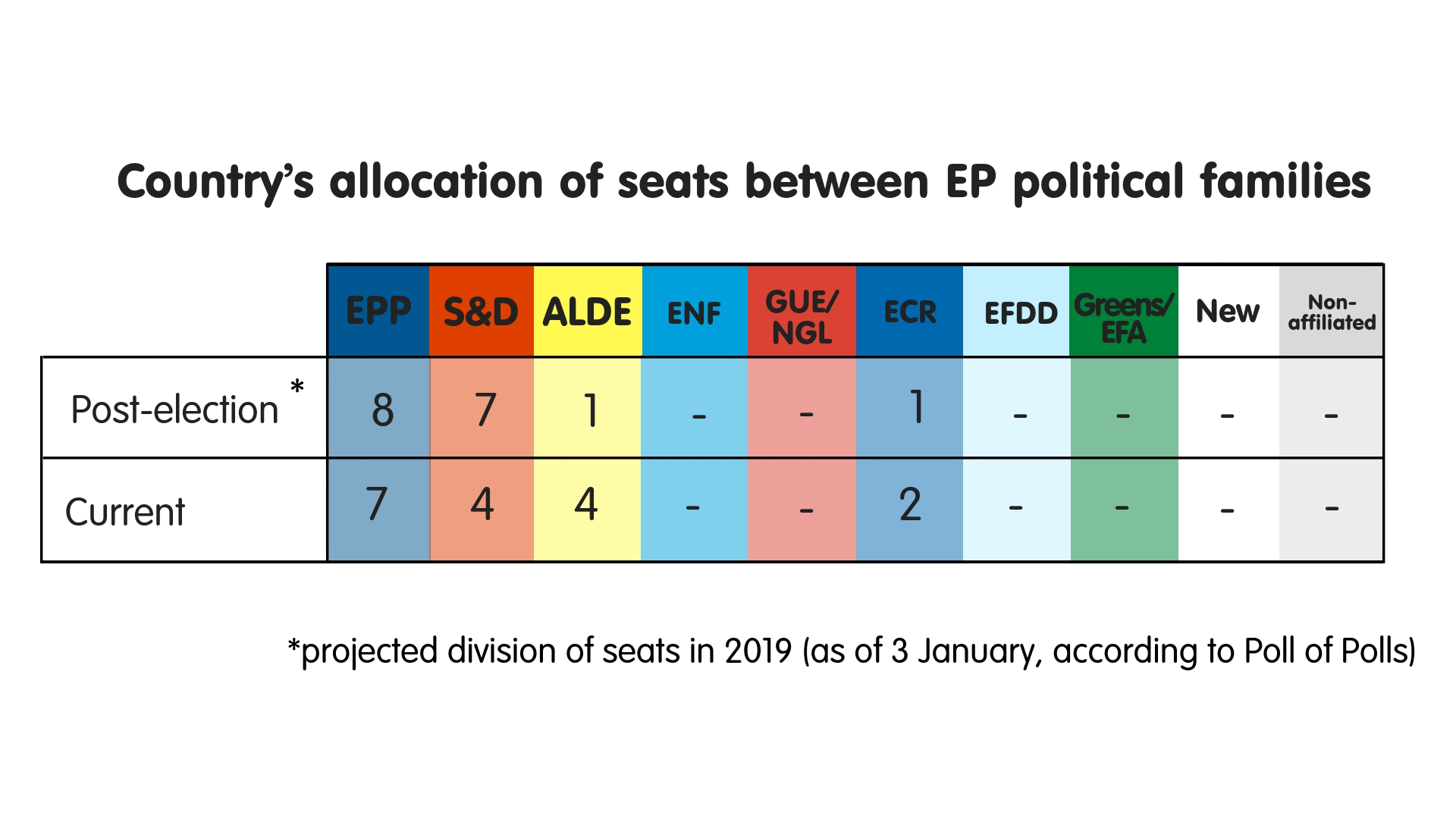
Projected voter turnout
Most Bulgarians see the EP elections as a continuation of national politics, or as something of a rehearsal for the next general election, rather than a period of in-depth deliberation about the EU and Bulgaria’s membership of it. Bulgarians have not had an opportunity to express their support for political parties since the snap general election in March 2017. Some experts say that the outcome of 2019 EP election will decide whether another snap national election is needed in Bulgaria. This raises the stakes of the 2019 vote and may boost turnout – which was higher in 2014 (at 36 percent) than in most other central and eastern European EU member states.
Main battles in 2019
The campaign for the EP election will focus on a mixture of national and European issues. The ruling centre-right will likely concentrate on the EU’s next Multiannual Financial Framework, as well as cohesion policy, with a positive message about the next round of European investments in Bulgaria. It may also promise further progress on the country’s membership of the eurozone and the Schengen Area. In turn, the Bulgarian Socialist Party (BSP), as the main opposition party, and right-wing United Patriots, a junior partner in the ruling coalition, may focus more on migration and border protection, exploiting a rise in anti-refugee sentiment in the country. They are also likely to criticise the EU’s policy vis-à-vis Russia, given their largely pro-Moscow orientation. There is a consensus among Bulgarian parties that the prospect of a multi-speed Europe should be avoided, but that they should debate the ways in which it could come about.
The mainstream
The ruling coalition is led by Boyko Borissov’s centre-right GERB (a European People’s Party member), which leads the polls with 38 percent of the vote and is projected to win eight MEP seats in 2019. The BSP, members of the Socialists and Democrats group in the EP, is the second-largest party in Bulgaria, polling second at 33 percent of the vote, which would provide it with seven MEP seats. Rumen Radev, who became the country’s president in 2017 with the support of the BSP, is considered a unifying figure for the country’s left, which is strongly pro-Russian. The Movement for Rights and Freedoms (a member of the EP grouping of Liberals) is often referred to as the Turkish minority party and polls third with 8 percent of the vote, which would earn it one MEP seat. All other parties are projected to compete for the one remaining Bulgarian seat in the EP.
The Eurosceptics
Despite representing the mainstream, factions within Bulgaria’s two main parties (especially the BSP and, to a lesser extent, GERB) have veered sharply towards conservative, nationalist, and even Eurosceptic positions in recent years, following the lead of Viktor Orbán’s Hungary. These aside, there are strongly Eurosceptic politicians in Bulgaria – particularly within the United Patriots, which is a loose coalition of three nationalist parties (the National Front for the Salvation of Bulgaria, the Bulgarian National Movement, and Ataka), and which serves as a junior partner in the current national government. With 9 percent support in the polls, it hopes to win one MEP seat in 2019. The three United Patriots parties are, to varying degrees, pro-Russian and Eurosceptic – but they are also mired in internal infighting.
Croatia
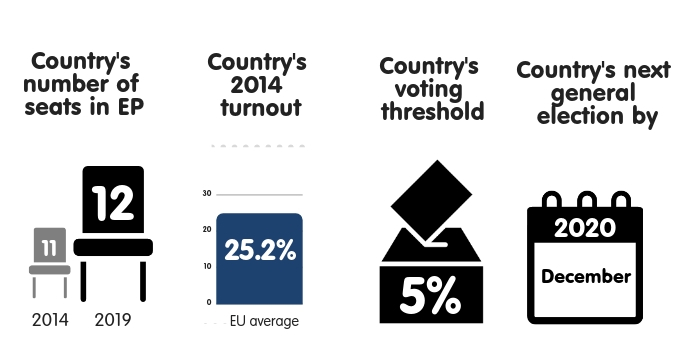

Projected voter turnout
Turnout in the 2014 EP election was just 25 percent in Croatia. This year, it is likely to be more than 30 percent, largely because the current prime minister, Andrej Plenković, used to be an MEP and because Croatia will take over the EU’s rotating presidency in early 2020. There have been rumours about Plenković calling a snap parliamentary election to benefit from his current popularity. That may enable his party to govern alone, without the need to enter a coalition with smaller partners. If such an election took place at the same time as the EP vote, turnout would be even higher. This would largely benefit the ruling Croatian Democratic Union (HDZ). But it currently appears unlikely that there will be a snap election.
Main battles in 2019
The campaign is likely to focus on economic issues: how to boost Croatia’s weak growth, make better use of the EU’s structural funds, increase youth employment, and slow the emigration of Croats to other EU member states. But immigration will also be a hot issue, especially if another wave of refugees arrives at the country’s borders in the spring. Xenophobia is on the rise in Croatia: in 2017, one survey showed that 80 percent of Croats believed that “migrants and refugees should go to countries with similar culture”. If migration becomes a central topic, this will benefit the two anti-refugee parties: MOST and Human Shield. The ruling party used to flirt with far-right ideology but Plenković has positioned it as an ally of German Chancellor Angela Merkel, with a much softer stance on migration.
The mainstream
The ruling centre-right HDZ party (a member of the European People’s Party) dominates Croatia’s political landscape and could secure around 35-40 percent of the vote, giving it five or six MEP seats. The other parties of the country’s mainstream include the Social Democratic Party of Croatia (the SDP, a member of the Socialists and Democrats). It has, however, lost a considerable number of supporters in recent years due to internal infighting. It is projected to obtain around 15-20 percent of the vote and three MEP seats. Both parties – as well as the liberal GLAS/IDS (a member of the EP’s liberal group), which is projected to gain a vote share of 5-10 percent and one MEP seat – are pro-European: in favour of ever closer union, trade liberalisation, and a focus on European values.
The Eurosceptics
The decline of the SDP in recent years has provided space for new parties, such as the centre-right MOST and the anti-EU Human Shield. The latter is rising in the polls, largely due to its anti-migration discourse, which finds fertile ground in Croatia’s growing xenophobia. Human Shield is not just Eurosceptic but also anti-establishment, pro-Russian, and critical of NATO and of integration with the West. Its members do not conceal their close links to Moscow nor contact with former US presidential campaign adviser Steve Bannon and the Movement. If Human Shield enters the EP in 2019, this will provide a strong boost to the party’s popularity at home.
Cyprus


Projected voter turnout
Despite compulsory voting, turnout at EP elections has been in rapid decline in Cyprus: from 72 percent in 2004 to 44 percent in 2014. Local problems dominate the public debate, notably reunification and the current crisis with Turkey over hydrocarbon exploration. Still, Brexit and the refugee crisis (which have major implications for neighbouring Greece and Turkey) have led many Cypriots to realise how dependent on EU membership their country has become. This may herald a similar or slightly higher turnout than in the last vote. The country’s emerging far-right party, the National Popular Front (ELAM), is projected to mobilise its supporters to try to seize one of Cyprus’s six MEP seats. This should prompt other parties to urge their supporters to vote.
Main battles in 2019
Turkey-EU relations will dominate the campaigns of each major political party in the 2019 EP election. Other topics that should also feature include economic growth and employment, security and defence, and human rights. Immigration will be discussed, but it is not a central issue given that Cyprus (an island outside the Schengen Area) hosts few refugees in comparison to other European countries. The upcoming election will largely be about the race for the sixth MEP seat, which may fall to the country’s far right for the first time.
The mainstream
The three main parties in Cyprus – Democratic Rally (DISY), the Progressive Party of Working People (AKEL), and the Democratic Party (DIKO) – are projected to get two, two, and one MEPs respectively. DISY (a member of the European People’s Party) is Cyprus’s main party and dominates the centre-right of the political spectrum. AKEL (a member of European United Left–Nordic Green Left group) and DIKO (a member of the Socialists and Democrats) dominate the left and centre respectively. AKEL criticises the EU’s “neoliberal” orientation but is not opposed to the EU as such. Another left-wing party, the Movement for Social Democracy (EDEK) – which distinguishes itself from the other mainstream parties due to its opposition to a federal solution to the Cyprus problem – will compete with ELAM for the country’s sixth MEP seat.
The Eurosceptics
The ultranationalist, Eurosceptic ELAM, which is affiliated with Greece’s Golden Dawn, stands a real chance of getting one MEP seat. Currently, the party polls in fourth place, with the support of six percent of voters. ELAM opposes European integration and advocates a Europe of nations instead. More worryingly, however, it also promotes Greek nationalism and exhibits neo-fascist leanings. In 2010, the party organised a march against Turkish Cypriots and migrants.
Czech Republic
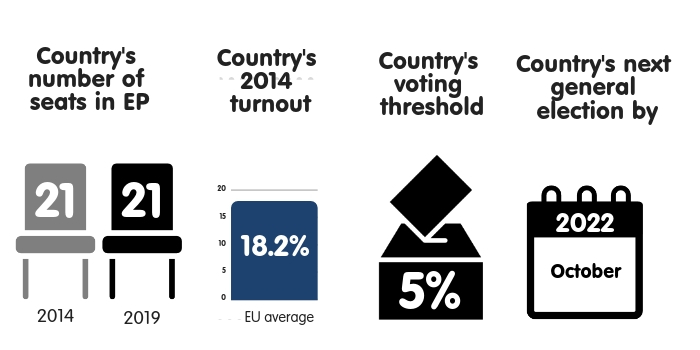
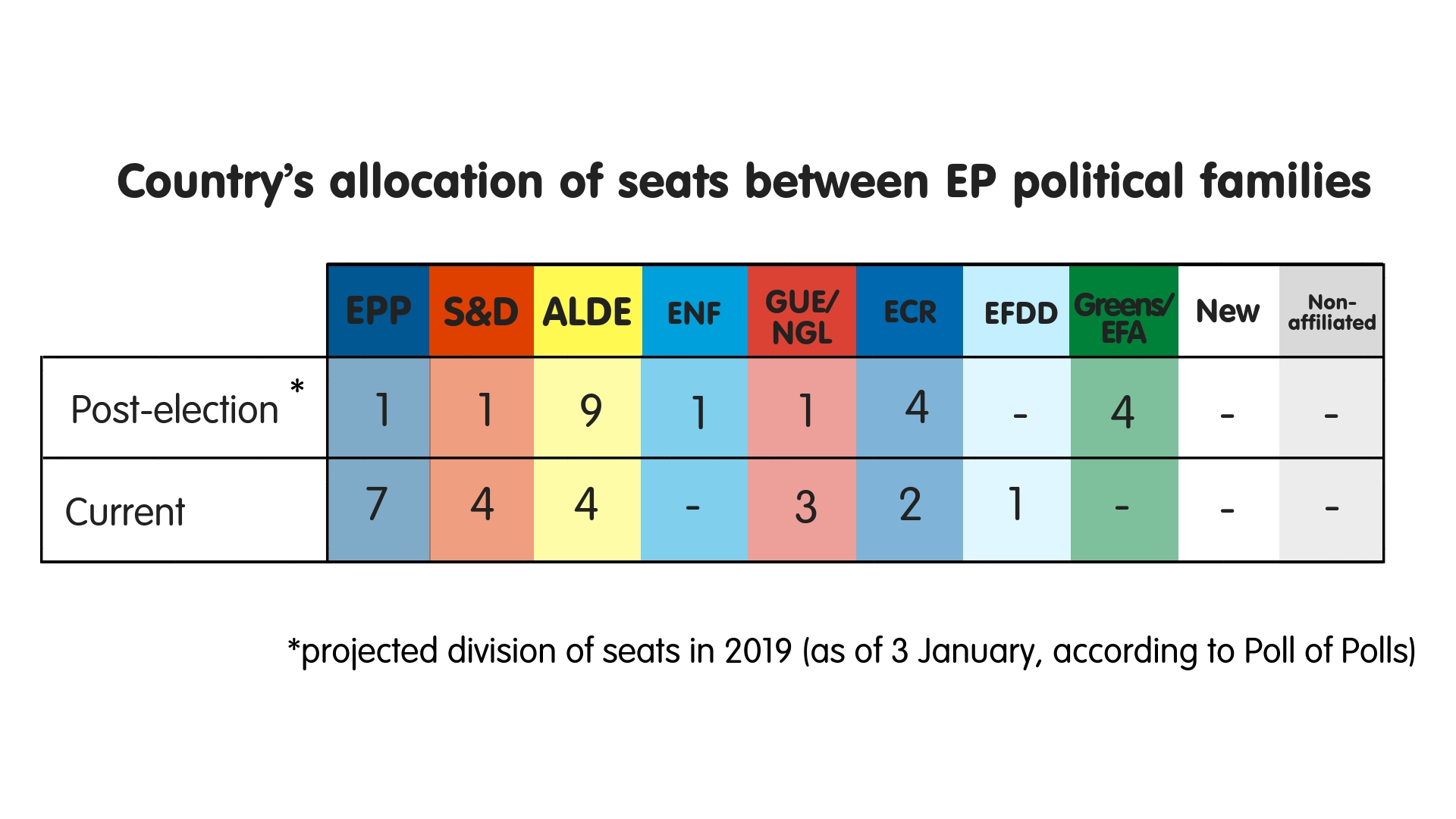
Projected voter turnout
Turnout in EP elections in the Czech Republic is regularly among the three lowest in the EU. This year, it is widely expected to be little more than 20 percent, and only slightly higher than in 2014. Migration issues might have a mobilising effect on the electorate. But, at the same time, voters may already be tired of going to the polls: in 2018, they have had to vote in presidential, senatorial, and local elections. Low turnout usually favours pro-European parties, whose supporters are relatively interested in European issues. It may also enable smaller parties (such as the pro-European centre-right TOP 09 party, which is currently polling below the threshold to enter parliament) to vie for a seat if they invest in the campaign.
Main battles in 2019
A strong Eurosceptic element will feature in the 2019 EP election in the Czech Republic due to the presence of the far-right Freedom and Direct Democracy party in the Czech parliament, and an overall rise in anti-refugee sentiment across the country. Migration will become the most controversial issue in the campaign, perhaps leading politicians to link it to security and the fight against terrorism. Other topics that Eurosceptics are likely to raise include the country’s accession to the eurozone as well as “Czechxit”. Still, ANO 2011, the party of Prime Minister Andrej Babiš, should be the clear winner of the election (despite allegations of corruption against the prime minister). It is expected to campaign on a pro-European ticket, especially given recent signs of cooperation between Babiš and French President Emmanuel Macron.
The mainstream
The pro-European mainstream in the Czech Republic is currently dominated by ANO 2011 (a member of the EP Liberal group), which may win twice as many votes in 2019 as any other party and obtain nine MEP seats as a result. Babiš won the 2018 general election with promises to stand up to Brussels and fight illegal migration. But he has softened his stance since, favouring the principle of free movement while seeking stronger controls on the EU’s border. Two established parties of the Czech pro-European mainstream – the Christian Democrats and the Social Democrats – may win just one MEP seat each. The pro-European Czech Pirate Party (a member of the Greens in the EP) should finish in second or third place, winning three or four MEP seats.
The Eurosceptics
Various degrees of Euroscepticism are evident on the Czech political scene. On the far right, Tomio Okamura’s Freedom and Direct Democracy party will likely campaign against migration, eurozone accession, and Czech EU membership in general. Supported by 8-9 percent of voters, it is projected to gain one or two MEP seats. Interestingly, similar messages (and an analogous pro-Russian orientation) will feature in the campaign of the far-left Communist Party of Bohemia and Moravia, which may win one MEP seats. These two radical parties aside, the conservative Civic Democratic Party (a member of the European Conservatives and Reformists in the EP) will call for a return of competencies to member states and for the Czech Republic to obtain opt-outs from the EU’s common asylum policy and eurozone accession. Currently polling second, it should win four MEP seats. Still, the party might shift closer to the European mainstream if, after the 2019 election, it joins the European People’s Party.
Denmark
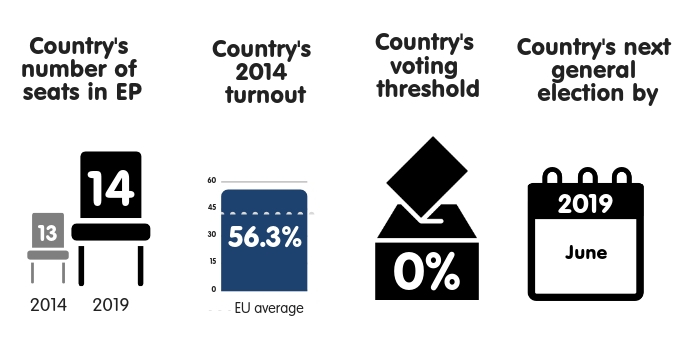

Projected voter turnout
At the 2014 EP election in Denmark, turnout was 56 percent: lower than five years earlier but still the country’s second-highest ever in EP elections. Even in that campaign, there had already been a remarkable change in the way that the European issues were discussed: no longer reduced to a “for” and “against” the EU, but increasingly touching on concrete problems with Denmark’s EU membership. This trend is set to continue this year, with turnout higher than last time and possibly even more than 60 percent. Brexit should also boost turnout, given the parallels between Denmark’s and the UK’s “opt-outs” within the EU. An unusually large number of influential national politicians have announced their intention to stand. It remains to be seen whether fringe parties will again prove more popular in EP elections than in national ones, as is often the case in Denmark.
Main battles in 2019
Immigration – and the EU’s political crisis around it – will likely become the central issue of the EP campaign. Danish society is increasingly veering towards anti-migration positions (with the debate centring on, for example, “welfare tourism”). This is reflected in the rising popularity of the country’s far right. Mainstream parties, including the Social Democrats, have also started competing on immigration-related issues. Most left-wing parties will likely draw attention to climate issues. Brexit’s implications for Denmark – and the desirability of holding an analogous referendum on the country’s EU membership – should also prominently feature in the debate. However, as a national parliamentary election is scheduled to take place in Denmark by June 2019, this could shift the political debate to national rather than European topics (particularly, if both elections occur in a short space of time).
The mainstream
The Liberal Party, the Liberal Alliance, and the Conservative Party form the centre-right ruling coalition, constituting the country’s current pro-European mainstream, along with the left-wing Danish Social Liberal Party and the Socialist People’s Party. Their positions on the EU differ but, overall, they are rather reticent on whether Denmark should integrate more closely with the EU. The Liberal Party competes for second place in the polls with right-wing nationalists from the Danish People’s Party, and is projected to gain three MEP seats, while the other two ruling parties are likely to win one MEP seat each at most. In normal circumstances, the Social Democrats – the biggest left-wing party in Denmark, and the leader in the polls since 2015 – would be widely viewed as a moderate party. However, after the migrant crisis and under the new leadership, it has veered towards anti-immigrant positions. The Social Democrats should win three MEP seats.
The Eurosceptics
The Danish People’s Party is the main representative of Denmark’s far right – and is currently the second-biggest party in the country’s parliament. It is an ally of the Sweden Democrats in the EP, Eurosceptic, and critical of institutionalised international cooperation more broadly. The party provides parliamentary support to the country’s centre-right ruling coalition but is not part of the government, largely because of their opposing views on EU issues. The Danish People’s Party is projected to obtain two or three MEP seats. The far-right Red-Green Alliance (which may secure a single seat) is also Eurosceptic, but mostly for reasons of democratic legitimacy rather than on anti-refugee grounds.
Estonia


Projected voter turnout
Estonians will choose just seven MEPs in 2019, comprising one of the four smallest delegations in the EP. Estonians consider EP elections to be a second order concern, as demonstrated by the much lower turnout in these votes (36.5 percent in 2014) than in national parliamentary elections (64.2 percent in 2015). Yet recent debates about Brexit and migration have boosted public interest in EU issues, which – together with the introduction of e-voting – could push turnout to more than 45 percent. However, the EP contest could also be overshadowed by a national parliamentary election planned for March 2019.
Main battles in 2019
As the campaign for the EP election will take place in a short period after the country’s parliamentary election, it may therefore be dominated by issues related to the domestic context, including negotiations on forming a government. At the same time, the composition of a coalition government may limit major parties’ room for manoeuvre (currently, there is speculation that one of the centre-liberal parties could form a coalition with the far right). As a result, the campaign may yet be dominated by European issues, such as the implications of Brexit for the future of the EU, the impact of the refugee crisis on solidarity in Europe, the EU’s competitiveness, and the EU-financed Rail Baltica project. Hotly debated national issues such as tax reform may also feature.
The mainstream
Two liberal parties – the Centre Party and the Reform Party – dominate Estonia’s political mainstream. Both are members of the ALDE liberal group in the European Parliament, and they currently jointly lead in the polls with the support of around 27-28 percent of voters each. In 2019 they look set to win two MEP seats each. The Centre Party has led the ruling coalition since 2016, while the Reform Party is the main opposition force. The former’s current MEP, Yana Toom, has announced her intention to seek re-election. It is widely expected that Andrus Ansip, current European commissioner for the digital single market and vice-president of the European Commission, may head the Reform Party list. The Social Democrats, the Centre Party’s current coalition partner, are a mainstream political force that is likely to win at least one MEP seat. All three parties are pro-European: in favour of ever closer union, trade liberalisation, the rule of law, and migration.
The Eurosceptics
The Conservative People’s Party is the only genuine far-right party in Estonia. Its popularity has skyrocketed in the last four years. From less than 5 percent in the polls before 2015, it now stands at almost 20 percent today. If it maintains this level of support, this anti-European (not just Eurosceptic) party will claim one or two MEP seats – and may also enter the next national government. The party opposes further EU integration, migration, and Brussels’s focus on the rule of law. It claims to defend the sovereignty of states and national cultures.
Finland

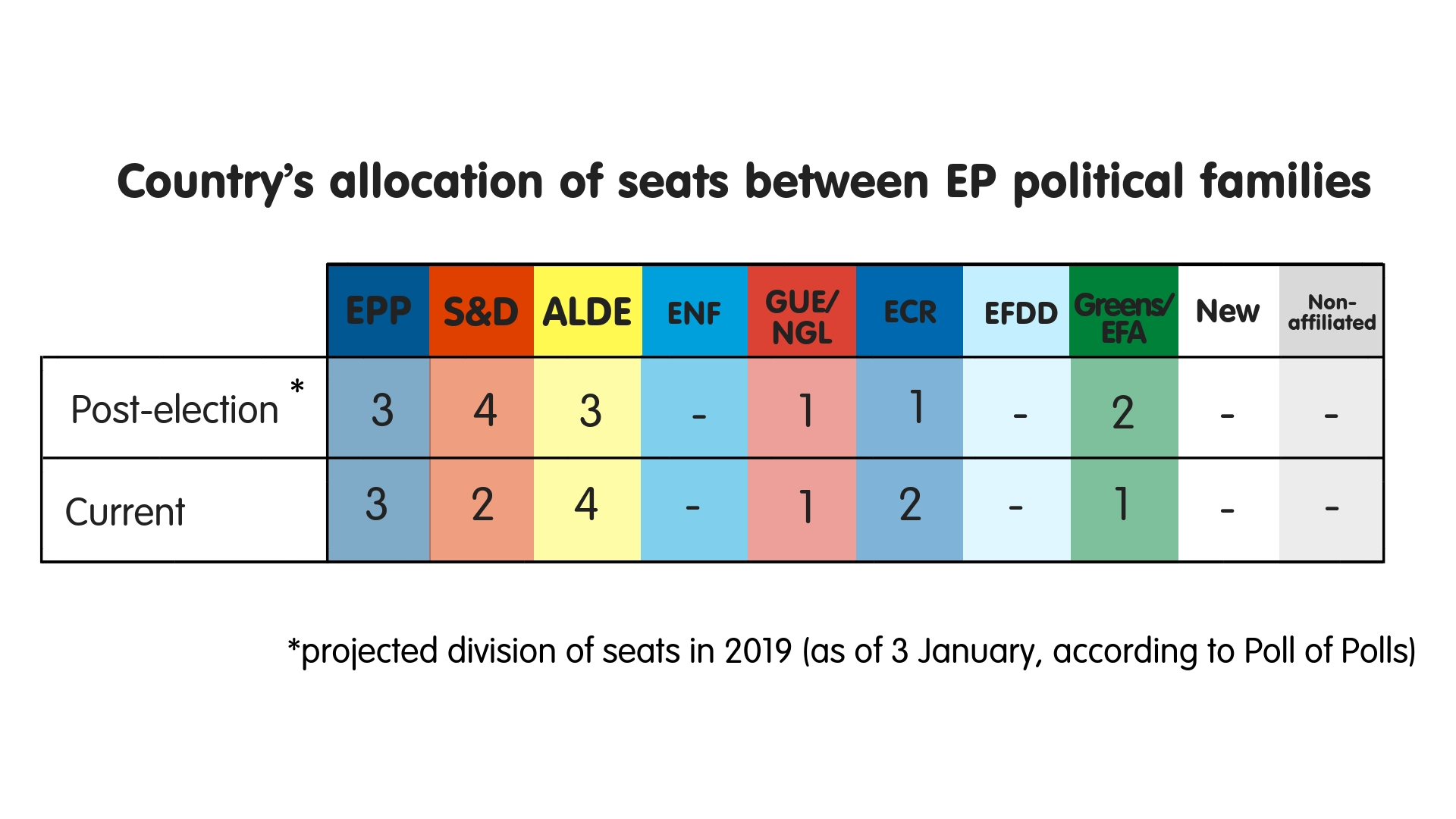
Projected voter turnout
Finland’s turnout at EP elections has been consistently below the EU-wide average (41 percent in 2014). EP contests tend to generate political debate and media interest only in the weeks leading up to the election. The factor likely to have the most significant effects on the 2019 vote is Finland’s national parliamentary election in April 2019. Some of Finland’s main parties will, therefore, be engaged in coalition talks during the EP campaign. Finns will be going to the polls in two major elections in less than six weeks. However, whether and how this will affect the electoral dynamics and turnout remains to be seen. Interest in EU affairs may rise slightly due to Finland’s EU presidency, which starts in mid-2019.
Main battles in 2019
According to Eurobarometer, the topics that Finns see as crucial European issues are counter-terrorism, climate policy and environmental protection, and security and defence policy. However, the national parliamentary election could also have a significant impact on campaign topics. The country’s place and role in the EU, and the future of the EU more broadly, may receive additional attention due to the preparations for Finland’s EU presidency. With the exception of the far-right Finns Party and the splinter party Blue Reform, Finns have a moderate attitude towards migration. All major parties would be ready to consider improving the prospects for legal migration into the EU for economic and humanitarian reasons.
The mainstream
Two centre-right parties – the National Coalition Party and the Centre Party – and Blue Reform together form the current ruling coalition. The first two (members of the European People’s Party and the liberal ALDE grouping respectively) belong to Finland’s pro-European mainstream and are projected to win three or four seats each. Blue Reform includes moderate former members of the Finns Party but it is currently polling at just 1-2 percent of the vote and has no chance of winning any MEP seats. On the other side of the political spectrum, the Social Democratic Party (a member of the Socialists and Democrats EP group) is one of the three major parties in Finland. Polling at 20-22 percent, it is also projected to win three or four MEP seats. The Green League, supported by 11-14 percent of voters, should secure one or two seats. The centre-right Swedish People’s Party and the Christian Democrats are unlikely to gain any seats.
The Eurosceptics
The Finns Party has splintered during the current parliamentary term. After the departure of more moderate members, who created Blue Reform and joined the ruling coalition, the Finns Party has drifted even further towards the radical right. It is a member of the European Conservatives and Reformists, like other Eurosceptic parties from Sweden and Denmark. Anti-refugee, Eurosceptic, and increasingly anti-globalisation, it has the steady support of around 10 percent of the electorate. This should provide it with at least one MEP. Finland’s radical (but still largely pro-European) left is represented by the Left Alliance (a member of European United Left–Nordic Green Left group). It can also expect to win one MEP seats. There is, however, no prospect of cooperation between the two, despite the fact that they both criticise the current state of the EU.
France

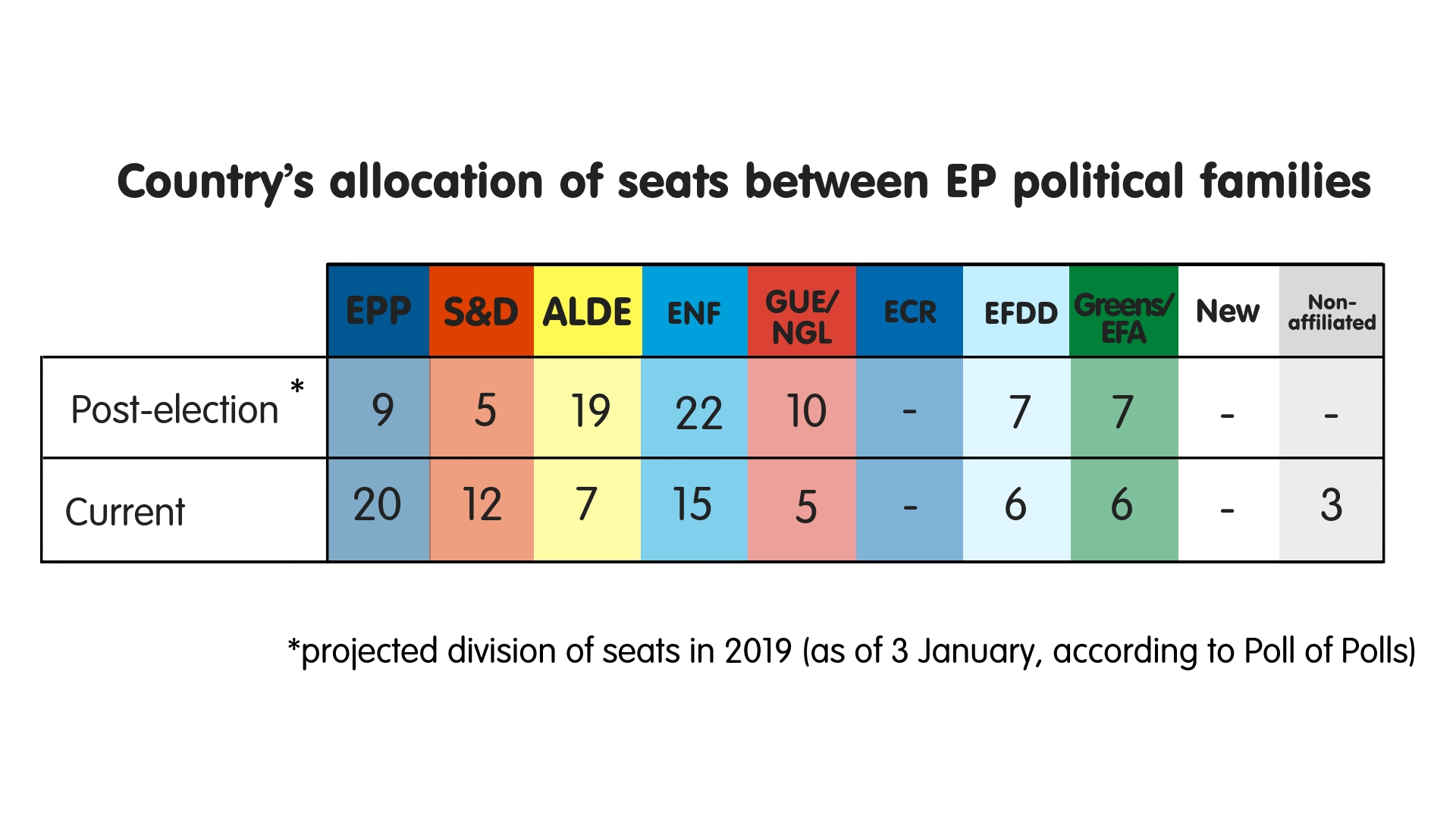
Projected voter turnout
In France, EP election turnout has always been just below the EU average – around 40 percent on the last two occasions. Turnout is expected to increase to 43-45 percent in 2019, mostly due to the Europeanisation of several national issues, such as migration and the economy, under President Emmanuel Macron. As usual, many voters will treat this election as a referendum on the government’s policies (to the benefit of far-right and far-left anti-European parties), while many others will vote for their preferred smaller parties (such as the Greens), refraining from the kind of tactical voting more common in the country’s presidential elections. The 2018 reform of the electoral system ended France’s division into eight constituencies for the EP election, which should facilitate a nationwide debate during the campaign.
Main battles in 2019
Macron’s credibility for the rest of his presidential term (which runs until mid-2022) will be at stake in the 2019 EP election. Following the gilets jaunes (yellow vests) protests, France will likely fail to meet some of the Maastricht criteria – notably, the deficit-to-GDP ratio limit of 3 percent in 2019. Beyond this, the campaign of his La République En Marche! will probably address social issues and aim to respond to the demonstrations. The protests will have repercussions for the broader themes of the campaign, as well as for the French political landscape: the possibility of a gilets jaunes party running for the 2019 EP election should not be discounted. Macron has recently adjusted his strategy of confrontation with anti-European parties and is now trying to redirect his agenda towards the defence of Europe’s sovereignty. Whether La République En Marche! or Marine Le Pen’s party wins the election could have significant political consequences. Apart from the president’s capacity to govern France, core themes of the election are likely to be immigration (for the right and the far right), as well as growth and jobs (for the left and the far left).
The mainstream
Since the 2017 presidential and legislative elections, La République En Marche! (in alliance with the like-minded MoDem) has dominated France’s political centre. Mirroring the recent decline in the president’s popularity, La République En Marche! is projected to come second in the 2019 EP election in France. Macron’s party recently announced a coalition with ALDE with the aim of uniting European progressives, reaffirming its strong ties with Ciudadanos in Spain. In turn, the two parties of the country’s former mainstream – Les Républicains and the Socialist Party – are struggling to find a new identity and will largely consider this election to be something of a survival test. Les Républicains are now divided between a moderate faction, which aligns with the government on European issues, and a more radical one, led by party president Laurent Wauquiez, which flirts with right-wing rhetoric on migration and identity. Les Républicains may win nine MEP seats while the Socialists risk winning only a few seats, polling at barely more than the 5 percent threshold. The Greens – who are pro-European – should also gain six or seven seats.
The Eurosceptics
Rassemblement National (formerly the Front National) dominates the Eurosceptic camp in France and is projected to win the EP election. Like Italy’s Lega (with which it maintains close links), Le Pen’s party will campaign for border controls, greater national sovereignty, and a “union of European nations”. It is projected to win around 22 MEP seats. Nicolas Dupont-Aignan’s Debout La France will try to draw support from “all the country’s patriots and republicans”, hoping to take some votes from both Le Pen’s party and the divided Républicains, and to pass the 5 percent threshold. Jean-Luc Mélenchon’s La France Insoumise – polling at 11 percent – has established a hegemonic position on the country’s far left, largely due to the decay of the Socialists. It is projected to win ten seats. While there is no possibility that the country’s far right and far left will agree on a common agenda for Europe, there are remarkable parallels between them on economic issues (anti-trade; critical of the euro) and their use of anti-establishment rhetoric.
Germany
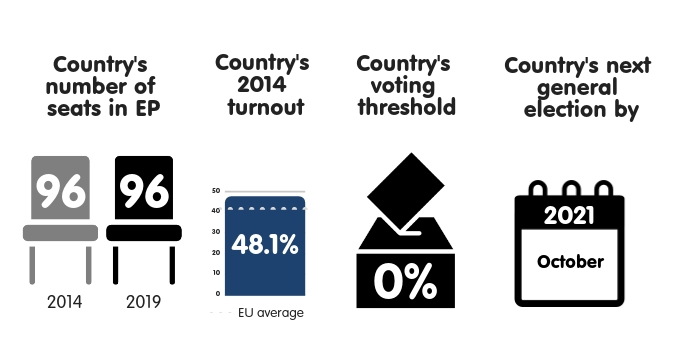
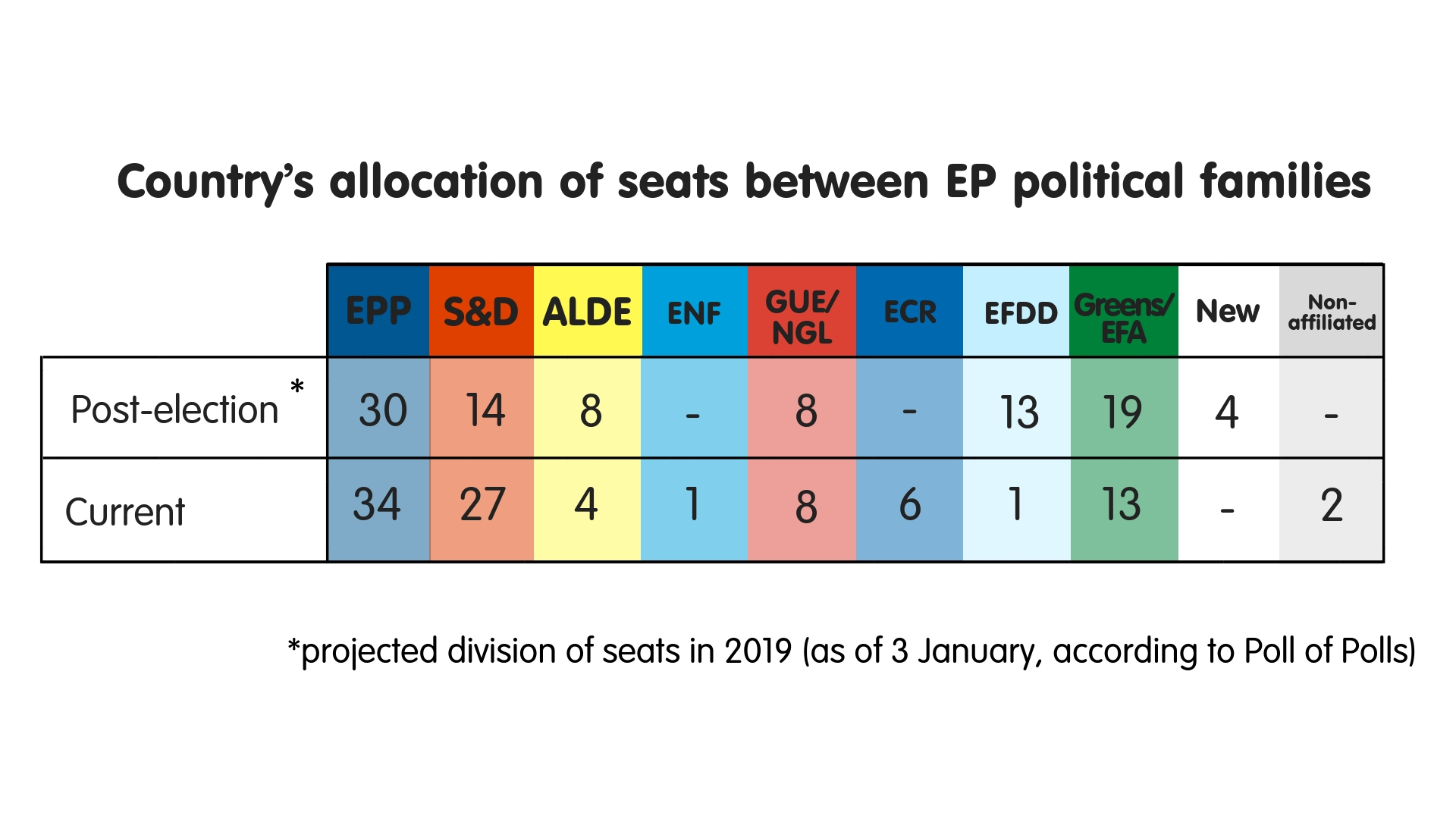
Projected voter turnout
Voter turnout in Germany’s EP elections stood at 43 percent in 2004 and 2009, rising to 48 percent five years ago. The profile of Martin Schulz as Spitzenkandidat of the Socialists and Democrats EP group, and the fact that European People’s Party Spitzenkandidat Jean-Claude Juncker speaks German, helped mobilise German voters. There is a sense of responsibility associated with the EP elections among large parts of the German political class, which reflects its traditional belief in the EU system. Although Germany has more MEPs than any other country (as it has the largest population in the EU), the German public still perceives EP elections as less important than national or regional ones – meaning that national issues usually dominate EP campaign debates. This trend might continue in 2019, especially given uncertainty over the fate of the current ruling coalition led by Chancellor Angela Merkel, and important upcoming elections in the eastern states of Brandenburg, Saxony, and Thuringia. Turnout in the 2019 EP election is projected to be at around 43 percent. As there is no electoral threshold in the vote and the whole country constitutes a single constituency, relatively small parties will have an opportunity to win MEP seats.
Main battles in 2019
The main political battle in Germany’s EP election is likely to centre on domestic issues. As state elections traditionally have an impact at the federal level, the votes in Brandenburg, Saxony, and Thuringia will be important tests of support for Alternative für Deutschland (AfD). The party has its largest potential supporter base in eastern Germany, as does Die Linke. Germany’s party landscape is currently undergoing major shifts: seven parties have been represented in the Bundestag since the 2017 federal election. The EP election will signal how these changes are unfolding. Migration and border controls will be among the most high-profile topics of debate, largely due to the anti-refugee rhetoric of the far right in recent years. The campaign is also likely to feature issues such as the euro, trade, and other features of economic and social policy; climate change; challenges to European security; and the EU’s values.
The mainstream
While there is considerable variation between German parties’ policy positions, all mainstream parties want to work within the EU’s institutional set-up and the euro. The members of Germany’s governing coalition have struggled in the polls in recent months. The Christian Democratic Union/Christian Social Union (CDU/CSU) won 33 percent of the vote in the 2017 federal election, and is currently polling at around 30 percent. According to current projections, the CDU/CSU will lose four seats, bringing its total to 30, in this year’s EP election. Although it was disappointed with its vote share of 20.5 percent in 2017, the Social Democrats (SPD) are now polling at just 14-15 percent – putting them in fourth place, just ahead of the AfD, but behind the Green Party’s 20 percent. This shift in German politics is likely to have a significant effect at the European level: the SPD is projected to lose more than ten seats, bringing its total to 14. The Green Party is projected to capitalise on its improving fortunes at home, gaining 19 seats in the EP election. The Free Democratic Party, which returned to the Bundestag in 2017, is currently polling at 9 percent and is likely to boost the ALDE EP group’s seat tally by four.
The Eurosceptics
The AfD – which is Eurosceptic, anti-immigration, anti-Islam, nationalist, and deeply conservative – represents Germany’s far right in the Bundestag. A recent draft of the AfD’s manifesto for the EP election suggests that it is pushing for Germany to leave the EU if it does not succeed with fundamental reform in the next electoral cycle. But the party is still debating this position. In recent months, the AfD’s share of the vote has levelled off at 15 percent in the polls – higher than the record 12.6 percent it won in the 2017 federal election (which gave it 91 seats in the Bundestag). For now, with the Europe of Freedom and Direct Democracy EP group holding only one seat, the AfD does not play a role in the European Parliament. This year, the party is projected to win at least 13 MEP seats. On the far left, Die Linke has a populist bent, despite generally focusing on social Europe and a humanitarian approach to asylum and migration policy. The party advocates an alternate security system to NATO – with some of its members supporting a softer policy on Russia – but has not abandoned its overall commitment to EU institutions and the euro. Polling at 9 percent, Die Linke is likely to retain its eight MEP seats. The party is currently undergoing another round of internal competition over its overall direction: in 2018 its leader in the Bundestag, Sahra Wagenknecht, became one of the founders of the aufstehen movement, which is inspired by La France Insoumise and British Labour Party leader Jeremy Corbyn’s Momentum campaign.
Greece

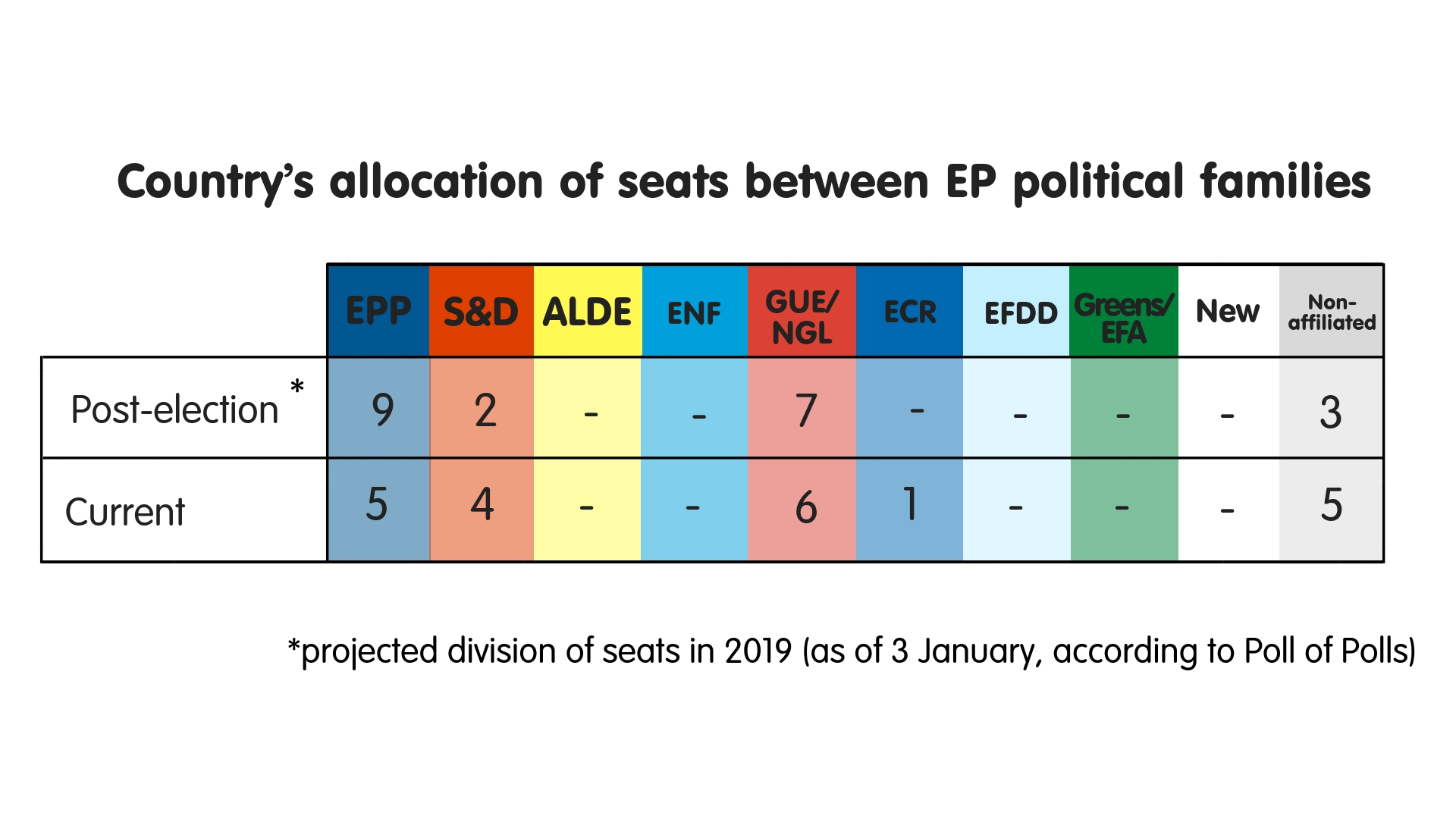
Projected voter turnout
Greece is one of four EU member states that has compulsory voting, which partly explains its high (if declining) turnout at EP elections. The 2019 EP election will coincide with regional and municipal polls in Greece, which should ensure a high turnout. There is even a possibility that the government, led by the left-wing Syriza, may call a snap parliamentary election the same day in hope of remaining in power nationally. The party expects that voters upset with austerity will cast protest votes in the EP election, but not the national one. If that happens, it should boost turnout even further – to the benefit of pro-EU parties, whose supporters are relatively unlikely to turn out.
Main battles in 2019
Given the timing of regional and municipal elections, and even the chance of a general election the same day, the campaign may focus even more than usual on local and national issues. Still, there is also likely to be a focus on economic issues, including Greece’s cooperation with its creditors, the prospect of relaxing austerity measures, and Europe’s economic direction more broadly. Syriza will campaign for less austerity and higher taxes on companies. The conservative New Democracy (the main opposition party, which is leading in the polls) may campaign for less taxation, more investment, and more Europe. The question of EU migration policy will be debated too, particularly in the context of expectations of greater cooperation with other EU countries on the issue. The 2018 deal between Greece and North Macedonia, settling a decades-long dispute over the latter’s name, is also a hotly debated and divisive issue.
The mainstream
New Democracy – a member of the European People’s Party – is expected to win the EP elections in Greece, obtaining nine seats. Syriza – which is often seen externally as a populist left-wing party and is a member of European United Left–Nordic Green Left – currently occupies the centre-left of the political spectrum in Greece. It should finish second and gain seven seats. Both parties favour deeper European integration and focus on strengthening the rule of law across the EU. However, the former is divided on the issue of migration, and the latter on trade liberalisation. Another mainstream party that could secure some representation in the next EP is the centre-left Movement for Change, a member of the Socialists and Democrats group, and Syriza’s arch-rival. It should win two EP seats. Former minister of finance Yanis Varoufakis will seek election to the EP, but will run in Germany.
The Eurosceptics
Two Eurosceptic Greek parties are expected to win seats in the EP in 2019. Golden Dawn – a neo-Nazi, anti-EU outfit – could win two MEP seats, just as it did in 2014. The Communist Party of Greece – which advocates for the country’s withdrawal from the EU – should gain one seat. There is no plausible way in which these two Eurosceptic parties will collaborate. However, they share many key standpoints, opposing: trade liberalisation; Brussels’s focus on the rule of law; ever closer union; and new legal pathways for immigration.
Hungary
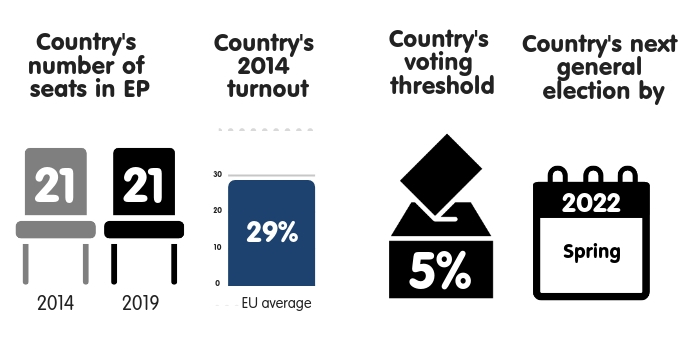
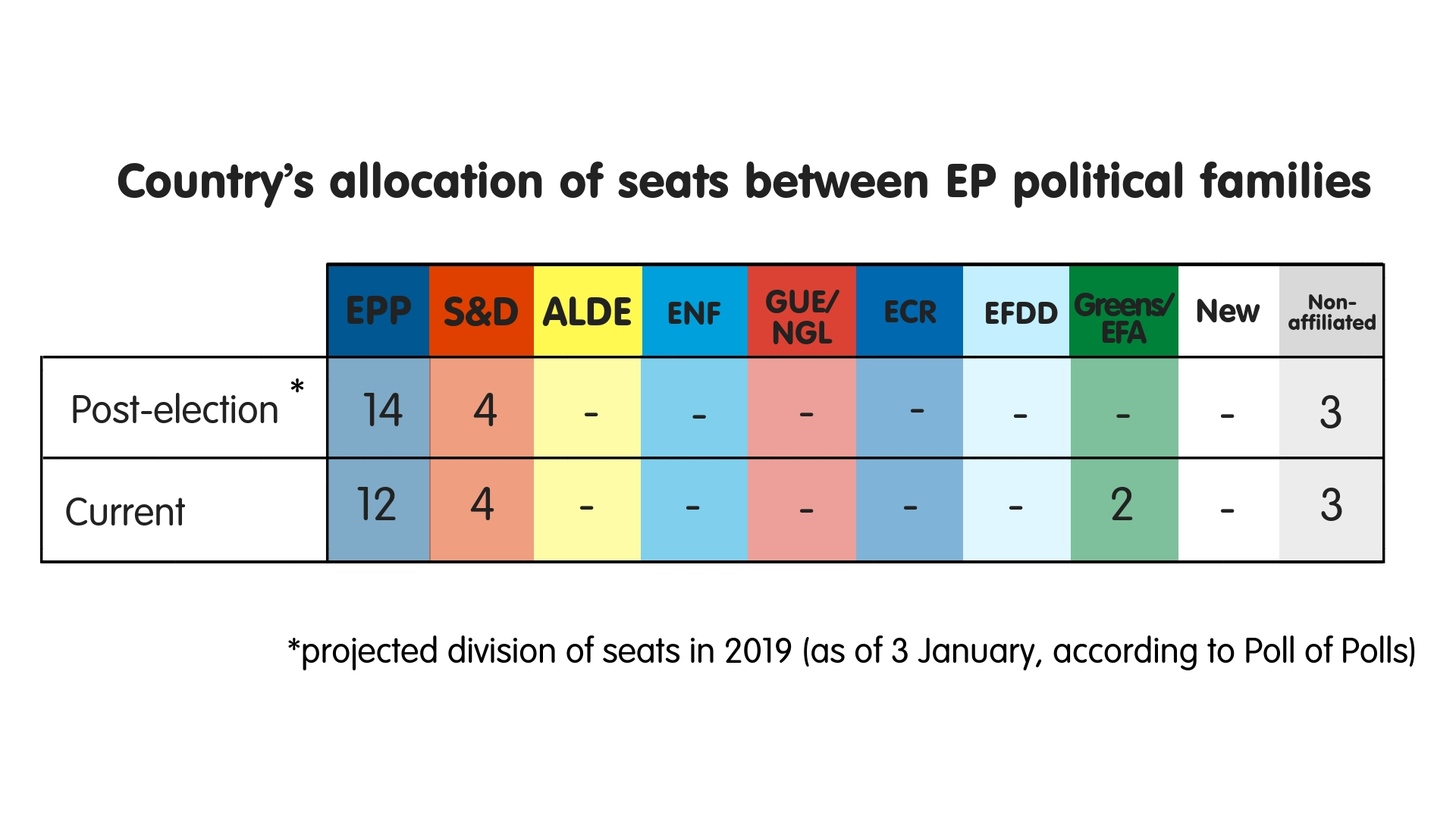
Projected voter turnout
EP elections attract significantly lower interest in Hungary than national or local elections: they had a turnout of 36 percent in 2009 and 29 percent in 2014. Most Hungarian MEPs, with some notable exceptions, are not widely known at home. Hungarians can only vote for lists at EP elections, not for individual candidates. Still, this time turnout may be higher than usual, largely due to Prime Minister Viktor Orbán’s transnational efforts to frame the election as a referendum on whether pro- or anti-migration forces will dominate the EU in years to come. The ruling party seeks to strengthen its legitimacy in Europe, including on controversies about the rule of law in Hungary. This is also the main reason for ruling party Fidesz’s recent proposal to grant voting rights to Hungarian citizens who live outside the EU, including those in Serbia and Ukraine. As it stands, increased participation in the EP election could favour Fidesz. Current polls suggest it will receive the support of 48-59 percent of active voters, or 23-41 percent of the entire electorate.
Main battles in 2019
The government will make migration and the call to change the current EU leadership the central issues of the EP election campaign. According to a February 2018 survey released by Századvég, Fidesz’s think-tank, almost 70 percent of citizens consider the flow of illegal immigrants into their country to be worrying. The same share of the population is satisfied with the efforts the government has made to address the problem. This puts opposition parties in a very difficult position. They may try to focus attention on other issues, such as corruption cases within the government. These include cases on the use of European funds and a related initiative for Hungary to join the European Public Prosecutor’s Office – which Orbán’s government avoided in 2017 on the grounds that it hampered the country’s sovereignty.
The mainstream
The right-wing Fidesz completely dominates the Hungarian political scene. Current polls project that it will win 12-14 MEP seats in 2019, and that its main rivals – the far-right Jobbik and the social democratic MSZP – will gain just 12-15 percent and 10-16 percent of the vote respectively, or 2-3 MEPs each. The centre-left Democratic Coalition and the green Politics Can Be Different are projected to win 6-10 percent (1-2 seats) and 2-4 percent (0-1 seat) each. Fidesz is a member of the European People’s Party group and signed up to support Manfred Weber as its Spitzenkandidat – albeit reluctantly, as Weber voted in favour of the EP’s Sargentini report, which harshly criticised the Orbán government for breaching the rule of law. It remains to be seen whether Fidesz will remain in the EPP after the 2019 vote or will join a new anti-European bloc. If the party was excluded from the EPP before May 2019, or had its membership rights suspended, this could be an important shock in the campaign. However, this currently looks unlikely and it is unclear what its effects would really be. Momentum – a new, pro-European centrist party established in 2017 – is polling at 3-5 percent of the vote, but its urban and educated supporters may mobilise at the 2019 EP election, potentially enabling the party to secure one MEP seat.
The Eurosceptics
Jobbik broke up after the 2018 national parliamentary election. Its former leader, Gábor Vona, stood down. The party’s new leadership continues Vona’s strategy of deradicalising the party’s line and adopting a more moderate tone on the EU (for example, it no longer argues for Hungary to leave the EU). More extremist former members of Jobbik have established a new party, Our Home Movement, which polls at just 1-2 percent currently but could eventually draw some support away from Jobbik – although with little chance of passing the 5 percent threshold needed to claim at least one MEP seat. Although anti-immigrant and Eurosceptic, Jobbik is a staunch critic of the Orbán government, so there is no possibility of an alliance between the two.
Ireland


Projected voter turnout
Participation in EP elections in Ireland is regularly higher than the EU average. This should also be the case this year, with turnout almost certain to exceed 50 percent, and possibly close to 60 percent. There are three good reasons to expect a high turnout. Firstly, the EP election will coincide with local elections across the country. Secondly, the stakes are slightly higher this time following an increase in the number of Irish MEPs, from 11 to 13. And Brexit has already had the effect of bringing greater awareness of EU issues to the Irish public. This renewed focus on Europe should drive mainstream parties to appoint relatively high-profile candidates.
Main battles in 2019
There is no scarcity of European topics that may feature in Ireland’s 2019 EP campaign. The main parties will likely discuss ways to ensure that taxation remains a national competence rather than a European one, resisting proposals to introduce an EU digital tax. As usual, the future of the EU’s common agricultural policy will remain a concern for the country’s rural voters. European defence cooperation will be an important issue for voters worried about its implications for Ireland’s neutrality. And, last but not least, the country’s post-Brexit future will be the centre of attention, given the sense that without the United Kingdom (with which Ireland shared many key interests in the EU) Ireland could become more exposed within the EU – particularly with respect to the single market, trade, taxation, and other economic issues.
The mainstream
Ireland’s three largest parties – Fine Gael, Fianna Fail, and Sinn Féin – should between them take 11-12 MEP seats, potentially leaving just one or two to smaller parties or independent candidates. The ruling Fine Gael, together with the main opposition, Fianna Fail, dominate the centre-right. The former is a member of the European People’s Party and considers German Chancellor Angela Merkel’s Christian Democratic Union to be its closest European ally. The latter is formally a member of the ALDE group but feels closest to other conservative parties, such as Les Républicains in France and the People’s Party in Spain. Both parties are in favour of further European integration, EU trade liberalisation, the rule of law, and migration. A fourth Irish mainstream party, Labour, was once the third-largest party and the main party of the left in Ireland, but lost support after its role in the ruling coalition that imposed austerity measures after the eurozone crisis. It currently has no MEPs and may struggle to change this in 2019.
The Eurosceptics
Sinn Féin is a party of the left and a member of GUE/NGL in the EP. It currently polls third, at 23 percent, which should give it three MEPs. Sinn Féin is critical of trade liberalisation and of ever closer union, and maintains loose links with Syriza and Podemos. But it is still a long way from being a far-left party, and has adopted a reformist approach to Europe. It will almost certainly emphasise the issue of protecting Ireland’s neutrality. It may also campaign on introducing a fairer tax system and its usual ticket of a “Europe of equals”. Still, all its positions on these topics have a clear pro-European dimension. Despite Brexit, there is no serious Eurosceptic voice in Ireland’s public debate. A new anti-EU party called Irexit Freedom to Prosper has emerged recently and will enter a candidate in the 2019 EP election – but it is a fringe initiative whose chances of success are close to zero.
Italy
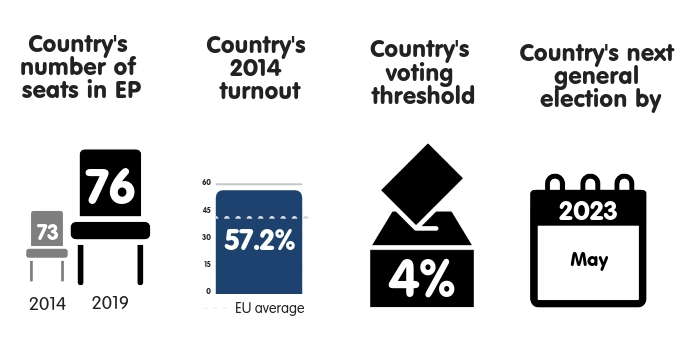

Projected voter turnout
Italy’s turnout in the 2019 EP election is expected to be around 50 percent, significantly less than the 73 percent for the last national parliamentary election. This is not because European issues lack salience in the Italian public debate. On the contrary, topics such as tension between the government and the European Commission on the country’s 2019 budget, the future of the EU’s migration policy, and general dissatisfaction with EU integration are currently among Italian voters’ leading concerns. This makes it virtually impossible to distinguish between purely national and European topics. However, amid something approaching a permanent electoral campaign in Italy, the EP election risks becoming a referendum on the government’s approach to the EU, thereby largely mobilising its greatest critics and supporters rather than the less partisan sections of the electorate.
Main battles in 2019
All the three main parties – Lega, the Five Star Movement, and the Democratic Party (PD) – will likely campaign for an overhaul of the mechanisms of the EU. Still, each of them will frame this problem differently. With its leader, Matteo Salvini, part of a sovranista alliance that includes Hungarian Prime Minister Viktor Orbán and French politician Marine Le Pen, Lega will emphasise the need for a common asylum policy, strongly linking migration to domestic and European security problems. The Five Star Movement will focus more on economic issues: putting an end to the EU’s austerity policies, making sure that national sovereignty has precedence over globalisation, and calling for a major reform of the EU’s trade agreements. The PD – for which this election is an opportunity to regain some popular support – will likely provide a more pro-European message, although this risks coming across as detached from popular sentiment. The PD’s upcoming internal primaries will determine its leadership for the 2019 EP election (it currently appears unlikely that the party will split before then).
The mainstream
It is hard to talk of a “mainstream” in Italy, given the radical overhaul that the country’s political scene has experienced in the past few years, with the decline of the established centre-left PD and centre-right Forza Italia, and a surge in the popularity of the right-wing Lega and the anti-establishment Five Star Movement. The latter two parties now form the governing coalition and, taken together, have the support of almost 60 percent of voters. In turn, support for the PD – a member of the Socialists and Democrats in the EP – has levelled off at only around 18 percent, which should give it 16 MEP seats this year, down from 31. Silvio Berlusconi’s Forza Italia – a member of the European People’s Party – dominated the country’s politics a decade ago but is now languishing at a mere 8-10 percent and looks set to win no more than seven MEP seats, down from 15. Yet Berlusconi’s recent announcement that he will run for an MEP seat may change this outlook.
The Eurosceptics
Italy’s two largest parties are both deeply Eurosceptic, albeit in different ways. The Five Star Movement is polling in second place after winning last year’s general election. While a member of the Eurosceptic Europe of Freedom and Direct Democracy group in the EP, its anti-trade and anti-austerity agenda is in many respects much closer to the European radical left. Large parts of the Five Star Movement electorate have been disappointed with its coalition with the far right. This may prompt the Five Star Movement’s leadership to form a coalition of European anti-establishment parties ahead of the 2019 election, as its recent interactions with Poland’s right-wing Kukiz’15 and Croatia’s Human Shield may suggest. In turn, Lega is a traditional Eurosceptic right-wing party that also serves as a platform for more radical representatives of the far right (such as supporters of the “Brothers of Italy”), who may also cross the 4 percent threshold. In 2019 Lega will campaign in a pan-European coalition of right-wing Eurosceptics, and is poised for a clear victory – possibly becoming one of the two biggest national parties in the next EP, alongside Germany’s Christian Democratic Union/Christian Social Union.
Latvia

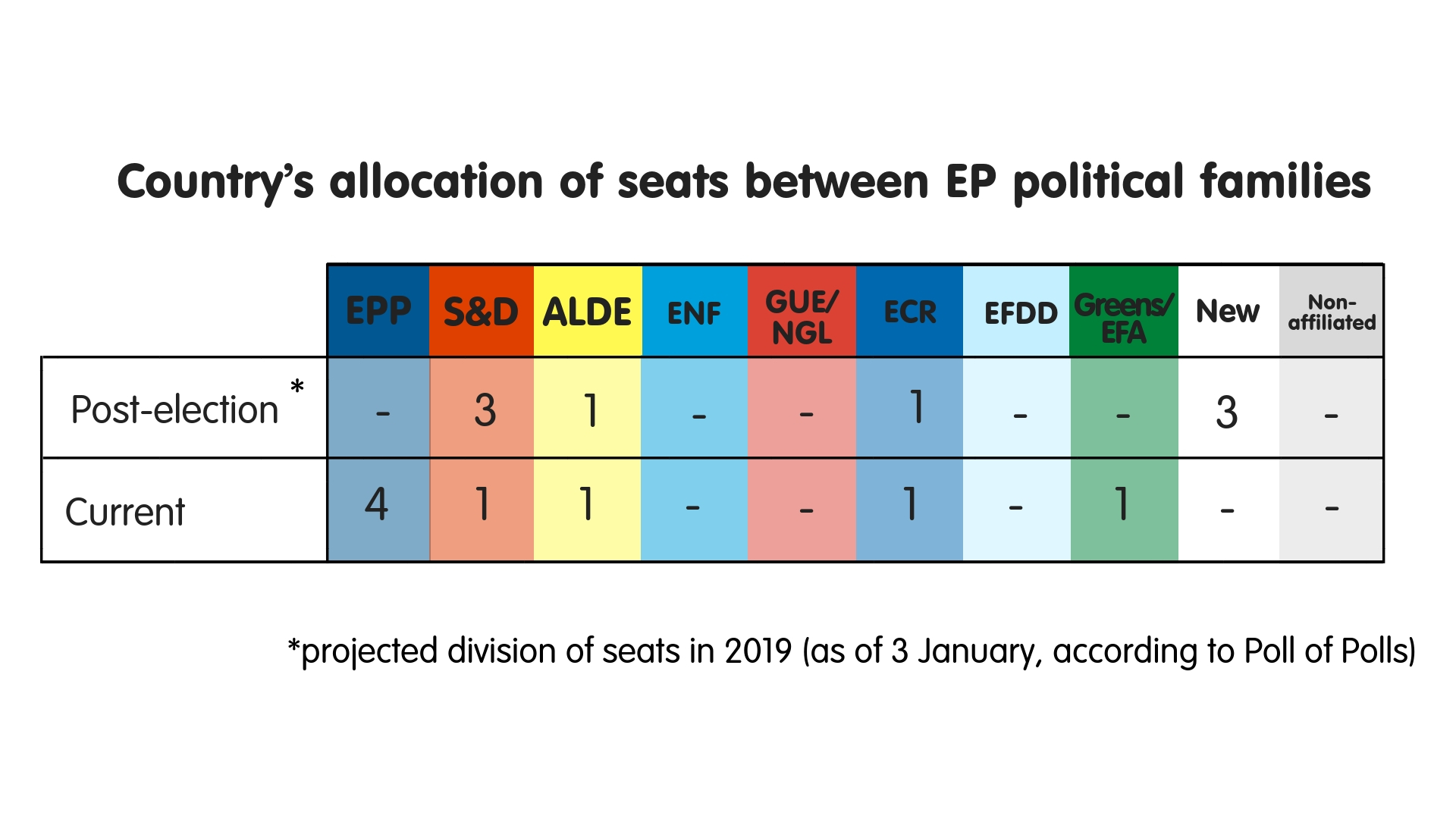
Projected voter turnout
Around 40 percent of Latvian voters are expected to participate in the 2019 EP election, significantly more than the 30 percent in 2014 but short of the 54 percent five years before that. EP elections are less prominent in Latvia than national parliamentary or municipal ones. At the same time, however, MEP candidates are usually high-profile politicians, such as former prime ministers or ministers of foreign affairs. As there are only eight seats at stake, personalities matter and people do not vote for parties per se. This should hold true in the 2019 election, particularly given that the October 2018 general election ejected from office many prominent politicians from the previous government who might now be tempted to seek MEP seats. If the catch-all Who Owns the State? (KPV LV) party runs a dynamic campaign, as it did in the national election, this should further increase media and voter interest in the EP election.
Main battles in 2019
The EU’s post-2020 Multiannual Financial Framework should feature strongly in the campaign, given that the ongoing negotiations over it could have a big impact on Latvia’s economic development. There will also be a debate over security and Russia, given the unstable geopolitical situation and the pro-Kremlin positions of the Latvian left. Migration and refugees were not hot topics during the last general election but MEP candidates searching for publicity may raise them. Apart from these issues, the battle will largely be about the mainstream coming under increasing pressure from two emerging parties: KPV LV and the New Conservative Party, both of which will appeal to voters who are disillusioned with EU membership and blame Latvian politicians for this perceived setback.
The mainstream
All political parties represented in the new Latvian parliament are pro-EU. The centre-right parties Unity and Development/For! are EU federalists, as is the centre-right, pro-Russian, and social democratic Harmony. The Union of Greens and Farmers, the New Conservative Party, and the National Alliance support EU intergovernmentalism. In October 2018, for the third time in less than ten years, Harmony won the largest vote share of any party in the national election but was again excluded from negotiations on the formation of a new government. The party is a member of the Socialists and Democrats in the EP even though it represents conservative left politics. It may win as many as three MEP seats this year, up from its current one. In turn, Unity – which dominated the country’s political scene for more than a decade – is now in decline and may lose all three of its MEP seats. The liberal and pro-European Development/For! may become one of beneficiaries of Unity’s decline, helping it obtain one MEP seat. The Union of Greens and Farmers should also win one MEP seat.
The Eurosceptics
Latvia’s political scene is very dynamic but has not seen the emergence of Eurosceptic parties. KPV LV, which finished second in the general election, has so far managed not to express its opinion on the EU or foreign policy matters in general. Like the New Conservative Party, the KPV LV is a dark horse in the 2019 contest; each hopes to win at least one MEP seat. The KPV LV, established in 2016, is an anti-establishment party that often veers towards right-wing populism, akin to Poland’s Kukiz’15. The New Conservative Party, formed in 2014, is pro-European and intergovernmentalist, which could make it a potential ally for Hungarian Prime Minister Viktor Orbán and Polish leader Jaroslaw Kaczynski in the EU. One of Latvia’s mainstream parties, National Alliance, is already close to Poland’s Law and Justice, as part of the European Conservatives and Reformists group in the EP; it expects to retain its one MEP seat.
Lithuania
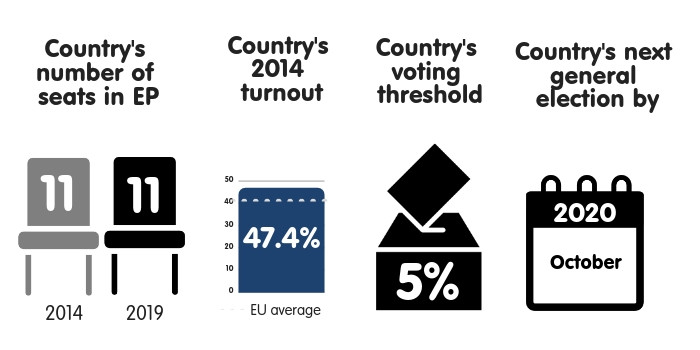

Projected voter turnout
In 2009 Lithuania was the EU member with the second-lowest turnout in EP elections: 21 percent. This reflects the low level of importance Lithuanian voters attribute to these votes. Still, turnout should be 40-50 percent in 2019, because the EP election will coincide with the second round of the presidential election. The EP and presidential elections coincided four years ago, which raised turnout to 47 percent. However, this also means that the political debate ahead of the EP election will focus almost exclusively on domestic issues. The higher the turnout, the more likely it is that votes will be distributed across a large number of parties.
Main battles in 2019
The presidential election is likely to dominate the EP election campaign. Some political parties, particularly the right-wing/far-right Order and Justice party, may adopt nationalist rhetoric and campaign intensively against the EU’s plans for deeper integration. Nonetheless, as most presidential candidates remain strongly pro-European, it is likely that their discourse will overshadow any radical positions. Due to their absence on the Lithuanian political agenda, immigration issues are unlikely to feature in the electoral campaign.
The mainstream
Two mainstream parties dominate Lithuania’s political scene. The ruling Lithuanian Peasants and Greens party (a member of the Greens/European Free Alliance group in the EP) currently polls at 17-25 percent and looks set to win 2-3 MEP seats. The main opposition party, the centre-right Homeland Union–Lithuanian Christian Democrats (a member of the European People’s Party in the EP), leads the polls. But it has only a minimal lead over the ruling party, meaning it is likely to win just 2-3 MEP seats. Overall, both parties are pro-European but they are internally divided on migration and ever closer union. Several smaller parties should get one seat each. These include the Lithuanian Social Democratic Party and Order and Justice (both junior members of the current coalition), as well as Electoral Action of Lithuanian Poles, the Movement of Lithuanian Liberals, and the Lithuanian Centre Party.
The Eurosceptics
As Lithuania has one of the most pro-European societies in the EU, there is little room for anti-European rhetoric in the public debate. This is why parties most often campaign on a socio-economic rather than an anti-European (or identity-based) platform. The Labour Party – which has a populist bent despite being centrist and a member of the liberal ALDE grouping – is the only major party to have used anti-immigrant rhetoric. Order and Justice tends to adopt far-right positions and is a member of the anti-establishment, far-right Europe of Freedom and Direct Democracy EP group. It is projected to win 1-2 MEP seats. The Lithuanian Centre Party, another Eurosceptic group, aims to win one seat. Finally, Electoral Action of Lithuanian Poles is a member of the European Conservatives and Reformists and is close to Poland’s Law and Justice. It may win one seat.
Luxembourg

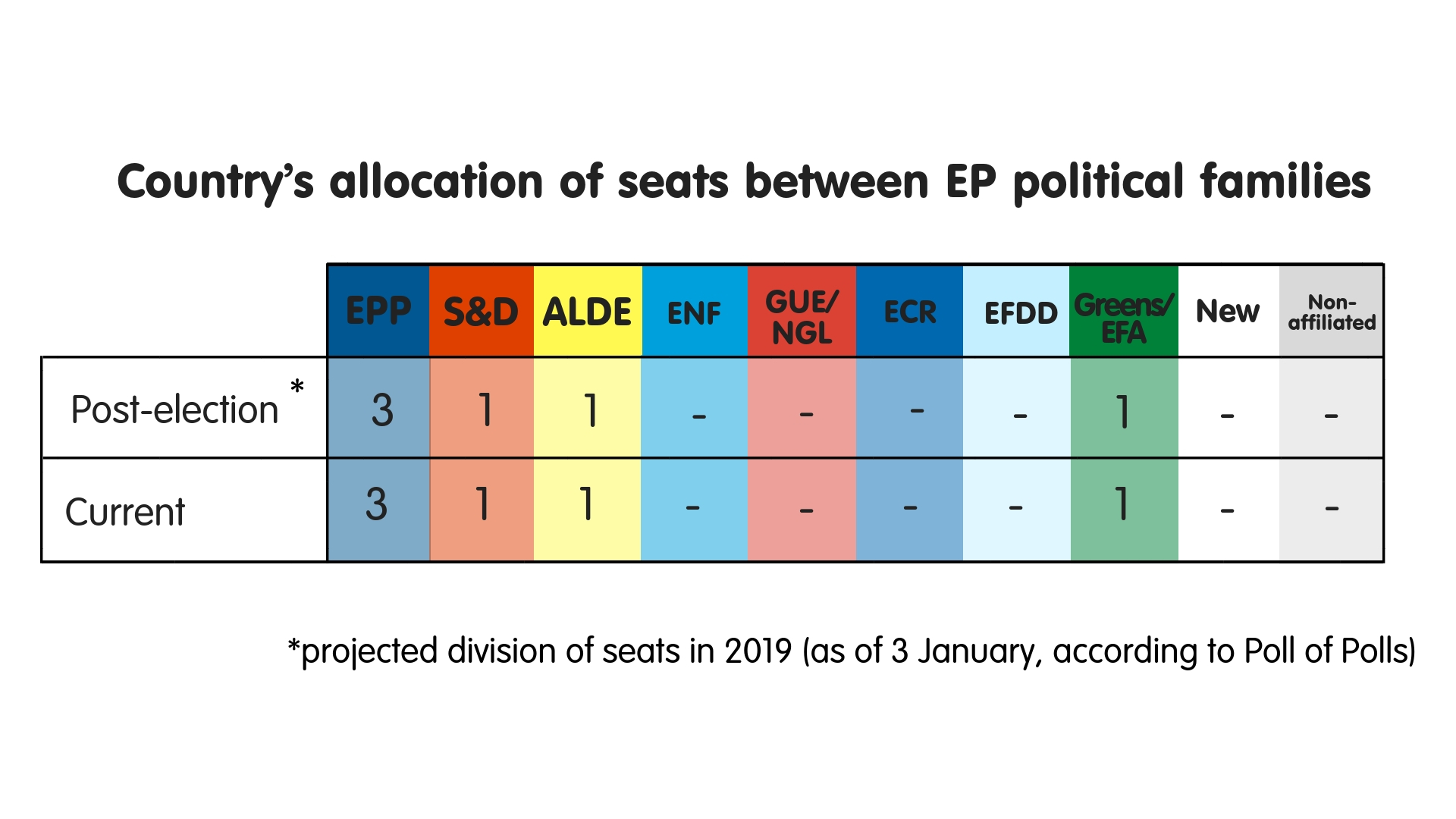
Projected voter turnout
As citizens are obliged to vote in Luxembourg, turnout is a poor indicator of the importance they attach to EP elections. Most prominent politicians remain in national politics. European matters have only a secondary importance in the public debate. Until 2009, EP elections and national elections took place on the same day – but a national snap election in 2013 changed this. The shift has made it easier for parties to focus their EP campaigns on European rather than national issues.
Main battles in 2019
Putting the EU back on track will be the major issue of the debate ahead of the 2019 EP election. In particular, the debate will focus on three issues: Brexit, rule of law controversies in other EU member states, and the EU’s fiscal policy, which could have serious implications for Luxembourg’s economy. Refugees and migration are not a major issue in Luxembourg’s public debate; there is an overall consensus that the country should remain open to refugees from war-torn regions. Indeed, the minister for foreign affairs and migration, Jean Asselborn (who is also the country’s most popular politician), is often applauded for his implacable response to European nationalists, such as Italy’s Matteo Salvini.
The mainstream
The centre-right Christian Social Party (CSV; a member of the European People’s Party in the EP) has the largest supporter base in the country. It is polling at 30 percent and looks set to win 2-3 MEP seats in 2019. Three other parties – which agreed in December 2018 to form a new government following an two months earlier – constitute the remainder of Luxembourg’s political mainstream and should also obtain MEP seats in 2019. The Democratic Party is a member of the liberal ALDE grouping and will likely win 1-2 MEP seats. The Green Party – which, like many of its counterparts in other EU countries, has recently acquired positive momentum – is a member of the Greens/European Free Alliance group in the EP and should win 1-2 MEP seats. A member of the Socialists and Democrats, the Socialist and Labour Party may win one MEP seat (although it may not win any). The Pirate Party made a surprise entry into parliament with two MPs (out of 60), although it is unlikely to pass the threshold for representation in the EP election. There is a strong consensus among mainstream parties on the rule of law, migration, and further EU integration. Trade is relatively controversial, with the two left-wing parties more critical of the existing trade system than the Democratic Party.
The Eurosceptics
Properly speaking, there is no far-right party in Luxembourg. The right-wing Alternative Democratic Reform Party (ADR; a member of the European Conservatives and Reformists in the EP) is Eurosceptic in that it opposes deeper European integration and prefers intergovernmental cooperation on trade and security. It is also the only voice on the country’s political scene that is sceptical of immigration, although it supports accepting refugees from war-torn regions and did not treat migration as a major issue in the last national election. The party’s Euroscepticism was one of the key reasons behind the centre-right CSV’s decision to rule out a possible coalition with it after the October 2018 election. On the other side of the political spectrum, Dei Lenk (the Left; part of the European United Left–Nordic Green Left group in the EP) is mildly Eurosceptic, but for different reasons: it campaigns for a greater focus on a common European social agenda within the EU. ADR is projected to win one MEP seat at best, while Dei Lenk is most likely to not win any. Aside from the communists (who received just 1 percent of the vote in this year’s general election), no party advocates Luxembourg’s exit from the EU.
Malta

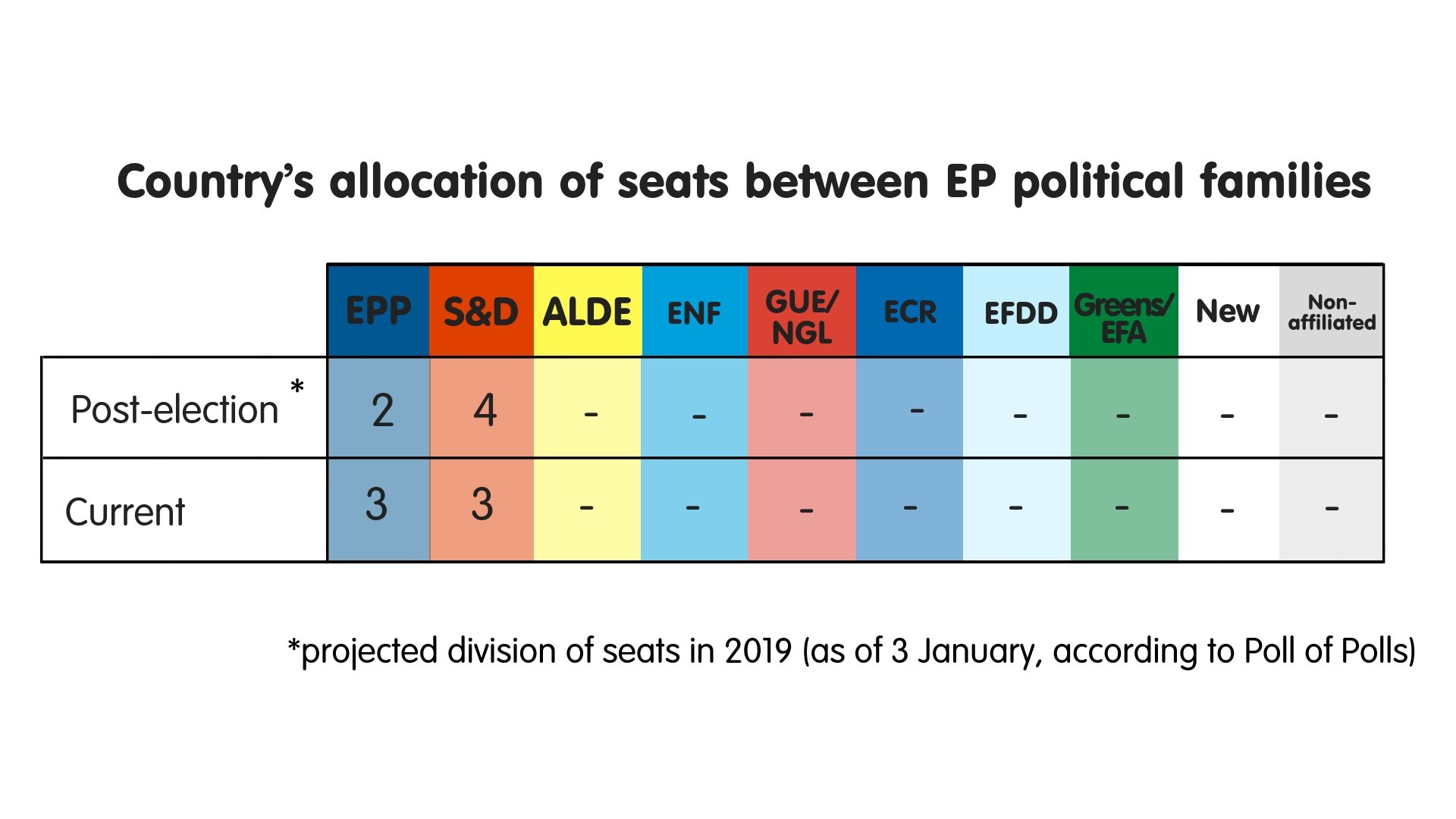
Projected voter turnout
Malta is one of the rare spots on the European map where EP elections generate substantial debate. In all three elections since its 2004 accession to the EU, Malta has had the highest turnout of any member state aside from those that have compulsory voting. Still, turnout has been in steady decline, from 82 percent in 2004 to 75 percent in 2014. Its level this year should be comparable to that in the 2014 election, given the salience of European issues – such as the regulation of financial services, corruption, the rule of law, and irregular migration – in the Maltese political debate. The EP election will also coincide with local council elections. High turnout should benefit the ruling centre-left Labour Party, which draws much of its support from relatively poor southern Malta.
Main battles in 2019
Government corruption and money-laundering will likely be the major topics of the 2019 EP election. This is largely because the EP has, in recent years, served as a forum for the country’s two major parties – Labour and the Nationalist Party – to accuse each other of corruption. After the Panama Papers revelations and the assassination by car bomb of investigative journalist Daphne Caruana Galizia, Nationalist MEPs called on the government to resign. But evidence of the government’s alleged involvement in the corruption scandal later turned out to be falsified. Beyond domestic problems, irregular migration is likely to feature prominently in the debate, largely due to Nationalist leader Adrian Delia’s frequent use of anti-immigrant rhetoric.
The mainstream
Two pro-European parties – the Nationalist Party (a member of the European People’s Party) and the Labour Party (a member of the Socialists and Democrats) – dominate the Maltese political scene. Indeed, they are the only parties to have ever won MEP seats. They currently have three each. No other party stands a chance in the 2019 EP election unless it is allied with one of them. During the 2017 national election, the Democratic Party joined a coalition with the Nationalist Party, but such a scenario is unlikely this year due to resistance from the latter’s new leadership. As a result, the Democratic Party, together with the far-left Democratic Alternative, may sap votes from the Nationalist Party, thus granting Labour an even greater advantage. Labour is expecting to win four MEPs in 2019, with the Nationalist Party winning the remaining two.
The Eurosceptics
Malta has two far-right parties: Imperium Europa and Moviment Patrijotti Maltin. However, neither stands a chance of entering the EP. Likewise, it is highly unlikely that the centre-right Nationalist Party would countenance a coalition with either of them. Democratic Alternative is the only far-left party in Malta. It builds its platform primarily on environmental issues. With the support of around 3 percent of the electorate, it has never entered the national parliament or the EP. The extreme nationalist and xenophobic rhetoric of Malta’s far-right parties is anathema to the progressive supporters of Democratic Alternative.
Netherlands

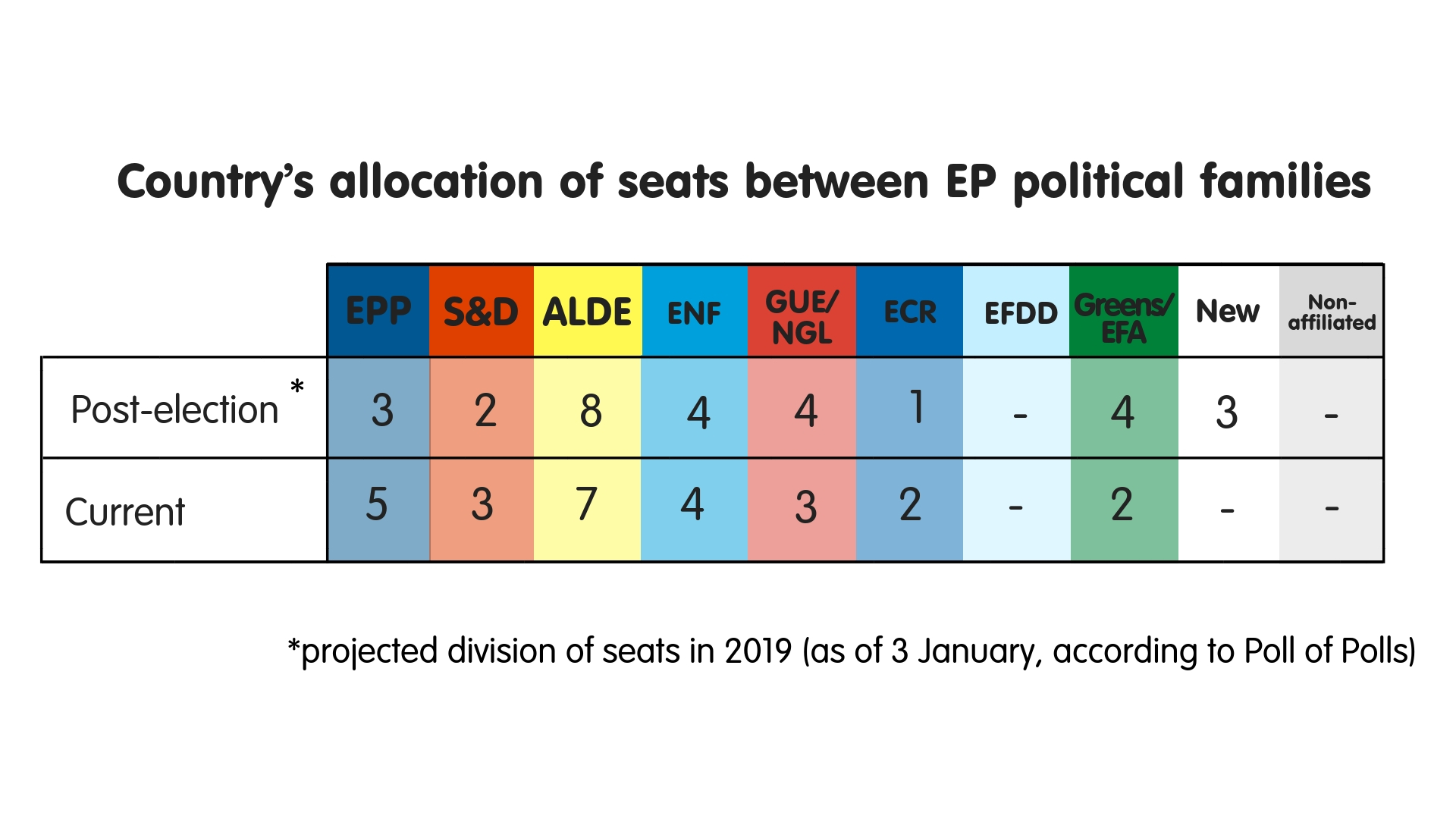
Projected voter turnout
Among the six founding members of the EU, the Netherlands has always had the lowest turnout in EP elections. There are reasons to expect a slight increase in turnout this year in comparison to 2014, when it stood at 37.3 percent: EU issues, particularly migration, have become central to Dutch political debate since then due to the rise of right-wing political parties that are critical of the EU. Besides, as a member of the eurozone and a net payer into the EU budget, the Dutch have been carefully watching the EU’s struggles in the eurozone crisis. They will be paying close attention to the negotiation of the EU’s post-2020 Multiannual Financial Framework. Still, the EP election may also be overshadowed by regional elections planned for spring 2019.
Main battles in 2019
The EP election will encompass issues that are salient in the Dutch political debate such as migration policy, security, the country’s contribution to the EU budget, and the power of Brussels vis-à-vis member states. The main dividing line may set pragmatically pro-European parties – conservative liberals and Christian Democrats, pro-European progressive liberals, and green leftists – against Eurosceptics on both sides of the political spectrum, particularly those on the far right that take up openly anti-EU positions and call for the Netherlands to leave the EU.
The mainstream
Conservative liberals from Prime Minister Mark Rutte’s People’s Party for Freedom and Democracy (VVD) are currently the leading force on the Netherlands’ diverse political scene. A member of the ALDE grouping, VVD is projected to win at least six MEP seats in 2019, doubling its current tally. In October 2018, Rutte and French President Emmanuel Macron announced plans to form a unified liberal front ahead of the EP election. Still, while pro-European and pro-trade, Rutte’s conservative liberals are reluctant to increase legal pathways for migration to the EU. Under his government, the Netherlands is a leading member of the so-called “New Hanseatic League” of fiscally conservative northern EU member states. The VVD is campaigning for a smaller EU budget after Brexit. This puts it at odds with Macron’s and German Chancellor Angela Merkel’s plans for greater eurozone integration. A few other parties in the Dutch mainstream – such as the Christian Democrats, the progressive liberal D66 party, and the Labour Party –may win 7-8 seats collectively.
The Eurosceptics
There are two right-wing nationalist parties in the Netherlands: Geert Wilders’s Party for Freedom, which is currently polling in second place (with 20 percent of the vote) and could secure four or five seats; and Thierry Baudet’s Forum for Democracy, which may obtain two seats. Both parties are strongly Eurosceptic, calling for the Netherlands to leave the EU, but they compete for the same voters. The Dutch far left also consists of two main parties: the pro-European Green Left, which is currently polling in third place (with 17 percent) and could win four seats; and the Socialist Party, which is critical of the EU and may win two seats. While all four parties oppose trade liberalisation, there is little chance they will cooperate with one another – most of all because the far right wants to dismantle the EU while the Socialist Party only seeks reduced EU integration.
Poland
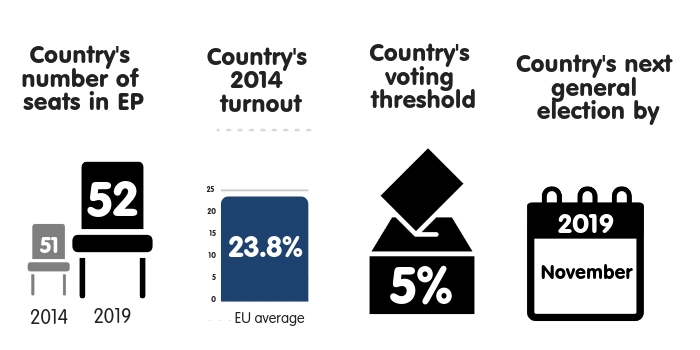
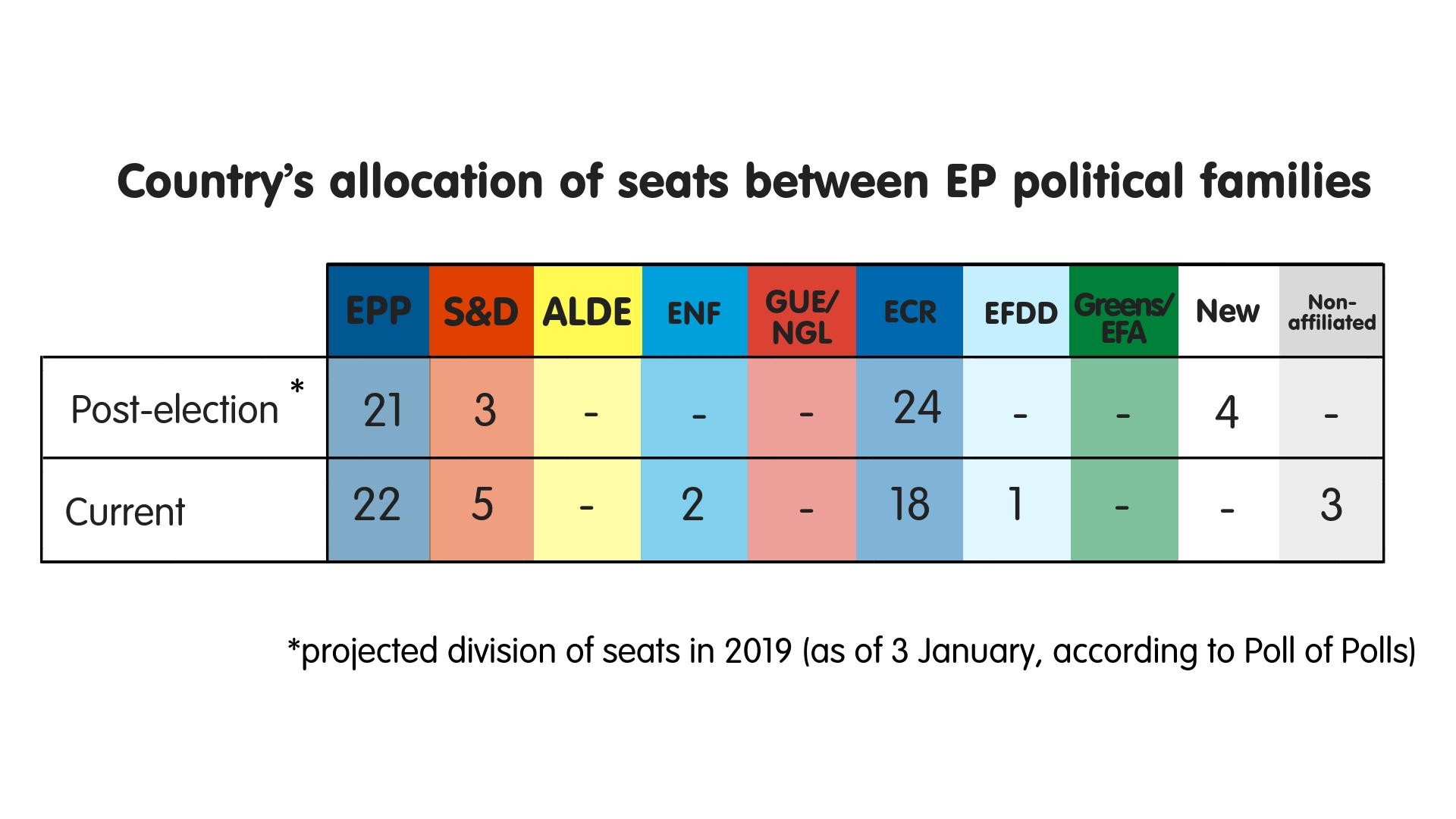
Projected voter turnout
Each of the three times Poles have voted in EP elections, turnout has been at one of the lowest levels in the EU, never exceeding 25 percent. This time, turnout should be higher – perhaps more than 30 percent. European issues have recently become central to the public debate in Poland due to rising tension between the government and EU institutions over the rule of law. The EP vote will take place just a couple of months before a crucial parliamentary election, and a year before the presidential poll. An unusually high turnout should favour both of Poland’s largest parties, the ruling Law and Justice (PiS) and the rival Civic Platform (PO) – especially the latter, given its strength in big cities (which was confirmed by the results of regional elections in October 2018).
Main battles in 2019
In Poland’s main electoral battle, PO may cooperate with other parties in the pro-European opposition, such as liberals (Nowoczesna) and the Polish People’s Party (PSL). Given the government’s conflict with Brussels and a growing sense that Poland is becoming marginalised within the EU, the pro-European opposition will try to frame the upcoming EP election as a de facto referendum on Poland’s membership of the EU. It may also present PiS as anti-EU, in the hope of rallying support from a generally pro-European society and thus strengthening its position ahead of the general election. The opposition may flag the threat of Poland accidentally leaving the EU. PiS thus faces a dilemma. It already tries to soften its image by drawing attention to the country’s economic success. But, at some stage, it may try to radicalise the campaign by underlining the importance of national sovereignty, defending Polish interests against alleged Franco-German domination, and presenting itself as the only real guarantee that Poland will not be overwhelmed by Muslim immigrants. The European Court of Justice is likely to rule before the election that Poland is in breach of the rule of law, which could affect both the campaign and the results.
The mainstream
Both PiS, a member of the European Conservatives and Reformists group (ECR), and PO, a member of the European People’s Party, form part of Poland’s political mainstream. The mainstream also includes the PSL, another member of the EPP, and the liberal Nowoczesna, a member of the liberal ALDE grouping. Both these parties cooperate closely with PO as part of the pro-European opposition. There is currently no left or centre-left party in the Polish parliament. Still, the Alliance of the Democratic Left may win as many as three MEP seats in 2019. Meanwhile, Robert Biedroń – a left-liberal former MEP, mayor of Slupsk, and a self-styled “Polish Macron” – launched new party Wiosna (Spring) in early February 2019. According to some polls, Wiosna is projected to come third in the EP election, with more than ten percent of votes.
The Eurosceptics
PiS is currently the most important soft Eurosceptic party in Poland. PiS politicians present themselves as “EU realists” but they would like to seriously shift European integration back in the name of national sovereignty. Thus, the party’s mild Euroscepticism goes far beyond tension with Brussels over the rule of law. After the 2019 election, given the uncertain future of the ECR group, the party’s 24 or so MEPs may play an important role in the realignment of the nationalist camp in the EP. But several hotly debated corruption scandals involving PiS politicians may harm the party’s performance in the EP election. The much smaller but more ideologically engaged, anti-establishment, and the anti-migration Kukiz’15 (which has recently been in touch with Italy’s Five Star Movement) may also win four or five MEP seats. Other radical right parties (including Liberty, a member of the Europe of Freedom and Direct Democracy group) are trying to create a common list, which may enable them to pass the threshold for representation in the EP.
Portugal


Projected voter turnout
While the Portuguese tend to be more enthusiastic about the European project than most other Europeans, voter turnout in EP elections is relatively low and declining in Portugal, from 40 percent in 1999 to just under 34 percent in 2014. The 2019 EP vote will take place just four months before the country’s quadrennial legislative election, which should lead to a slight increase in turnout. However, if the 2019 EP election become something of a rehearsal for the national electoral contest, the campaign will focus on national issues. This may be even more likely given that European issues create little political polarisation in Portugal.
Main battles in 2019
Eurozone issues, the structure of the EU’s post-2020 Multiannual Financial Framework, and the EU’s global role should feature in the 2019 EP debate in Portugal – but they will mostly be discussed in relation to national politics. Environmental issues and Portugal’s economic growth will also be of interest, especially for left-wing parties. Immigration is unlikely to be a central issue, as there is a strong domestic political consensus that Portugal must receive and integrate migrants.
The mainstream
In contrast to most countries in the EU’s south, Portugal has not seen a radical change in the structure of its political system in the aftermath of the eurozone crisis. Two parties dominate the political system: the Socialist Party, which is centre-left and a member of the Socialists and Democrats in the EP; and the Social Democratic Party, which is centre-right and a member of the European People’s Party in the EP. They poll at around 36-39 percent and 17-20 percent of the vote respectively. This should provide them with ten and six MEP seats respectively. They share a significant pro-European consensus, including on trade, migration, and the rule of law. However, in the last general election, held in 2015, the Socialist Party reached an unprecedented agreement with far-left parties to sustain a parliamentary alliance, breaking its 40-year practice of not allying with parties to its left. Another mainstream party that should win 2-3 MEP seats this year is the conservative People’s Party (CDS), which, unlike in the 2014 EP election, will run separately from the Social Democratic Party.
The Eurosceptics
Because it experienced many decades of authoritarian rule, Portugal has no far right. Having flirted with Euroscepticism in the mid-1990s, CDS has now firmly abandoned it and is committed to a pro-EU agenda and to the defence of transatlantic relations. Portugal has two far-left parties that are strongly critical of the EU: the Portuguese Communist Party and the Left Bloc. Both are members of European United Left–Nordic Green Left group in the EP; they are projected to win 2-3 and 1-2 MEP seats each. Left Bloc is seen as a “new left” party, similar to Spain’s Podemos or Greece’s Syriza, in its criticism of capitalism and of bureaucratic procedures that restrict popular participation. At the same time, however, both are strong opponents of racism as well as of a xenophobic and nationalist narrative in the EU, making them improbable partners for the EU’s far right in Brussels and Strasbourg.
Romania

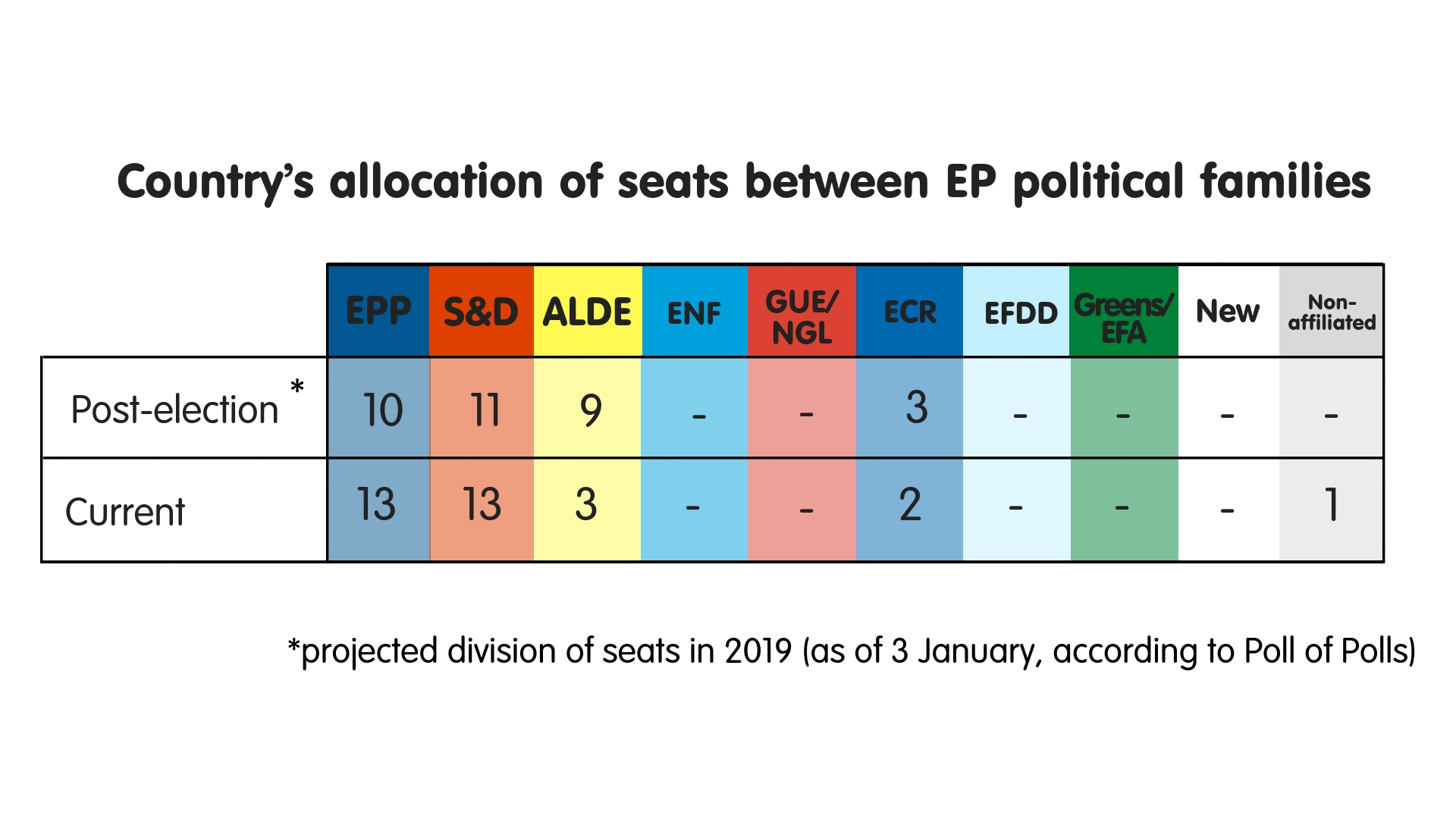
Projected voter turnout
Romanians have voted in EP elections on three occasions, with voter turnout usually standing at around 30 percent. There are two major reasons to expect a slight increase in turnout in 2019. Firstly, Romania has received growing criticism from EU institutions for its approach to tackling corruption, and for its similarities with Poland and Hungary on rule of law issues. For Romanian voters, the 2019 EP election will be the first opportunity they have had since 2016 to vote on their dissatisfaction with high levels of political corruption. Another issue that could boost turnout is Romania’s presidency of the Council of the EU in the first half of 2019 (which will involve an informal summit in Sibiu on the future of the EU, scheduled for two weeks before European voters go to the polls).
Main battles in 2019
The fight against political corruption will become the central issue in the EP campaign in Romania, alongside the power struggle between Romania’s government and its judiciary. Other topics of concern are youth unemployment, human rights, and social protections for EU citizens. Some parts of Romania will be more interested in a common agricultural policy or immigration issues (especially those close to the border with Serbia). However, migration will not be a salient issue. Romania has experienced no significant permanent influx of refugees, despite being a transit country for immigrants travelling to western Europe. Its citizens are also more open to migration from outside Europe than the EU average, because they often associate this topic with their freedom of movement. Romania has seen the biggest rise in emigration of any EU member state since 1990, according to the World Bank.
The mainstream
Romania’s two main political parties are the ruling Social Democratic Party (PSD; a member of the Socialists and Democrats), and the centre-right National Liberal Party (member of the European People’s Party). They currently poll at 29 percent and 22 percent respectively, which should provide them with around 11 MEPs each. However, despite being a pro-European mainstream party, the PSD is also deeply “Orbánised” on sovereignty and identity issues, catering to the country’s prevailing authoritarian social values. It has also lately faced major integrity issues, which led to a decline in its popularity. The country’s centre includes the Alliance of Liberals and Democrats, which is polling at 10 percent and is expecting four MEPs. Two new pro-European centre-right parties – Dacian Ciolos’s Romania Together Movement and the Save Romania Union – are projected to win two or three MEP seats each, or possibly more if they form a coalition. Pro Romania, a social-democratic party led by former prime minister Victor Ponta and affiliated with the European Conservatives and Reformists, may also win 2-3 MEP seats.
The Eurosceptics
There are no significant strong far-right parties in Romania. The leaders of the two most prominent ones – the Greater Romania Party and Noua Dreapta – do not appeal to most of the electorate. This is largely because far-right political groups formed part of the government, or ran large municipalities, during the economic catastrophe of the early post-communist years. The Romanian Socialist Party is the country’s most powerful far-left party: it won 34 local seats in 2013 but has been on the decline since. In this context, Romania has a bigger problem with populism in the mainstream than outside it.
Slovakia
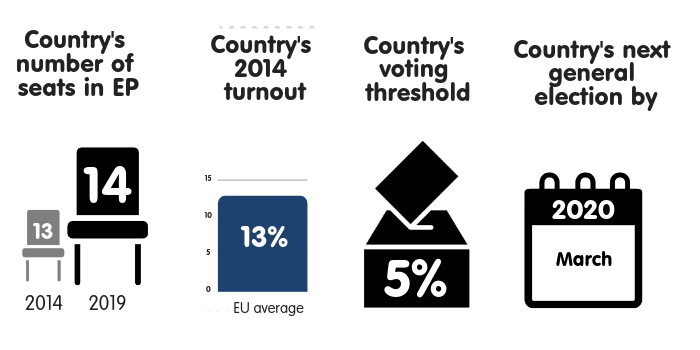
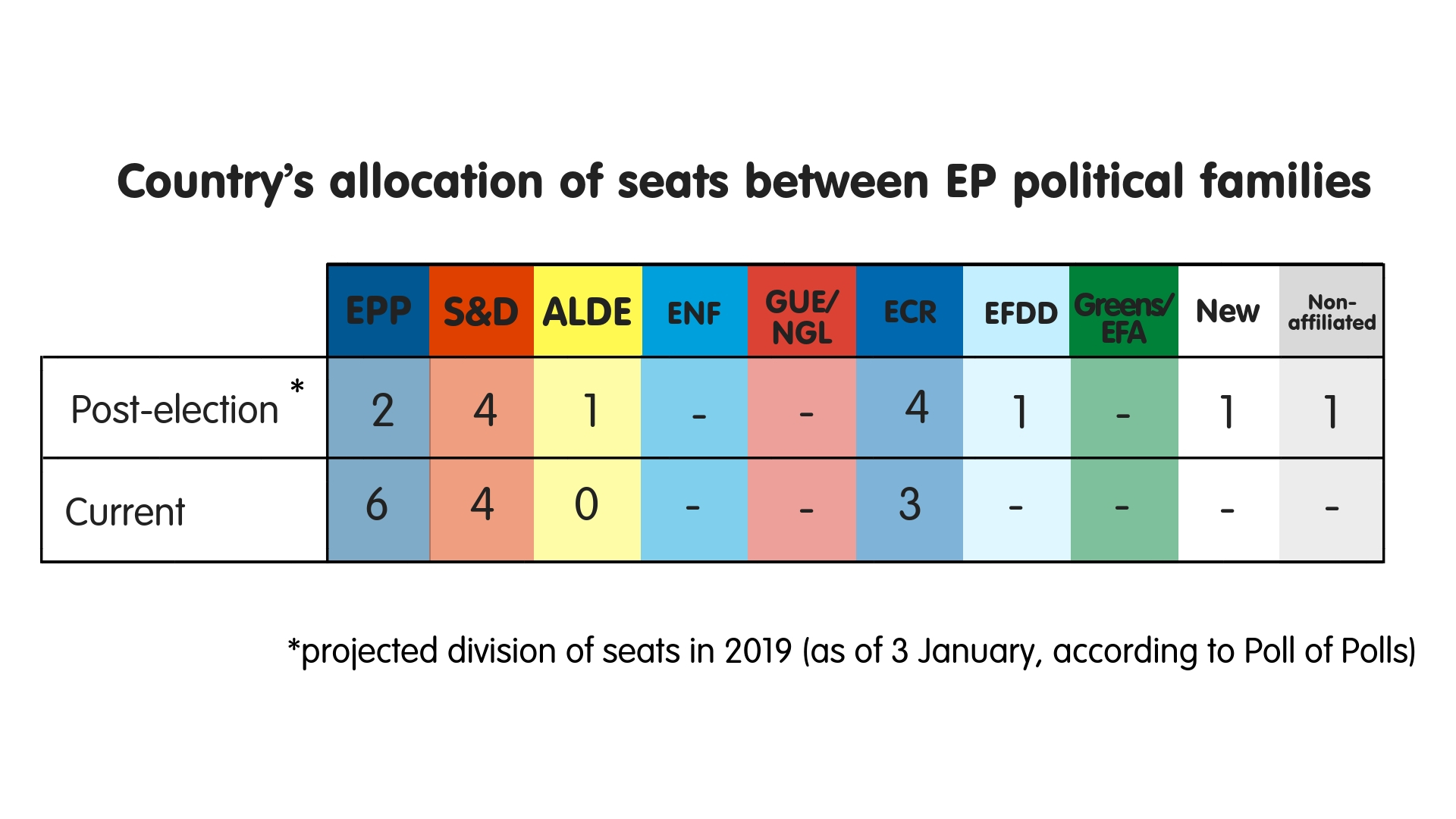
Projected voter turnout
On all three occasions when Slovaks have voted in EP elections, the country has had the lowest turnout in the EU. Having never exceeded 20 percent, turnout reached an all-time low of 13 percent in 2014. This trend could easily lead to unusual results in 2019 – perhaps benefiting right-wing parties, whose supporters are relatively active in politics. If these parties succeed in framing migration as the main topic of the campaign, even more of their voters could go to the polls – perhaps pushing turnout above 20 percent. However, there is also a risk that, by the time of the EP election, voters will be tired of their trips to the polling station, having turned out for local elections in November 2018 and the presidential election in March 2019 (both of which they treat as more important than EP elections).
Main battles in 2019
The Slovak public does not debate European issues – apart from migration – to any significant extent. As a result, right and far-right parties are almost certain to focus on migration and security. They will seek to raise the issue of member states’ sovereignty vis-à-vis Brussels. Some of them, especially the far-right People’s Party Our Slovakia, will deploy anti-EU and anti-refugee rhetoric. With a clear lead in the polls, the ruling social democrats (SMER-SD) may try to refocus the debate on economic issues, such as eurozone reform and cohesion funds. Like most of its rivals in the country, the party opposes immigration.
The mainstream
The centre-left SMER-SD, led by former prime minister Robert Fico, is the main party in Slovakia. Its deputy leader, Peter Pellegrini, is the current prime minister. The party belongs to the Socialists and Democrats EP group and is likely to win four MEP seats in 2019. It leads a governing coalition that also includes the nationalist Slovak National Party (SNS) – which is close to Italy’s Lega and Poland’s Law and Justice – and the inter-ethnic Most-Hid party, which has the support of much of the country’s ethnic-Hungarian minority. This combination lends a mildly Eurosceptic orientation to the coalition, despite the pro-Europeanism of the social democrats. The country’s centre-right is divided between several parties, including Freedom and Solidarity and the Ordinary People party. Both of these parties are members of the European Conservatives and Reformists in the EP. They are projected to win three and two MEP seats each this year.
The Eurosceptics
People’s Party Our Slovakia, led by Marian Kotleba, is the most influential far-right party in Slovakia, and the only one with a countrywide support. Having obtained more than 8 percent of the vote in the 2016 parliamentary election, it may win one or two MEP seats this year. It has gained in popularity through anti-Roma rhetoric. But it also campaigns against the EU, refugees, NATO, and the establishment. The SNS, the second-strongest partner in the ruling coalition, was formerly considered to be close to the far right but, under the leadership of Andrej Danko, it has recently moved towards the centre-right – while remaining critical of some aspects of European integration.
Slovenia

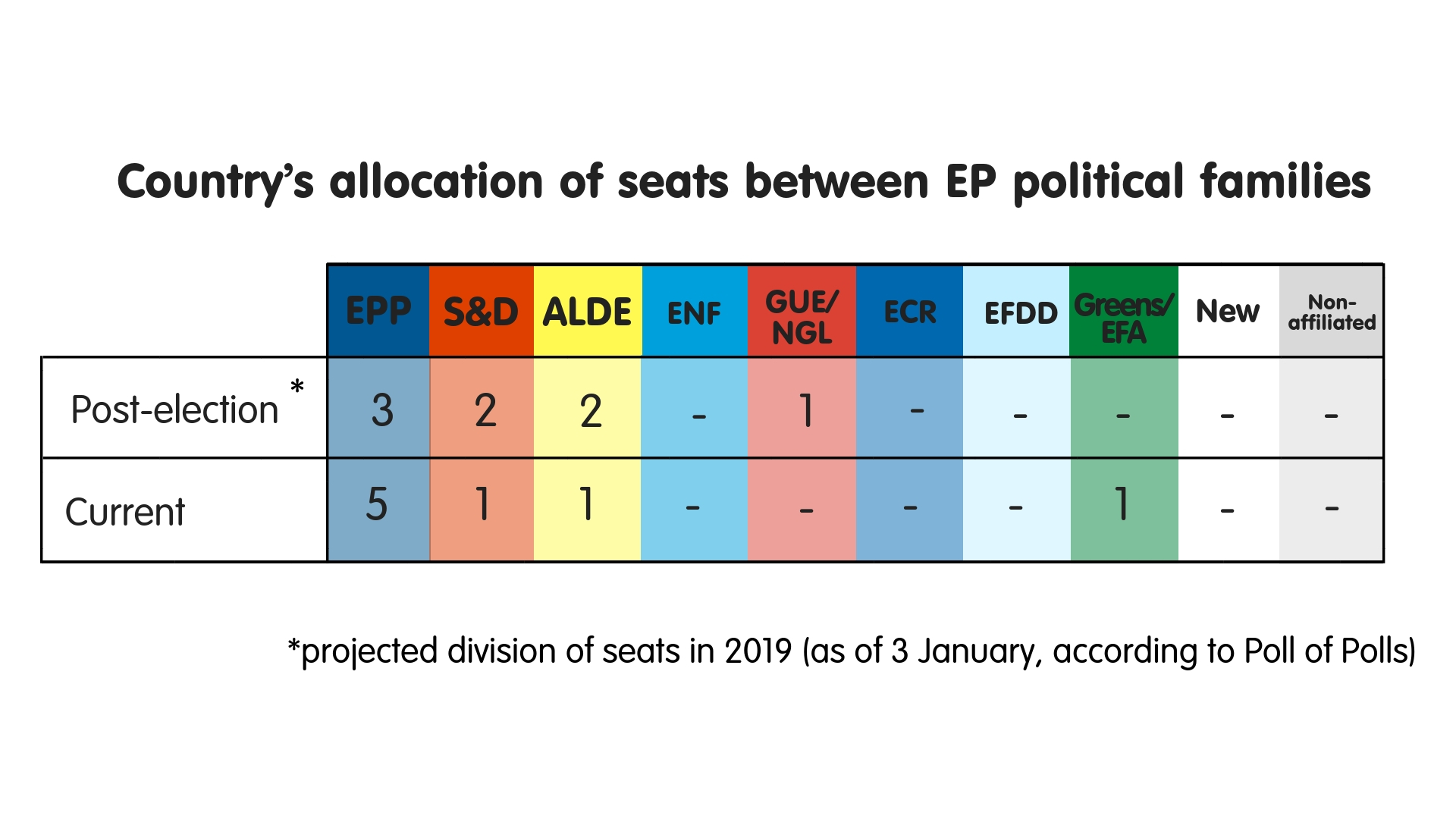
Projected voter turnout
In the 2014 EP election, Slovenia had a turnout of just 24.5 percent, the fourth-lowest in the EU. This is just half of the usual turnout at national parliamentary elections. Slovenians consider Brussels to be distant and abstract, while the low number of MEPs representing the country – just eight – gives voters little confidence that their representatives can have a real impact on the course of EU affairs. Public interest in the EU is usually limited to issues linked to domestic politics, such as European funds or the EU’s role in resolving the Slovenian-Croatian border dispute. But the refugee crisis should have slightly increased this interest. As a result, turnout may rise above 30 percent this year, which would likely benefit pro-European parties.
Main battles in 2019
Regional development, migration, and European values are set to dominate the 2019 EP debate in Slovenia. National conservatives from the Slovenian Democratic Party (SDS) will use the election to campaign against the government’s domestic politics. The SDS dominated the 2018 parliamentary election, only to be kept out of office by a coalition of centre-left parties. The party is likely to refrain from emphasising its current anti-migration orientation to avoid putting off young pro-European voters, many of whom would normally stay at home. In contrast, centre-left parties may concentrate on European values, denouncing the “Orbánisation” of the SDS and framing the vote as a de facto referendum on European integration. The far-left Levica will campaign against the securitisation of the political debate, drawing attention to environmental, humanitarian, and social issues. However, parties in the ruling coalition may have difficulty mobilising young, progressive voters to turn out for, effectively, the government.
The mainstream
Slovenia’s mainstream includes a range of liberal and centre-left parties, five of which formed a pro-European government following the 2018 national parliamentary election. Marjan Šarec leads both the government and catch-all party Lista Marjana Šarca, which is a member of the ALDE group in the EP and is projected to win two MEP seats this year. The Social Democrats may win two MEP seats. Other members of the coalition are too small to have any chance of entering the EP. The liberal Catholic New Slovenia might win one MEP seat in 2019. It is a member of the European People’s Party but has recently moved closer to SDS positions: opposing migration and divided on rule of law issues.
The Eurosceptics
The Slovenian National Party is the only genuine far-right group in the country. However, it polls at just 3 percent and has no prospects of winning any MEP seats this year. Yet the SDS, which has led the polls since 2015, increasingly falls into the category of right-wing populism. It forms part of the European People’s Party but, under the highly divisive leadership of Janez Janša, is moving in the direction of an illiberal ideology reminiscent of Hungarian Prime Minister Viktor Orbán. SDS strongly opposes legal migration into the EU, as well as Brussels’s focus on rule of law issues across Europe. The party is projected to win three MEP seats. Levica is Eurosceptic on some issues, such as monetary union, foreign policy, and security, and pro-European on others, such as social affairs and development. It currently provides parliamentary support to the centre-left coalition and looks set to win one MEP seat.
Spain
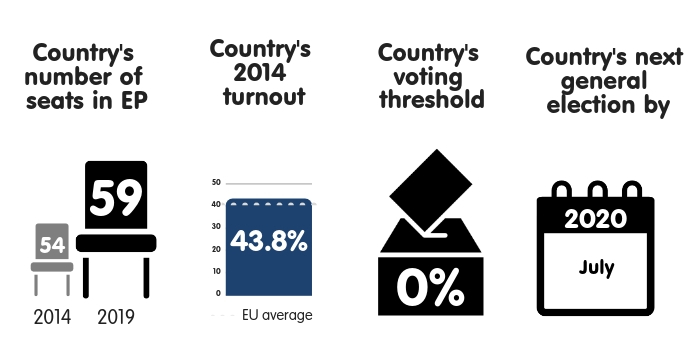
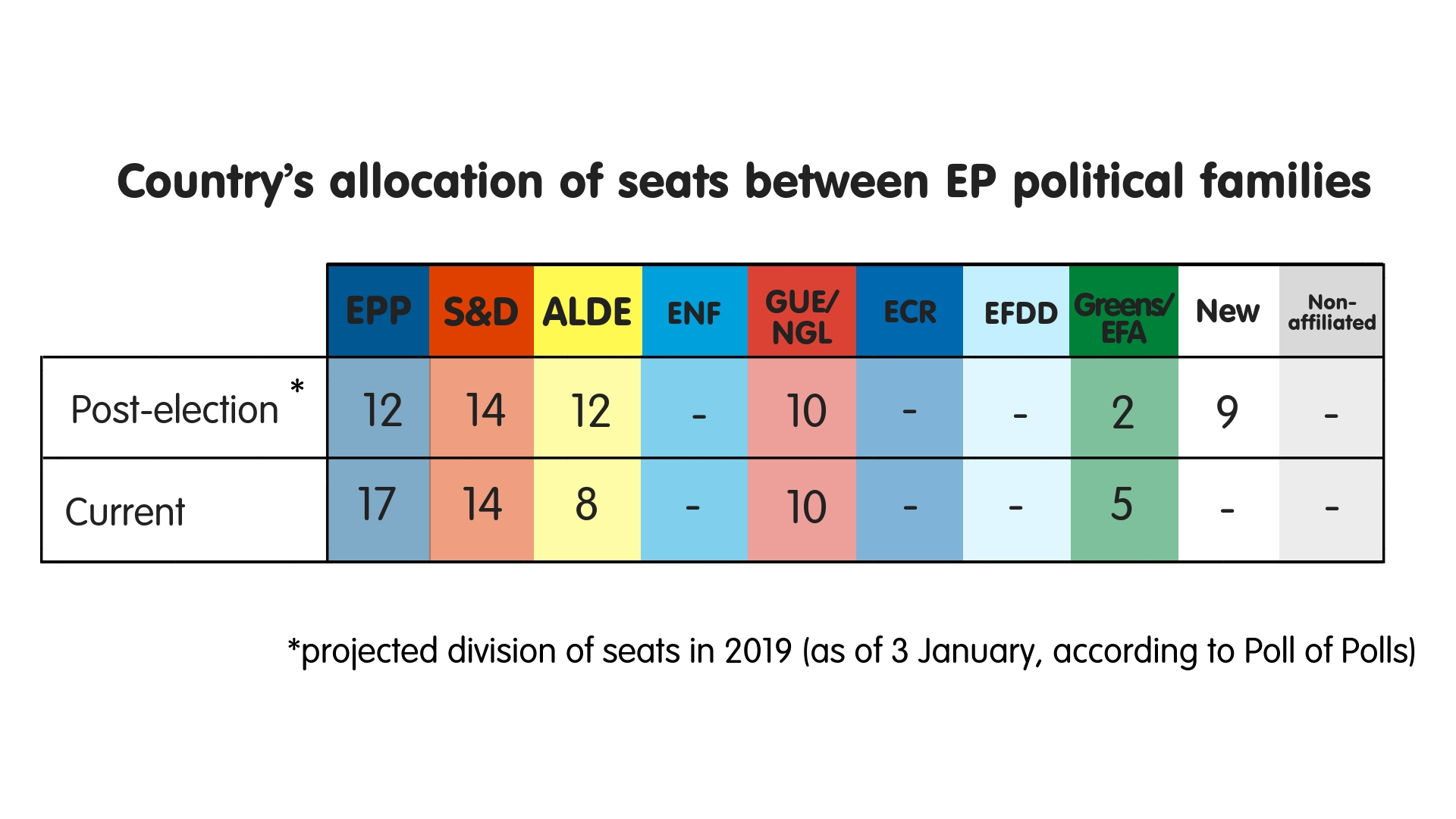
Projected voter turnout
In Spain, EP elections tend to act as second order national elections. They centre on national issues, with Spaniards normally supporting the same parties in both votes. Turnout is usually less than 50 percent; it was 45 percent in 2009 and 44 percent in 2014. However, 2019 may see it rise to as much as 60 percent, for two main reasons. Firstly, local council elections and regional elections will take place on the same day in most parts of the country. And, secondly, the EP election will serve as a test of support for Spain’s main parties. This is especially true given that the country has recently shifted from a two-party system to a four-party one – and that, since 2018, it has been ruled by a minority government, which came into power without a general election. Thus, the stakes are high in this year’s vote, as it may speak to the outcome of the next general election – due to occur by July 2020 at the latest.
Main battles in 2019
Spain is currently in a rather unusual political situation. Following the June 2018 vote of no confidence that removed the prime minister, Mariano Rajoy, then head of the right-wing People’s Party, Socialist Party leader Pedro Sanchez became prime minister. This was only possible with support from anti-austerity and nationalist parties. As a result, the 2019 EP election campaign will likely serve as a mid-term election in which voters have their say on the current government and focus on national issues, including social welfare and immigration – although the latter should be relatively uncontroversial as it is in many other parts of the EU. Meanwhile, Europe is unlikely to be a central issue for Spain in the EP election. Regional and local dynamics will also play an important role, given that local elections are taking place at the same time. Catalonia’s independence crisis will feature prominently if Catalan separatists, counting on support from the EU, try to put the issue at the heart of the debate.
The mainstream
For several decades, two parties dominated Spain’s political mainstream: the People’s Party, which is a member of the European People’s Party EP group, and the Socialist Party, which is a member of the Socialists and Democrats. The right is now fragmented between the People’s Party and Ciudadanos. Polling at around 20 percent each, the parties are projected to win 12 MEP seats this year. They compete for right-wing voters even as they cooperate with each other in parliament. Ciudadanos, a close ally of La République En Marche!, appeals mainly to young voters. The left-wing Podemos constitutes the remainder of the mainstream. Polling at 22-25 percent, the Socialist Party is projected to win 14-16 MEP seats, which could make it one of the two biggest national parties in the Socialists and Democrats, alongside Italy’s Democratic Party. Spain’s mainstream parties are strongly pro-European.
The Eurosceptics
With the unexpected rise of new far-right, anti-EU party Vox in recent months, the Spanish exception to right-wing populism seems to be coming to an end. After its surprisingly strong performance in the December 2018 regional elections, Vox entered parliament and supported the coalition government in Andalusia, which includes the People’s Party and Ciudadanos. Vox could win six or seven MEP seats in May. This would be the second time that a party with no representation in the Spanish national parliament acquired seats in the EP – after Podemos did so in 2014. Podemos itself could increase its number of MEP seats from five to more than ten. However, after securing seats in the national parliament in 2016, Podemos has become more moderate in its ideology and discourse, making it an improbable partner for the far right in the EP.
Sweden

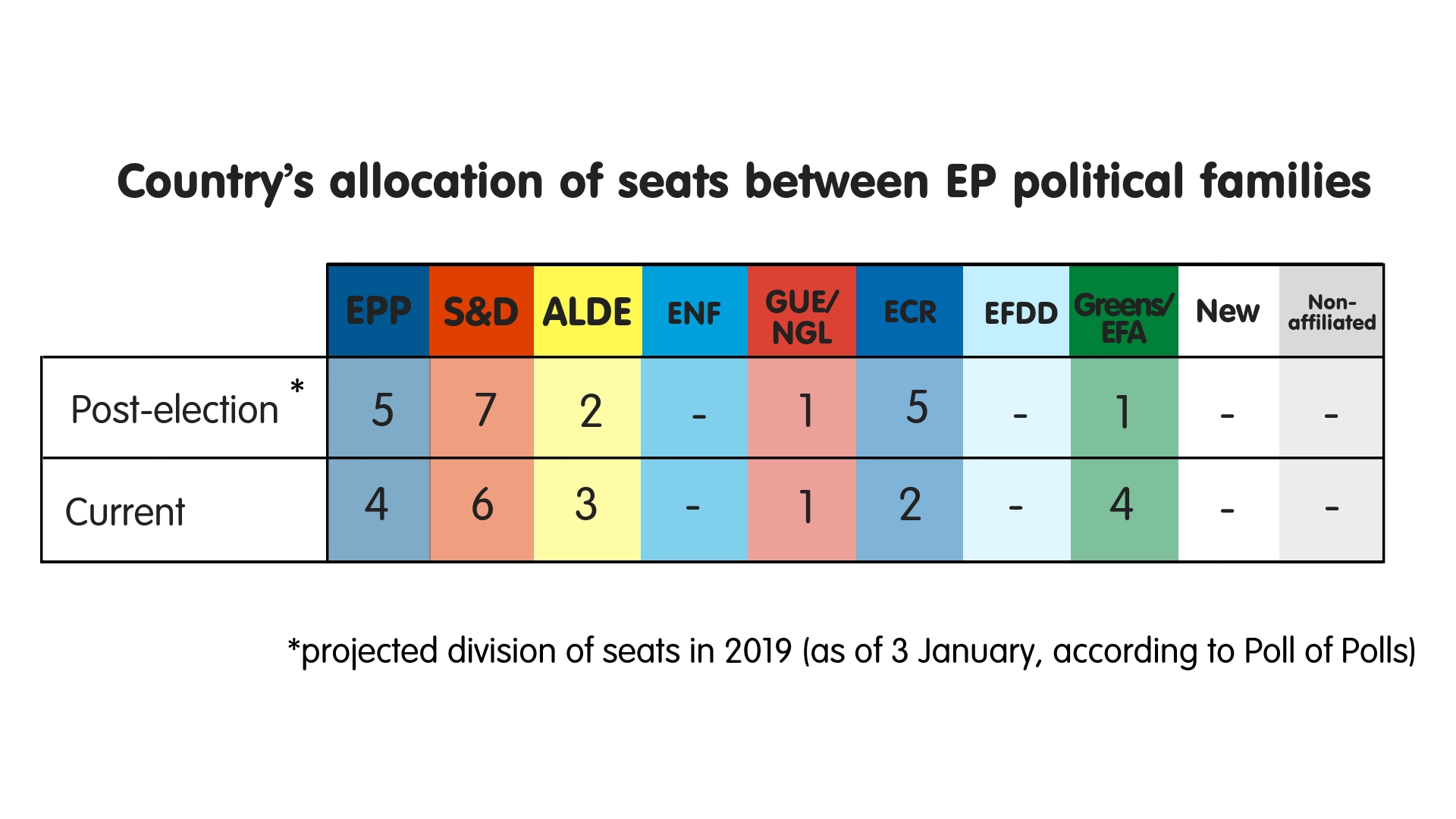
Projected voter turnout
In Sweden, EP elections tend to focus on national rather than European issues, while the average turnout of around 50 percent is much lower than that for parliamentary elections – which usually rises to more than 80 percent. Turnout may be even lower in this year’s EP election, as the public debate is currently dominated by efforts to form a new government after an inconclusive election in September 2018. The Social Democrats and the Green Party eventually formed a new government in January 2019, with the parliamentary backing of the Centre and Liberal parties. Yet there is a risk that voters’ fatigue after long months of government formation talks will affect the EP election. Yet issues such as Brexit, migration, and climate change could boost turnout. Sweden’s two major mainstream parties – the Social Democrats and the Moderates – tend to perform more poorly in EP elections that in general elections. Therefore, low participation may favour non-mainstream parties, including the Eurosceptic and anti-immigration Sweden Democrats, which is polling in second place, with 20 percent of the vote.
Main battles in 2019
In the 2018 general election, migration became the central issue in the public debate. The same thing may happen in the 2019 EP contest. There is strong support among mainstream parties for a European migration system that relocates asylum seekers at the EU level, but the anti-migration Sweden Democrats oppose this. The issue may provoke strong feelings in Sweden, boosting the party’s chances. The Sweden Democrats may even campaign for the country to leave the EU. Meanwhile, pro-European mainstream parties may focus on climate change, human rights, and the EU’s social policies – issues that have traditionally been most important for Swedish voters at EP elections.
The mainstream
The centre-left Social Democrats and the centre-right Moderates – members of the Socialists and Democrats EP group, and the European People’s Party, respectively – lead two traditional coalitions with smaller parties. Both blocs are pro-European: supportive of European values, but with more nuanced positions on migration, trade, and what Brexit means for Sweden’s integration into the EU. However, the 2018 parliamentary election saw a decline in support for the two main parties and a rise in that for the nationalist far right. This has led to prolonged difficulties in forming a new government, and to a split within the centre-right bloc.
The Eurosceptics
The country’s far right is represented by the Sweden Democrats, which belongs to the European Conservatives and Reformists EP group. The party is projected to win 4-5 MEP seats, up from its current two. As the most anti-migration party in Sweden, it has grown in popularity since the 2015 migration crisis. On several occasions, the Sweden Democrats have opposed Swedish EU membership, despite very low levels of support for leaving the union in the population at large. In 2017 some former members of the Sweden Democrats set up Alternativ för Sverige, inspired by Alternative für Deutschland. The new party will field candidates in 2019’s EP election. But there is barely any chance that they will cross the 4 percent threshold. On the other side of the political spectrum, the Left Party has traditionally called for a referendum on Sweden’s EU membership, but it could drop this issue in 2019 to avoid any association with the Sweden Democrats.
The European Council on Foreign Relations does not take collective positions. ECFR publications only represent the views of their individual authors.
